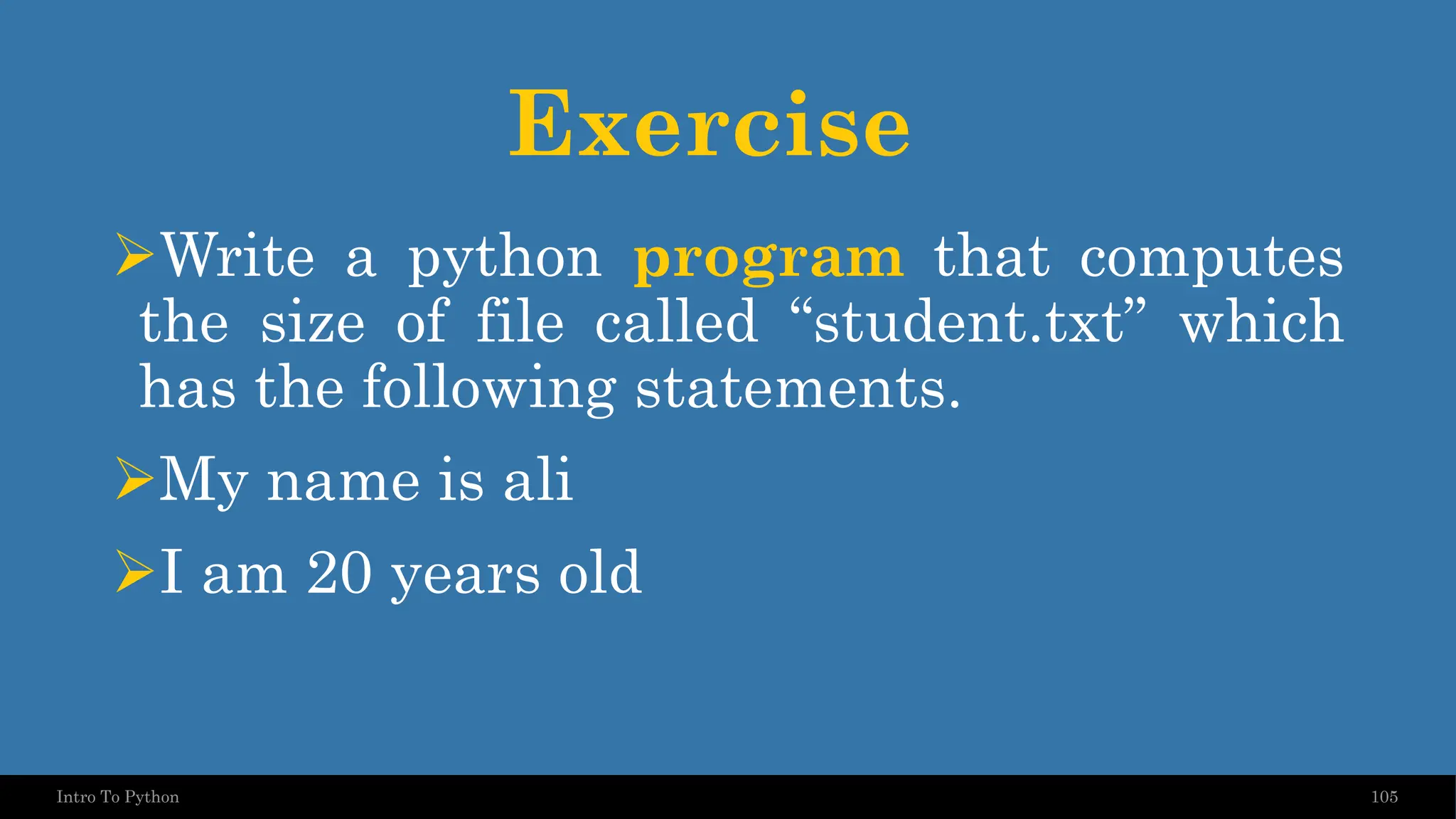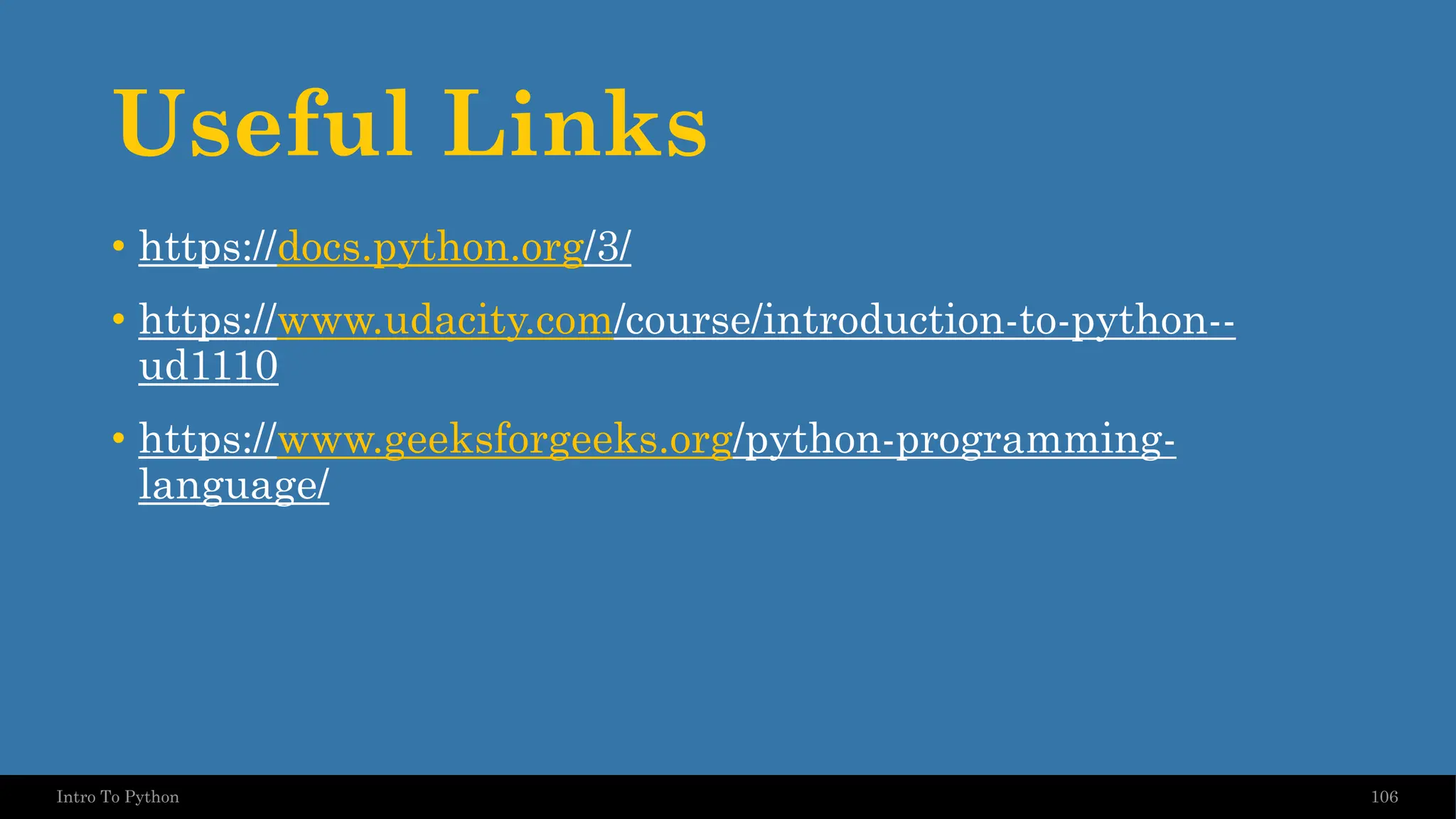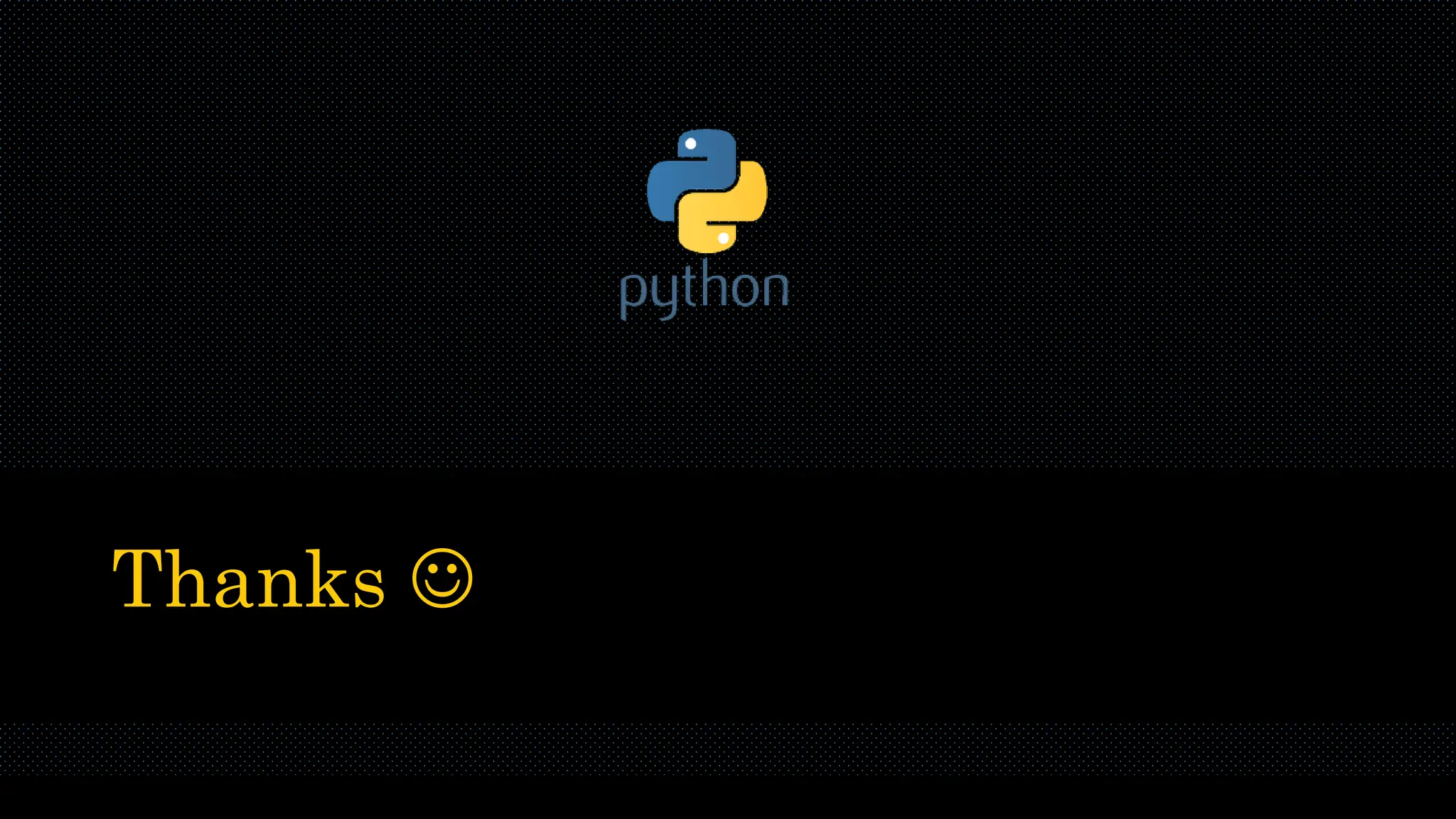The document provides an introduction to Python, covering its history, features, basic syntax, and data types like variables, lists, and tuples. It outlines the language's ease of learning, interactive mode, and versatility for various applications, along with examples of syntax and programming exercises. Key features include object-oriented programming, portability, and a comprehensive standard library.
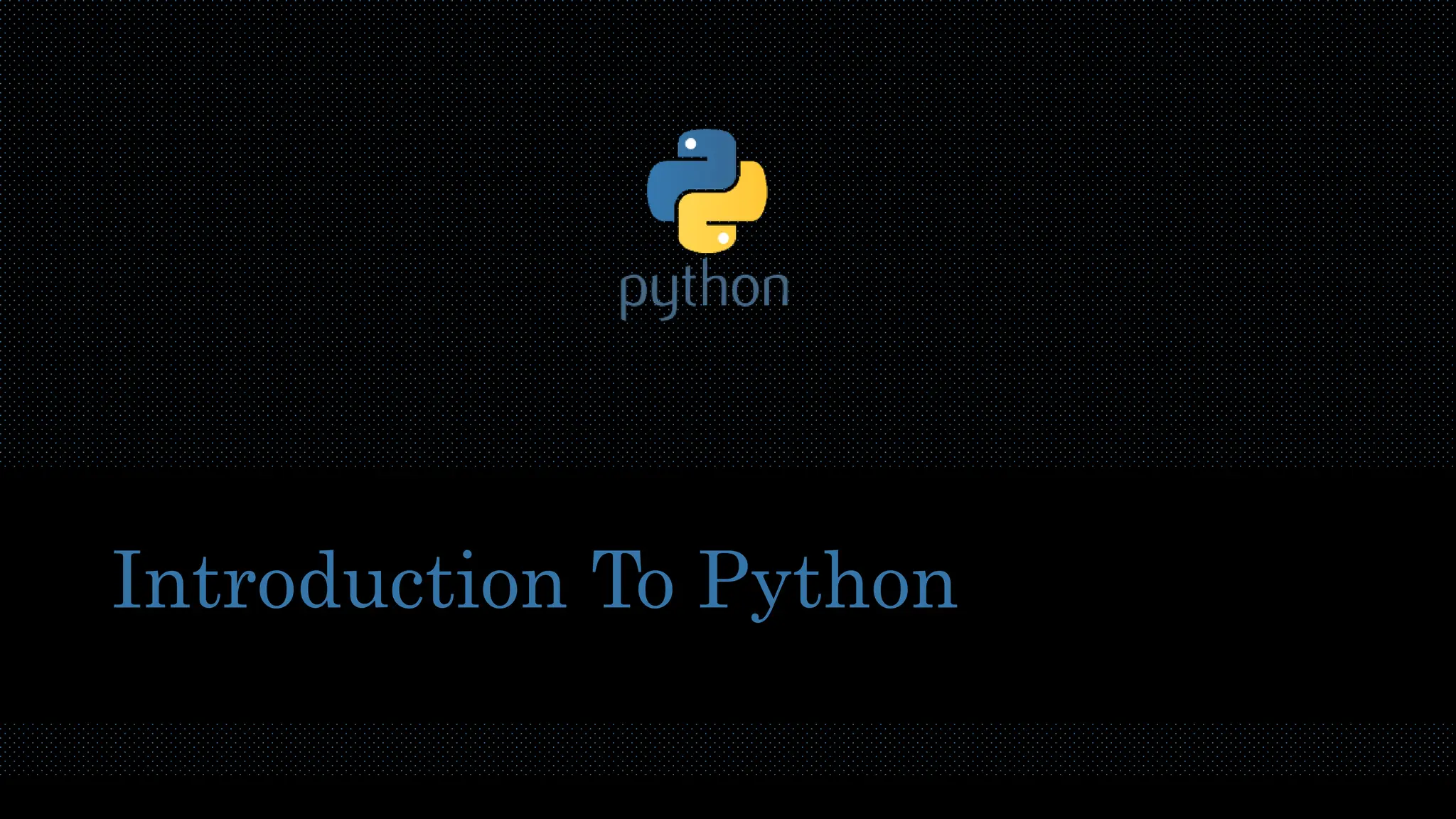
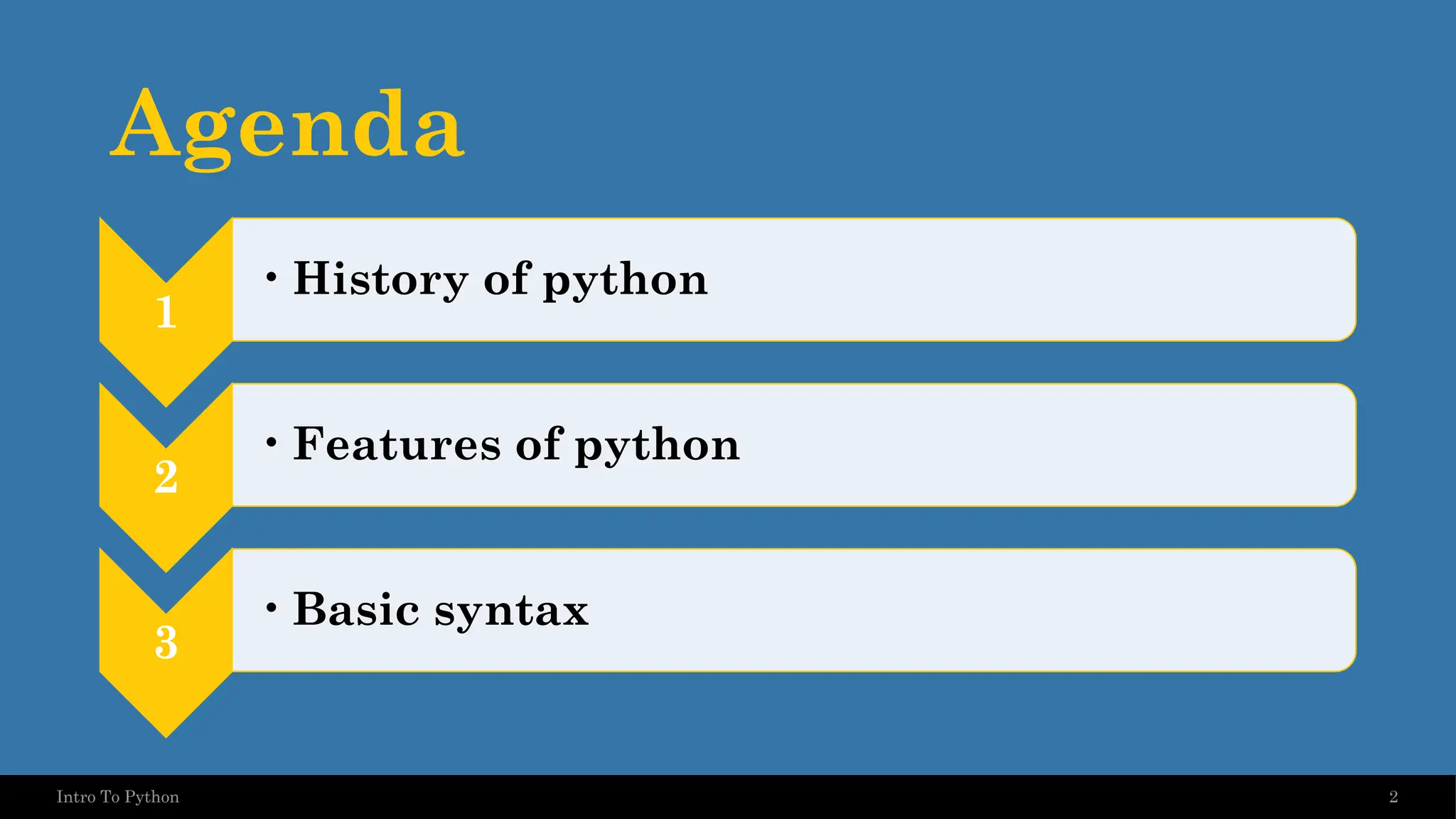
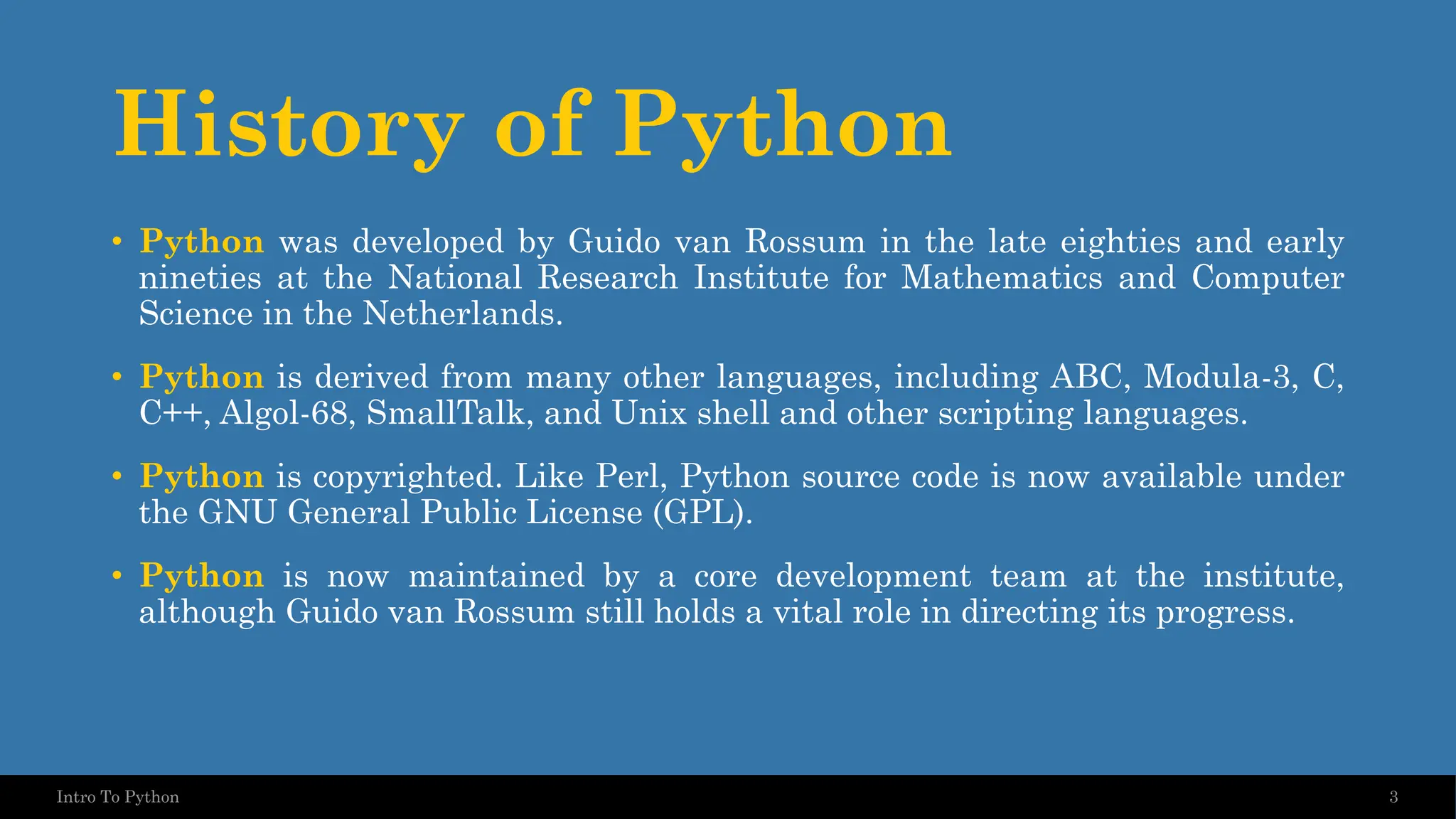
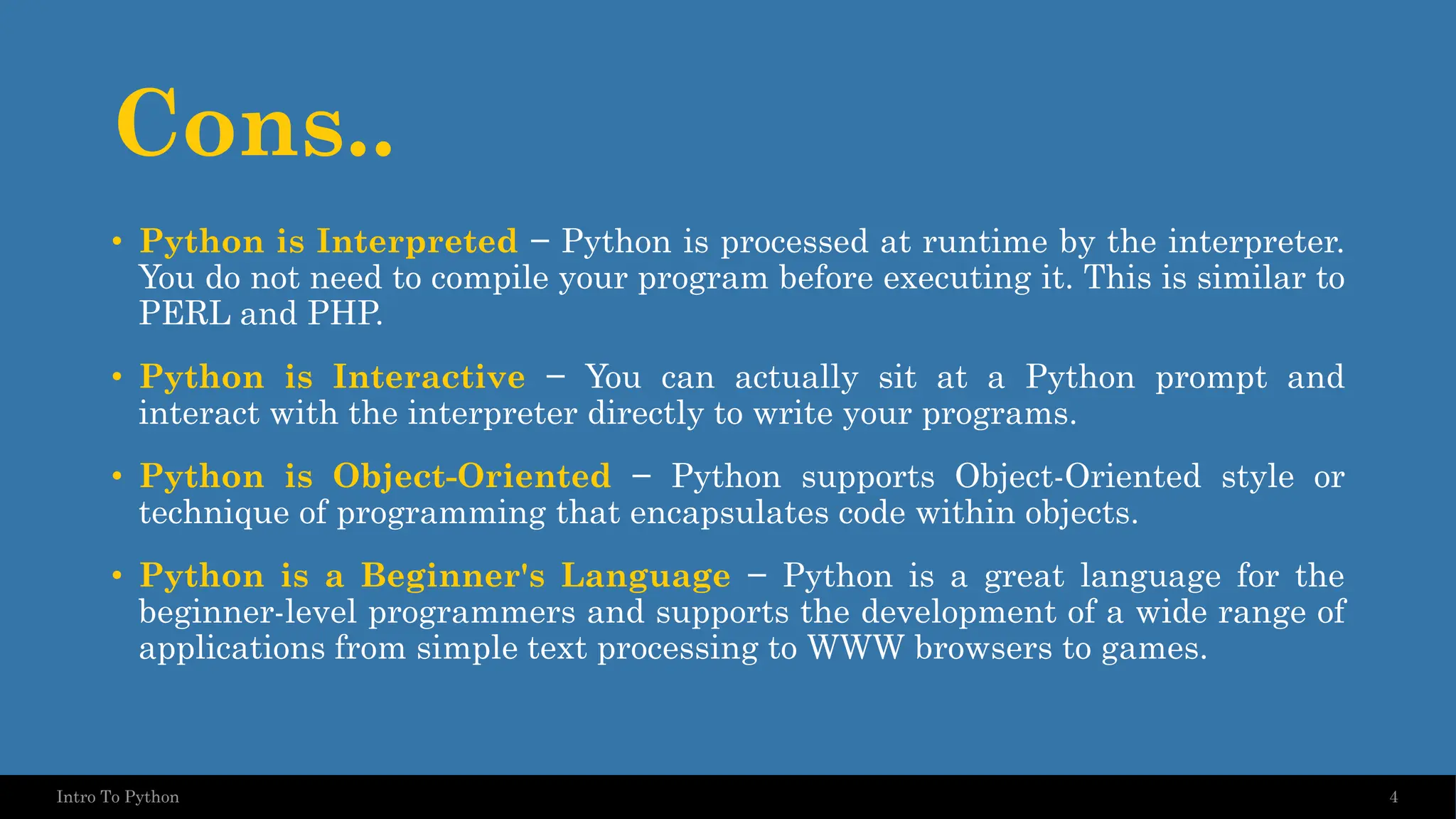
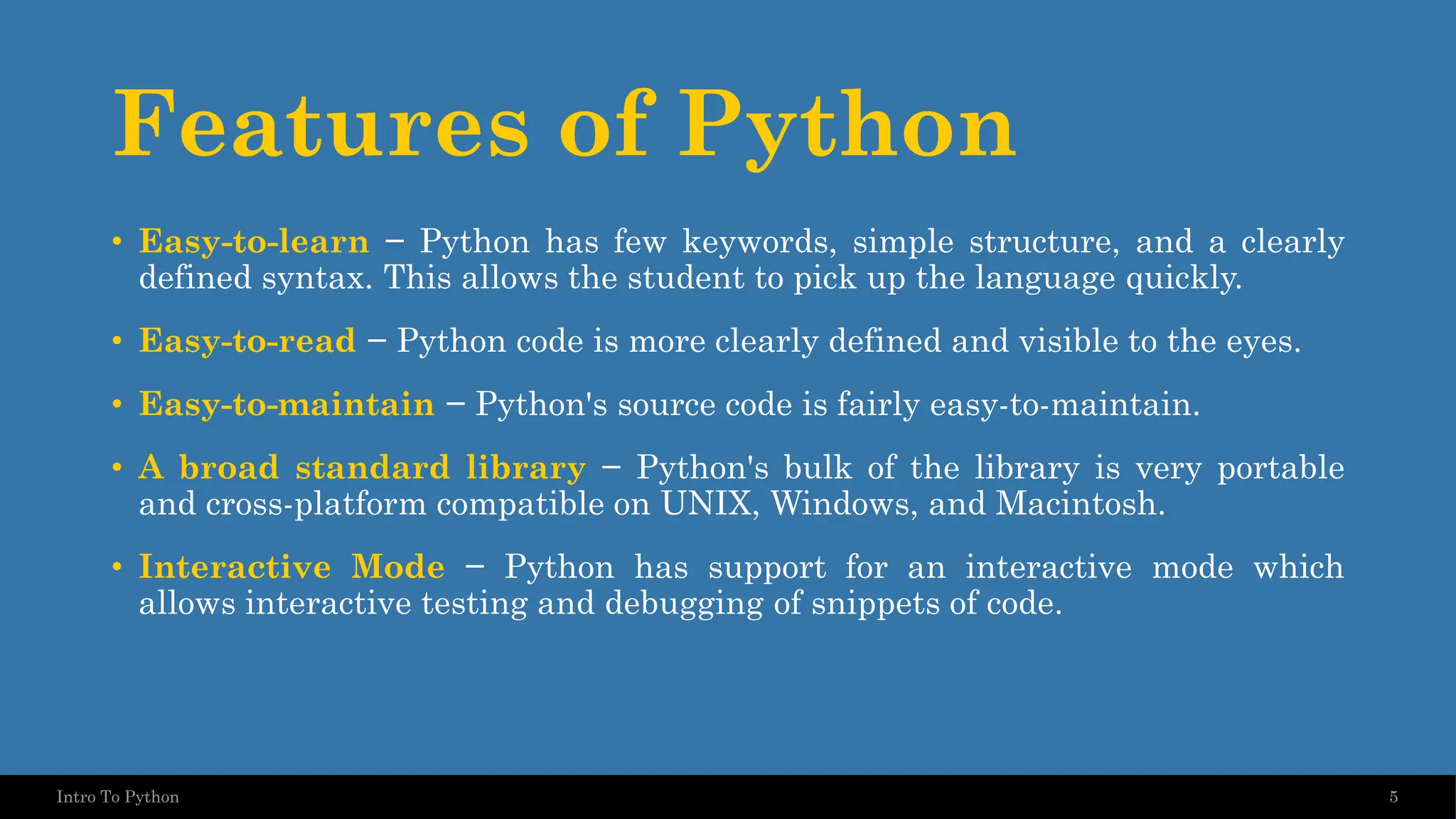
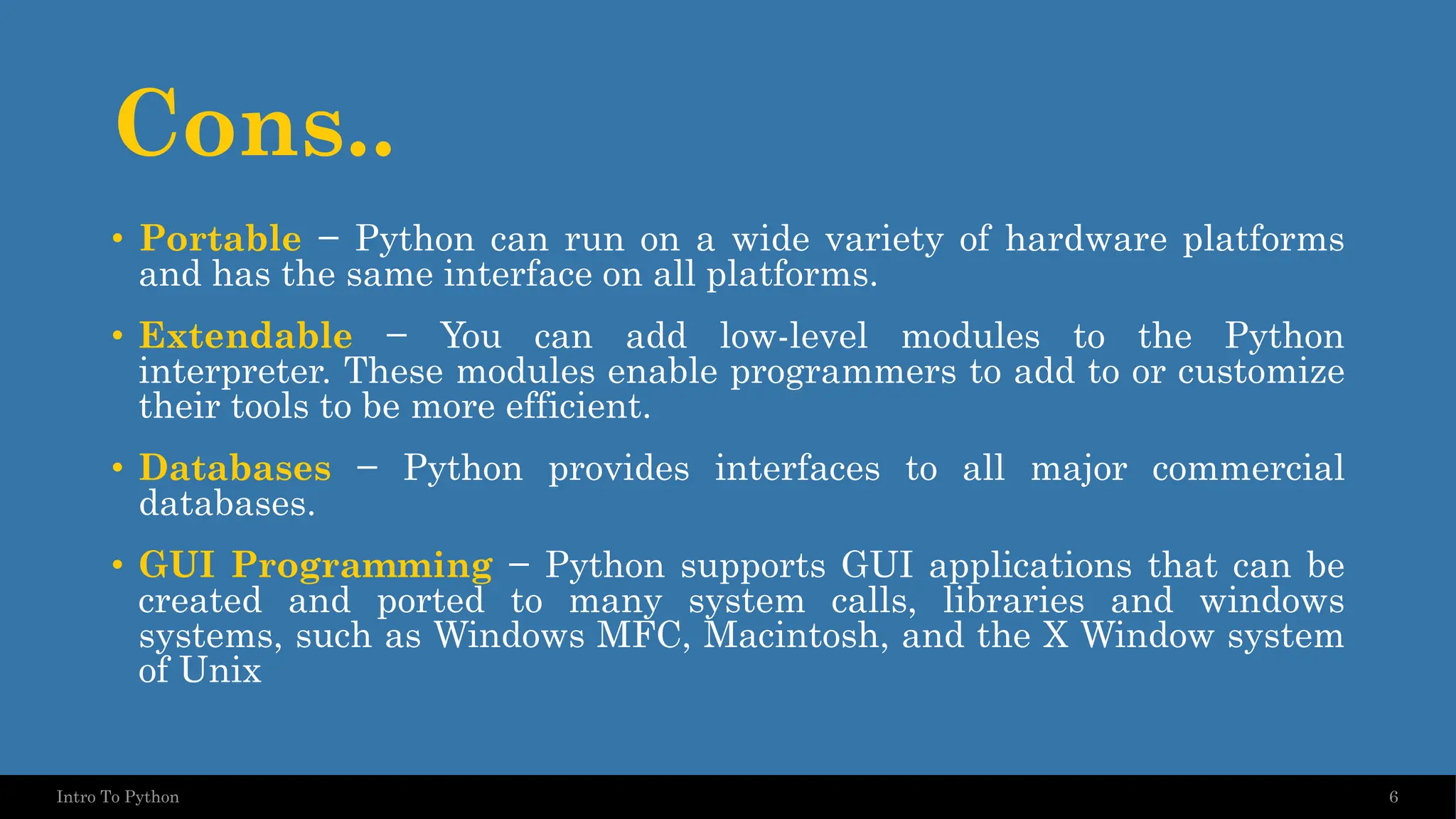
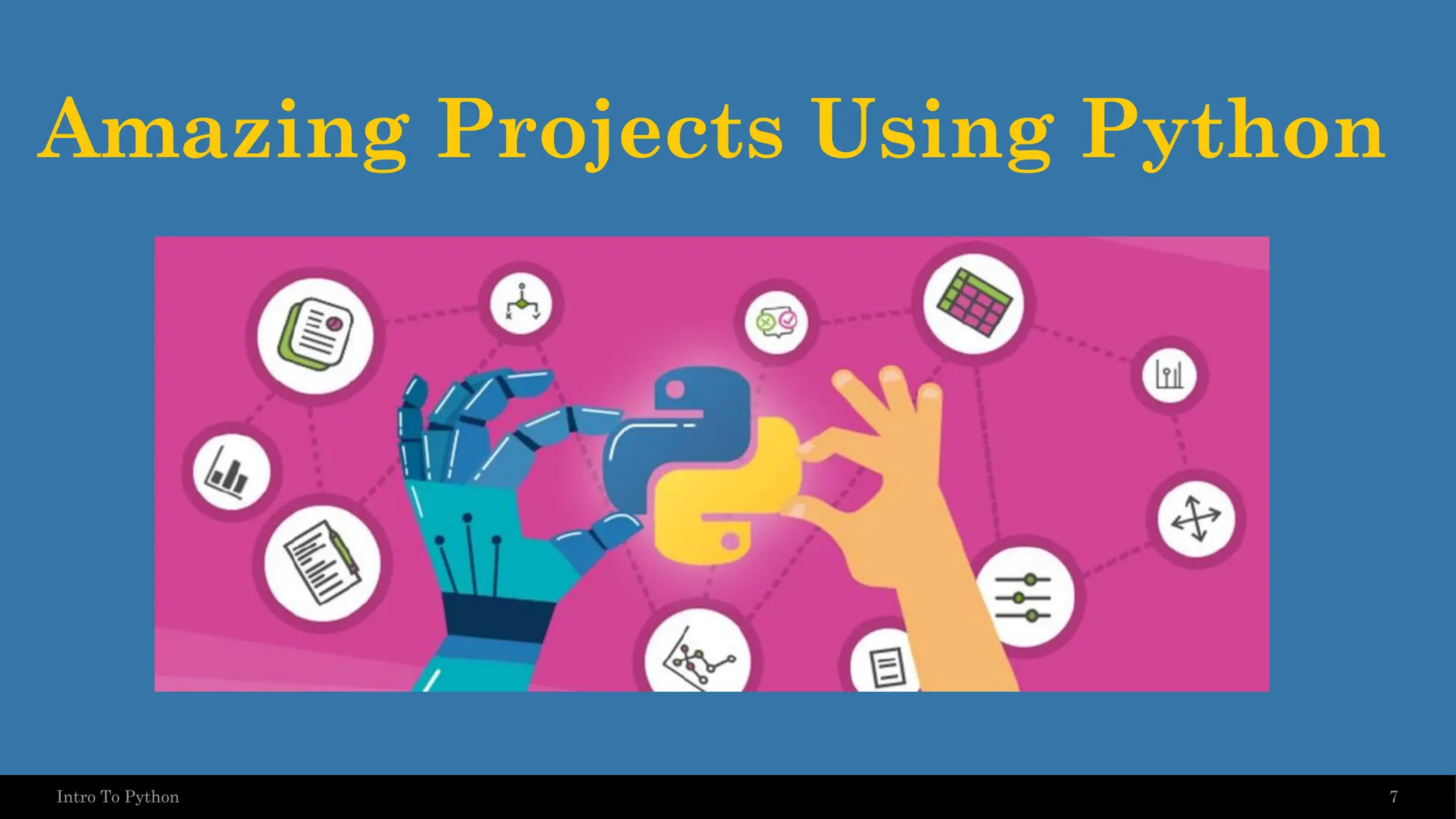



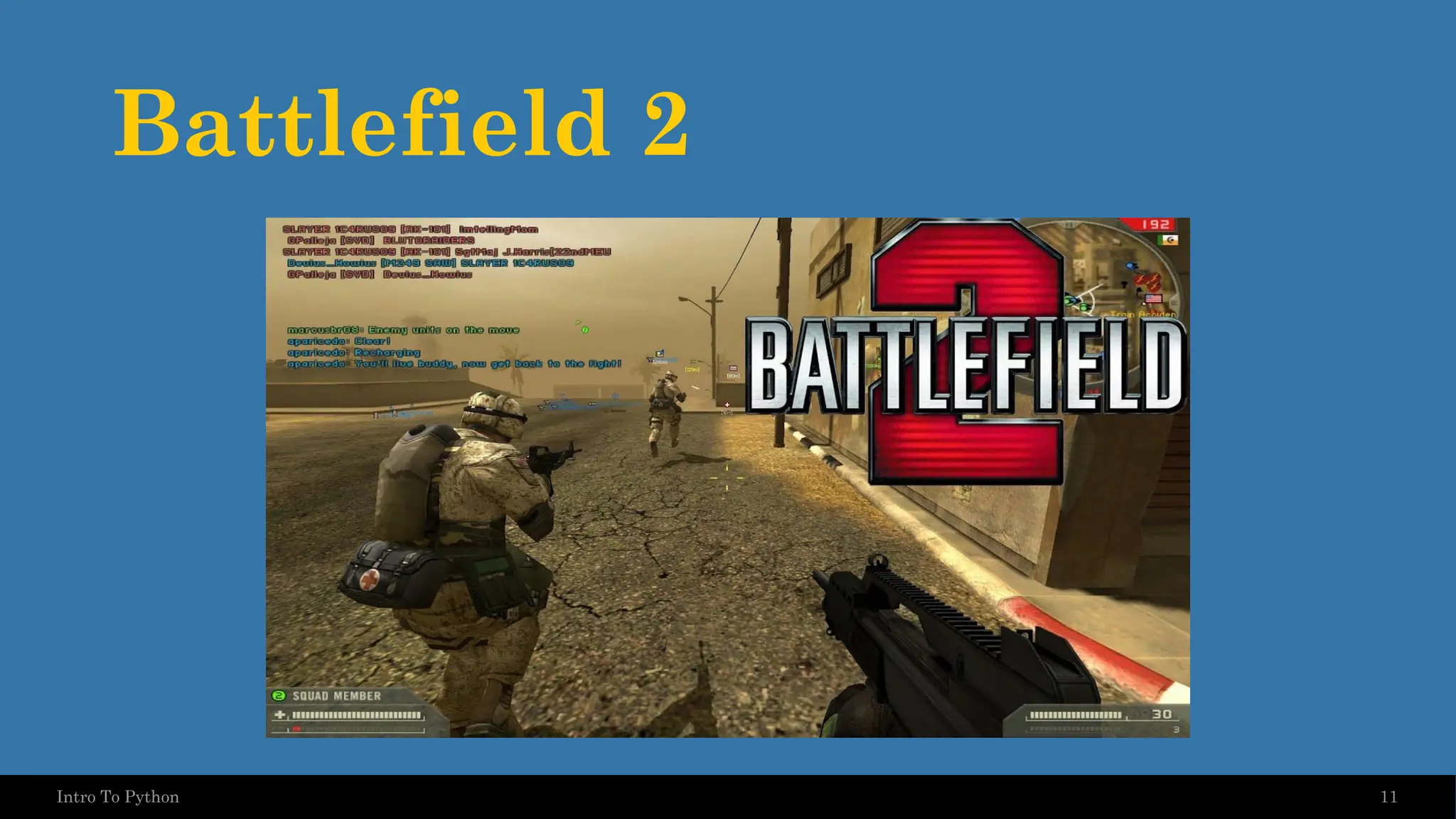

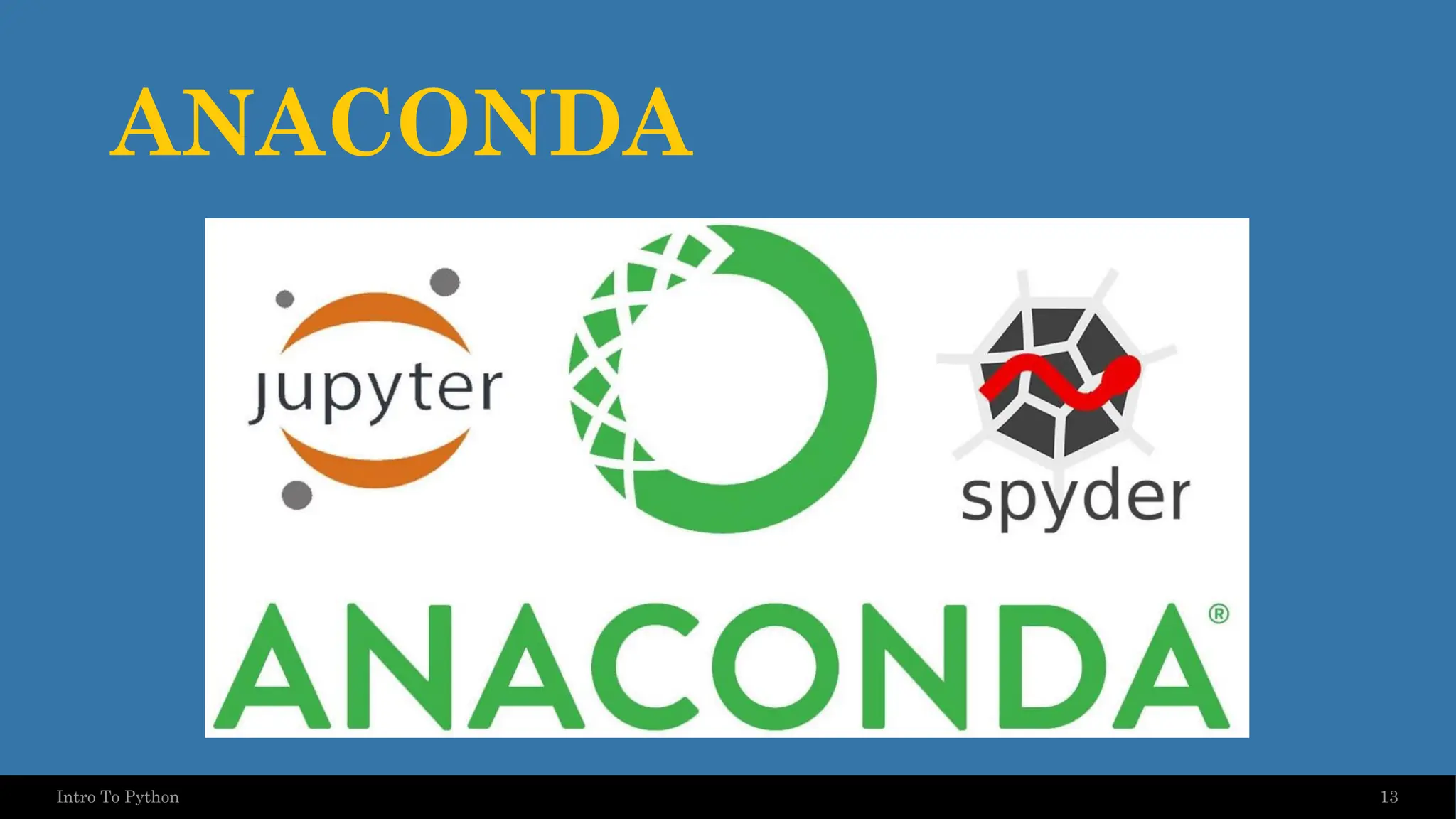
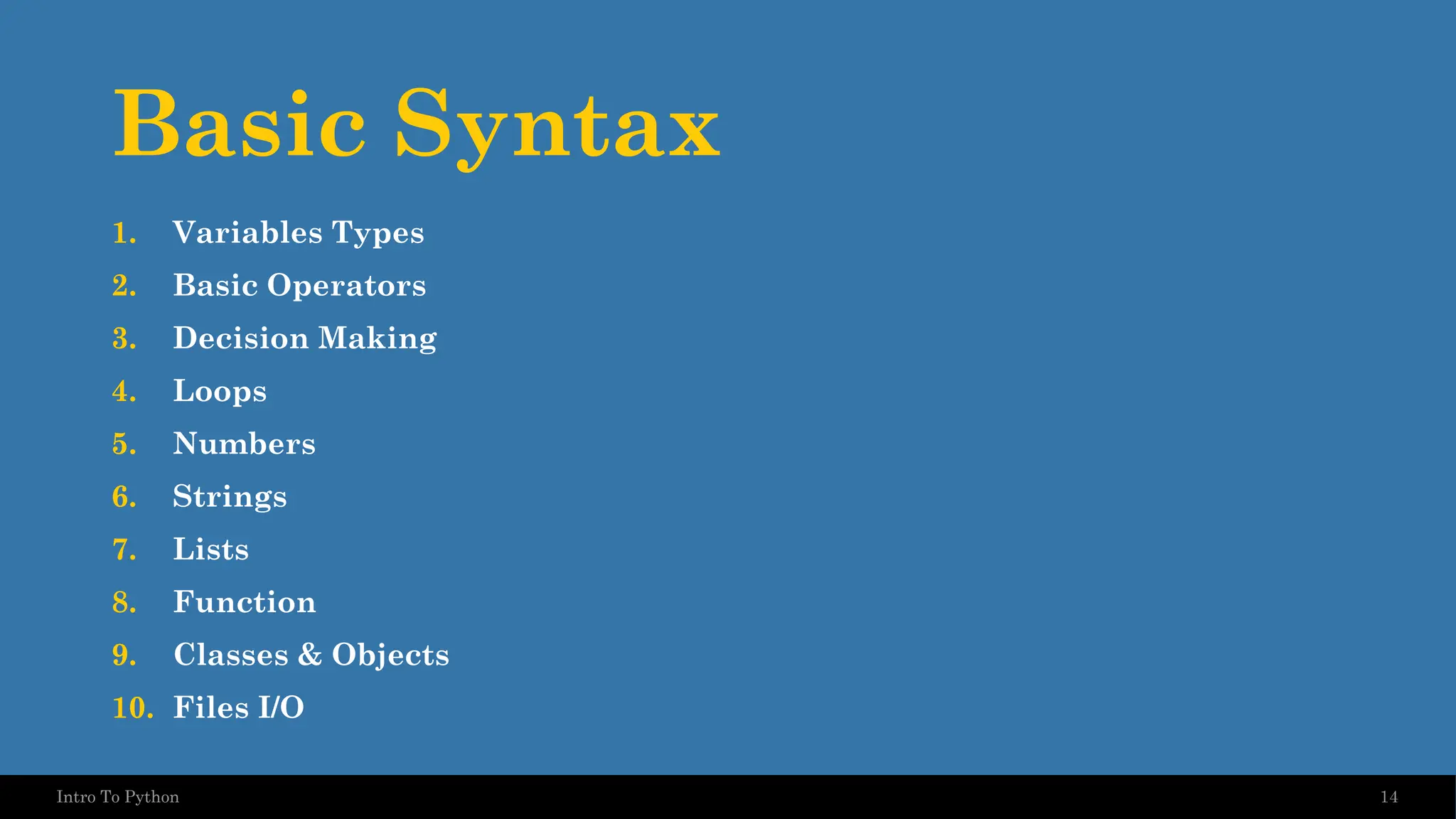
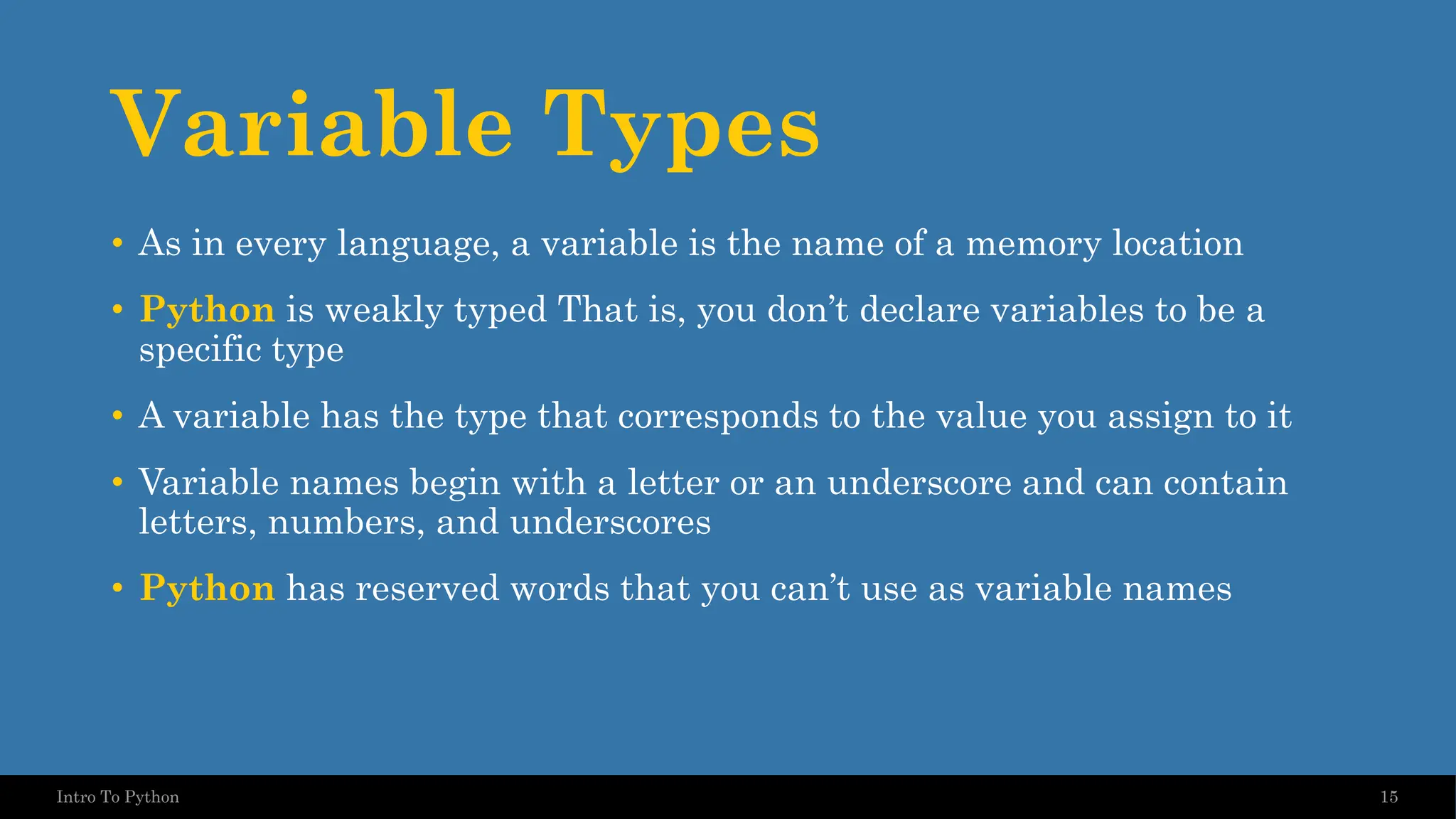
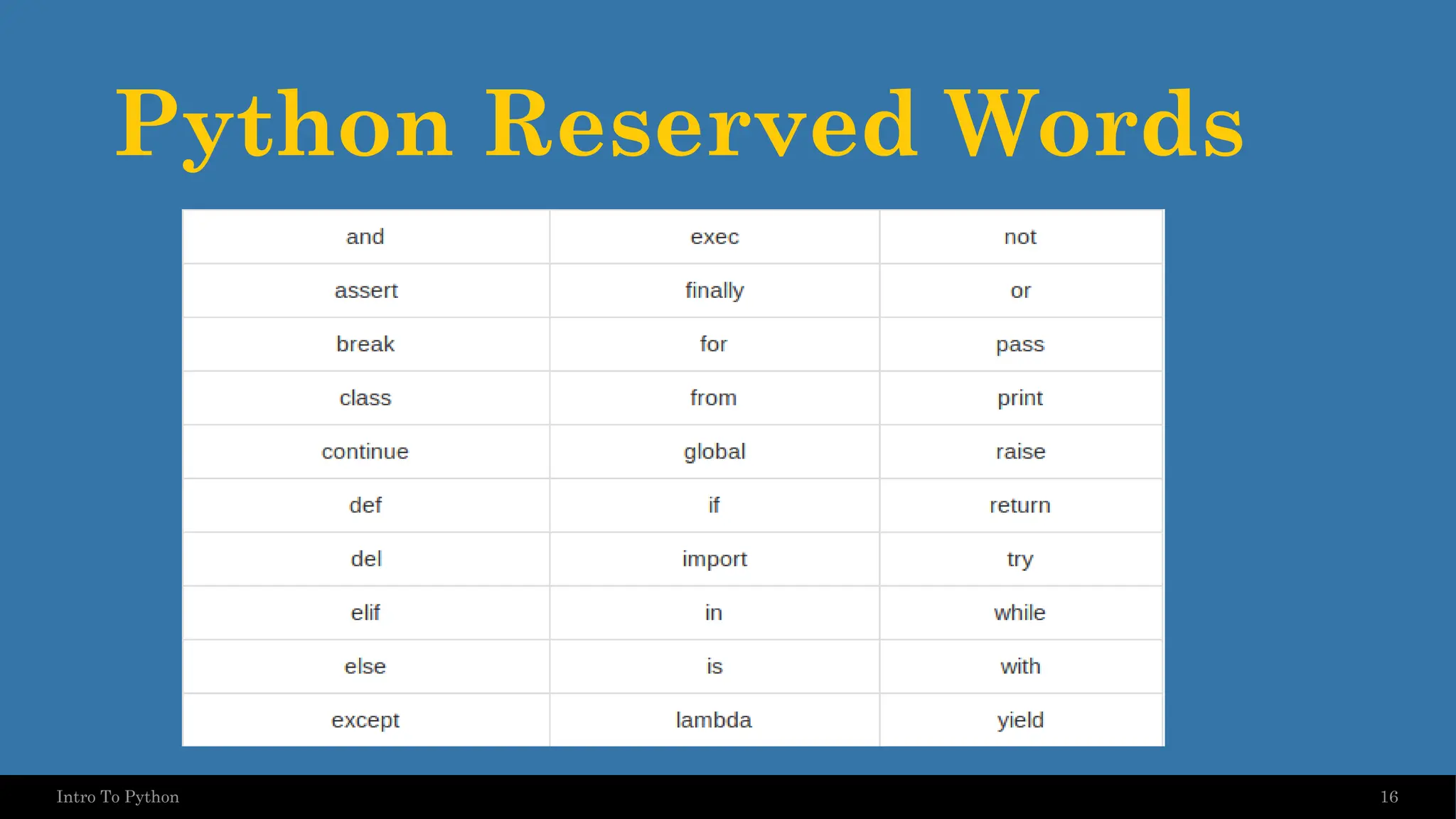
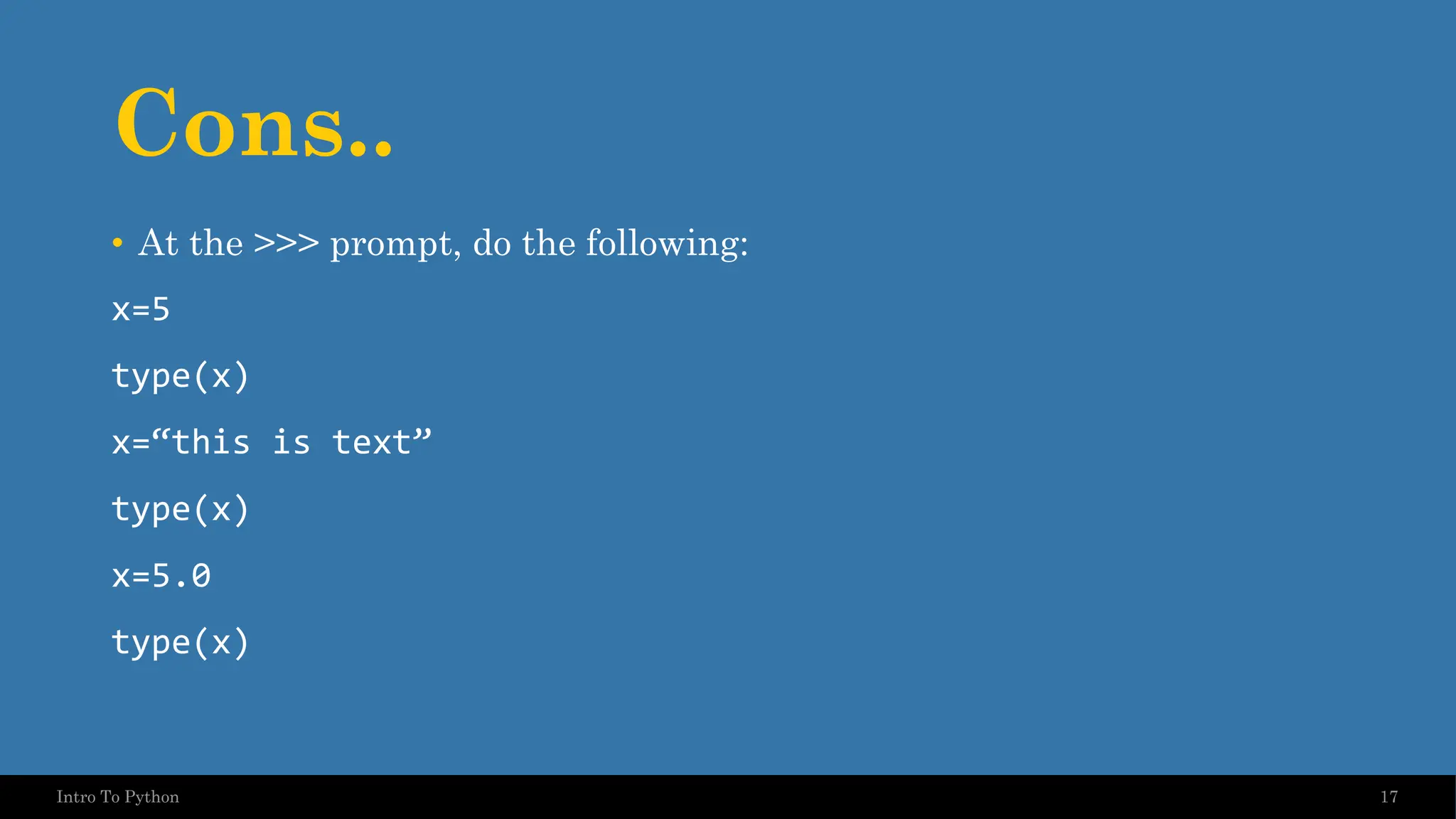
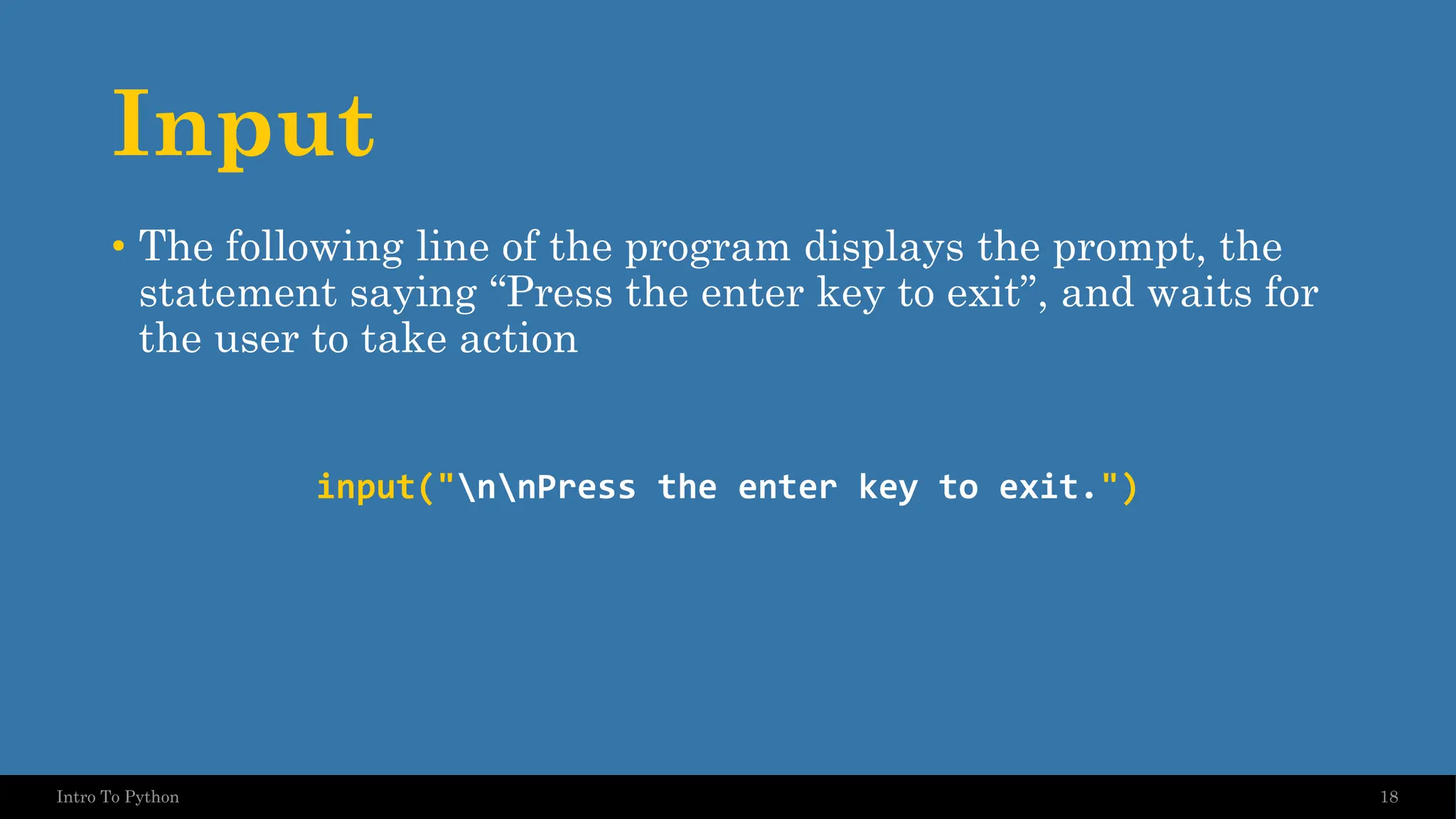
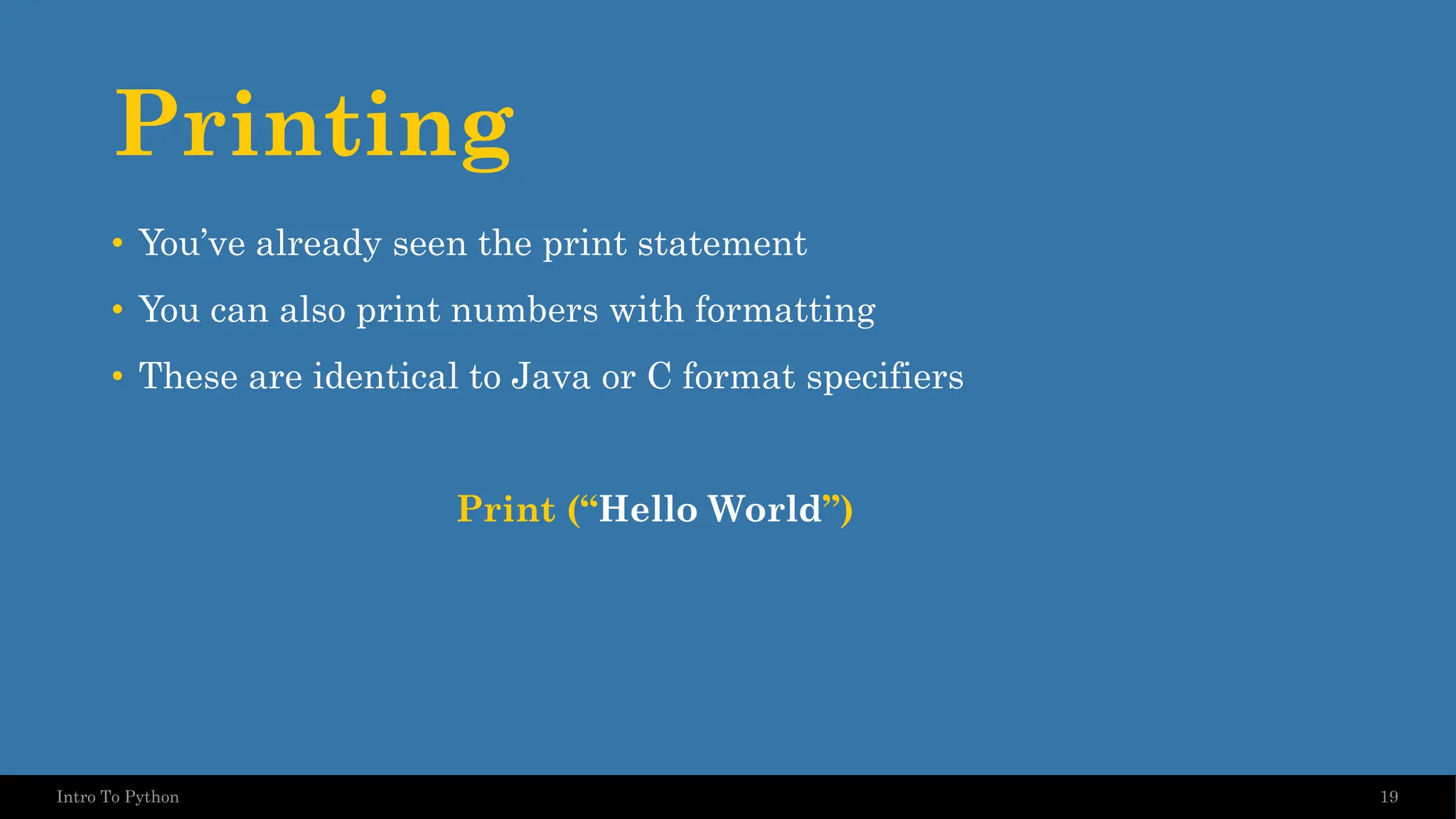
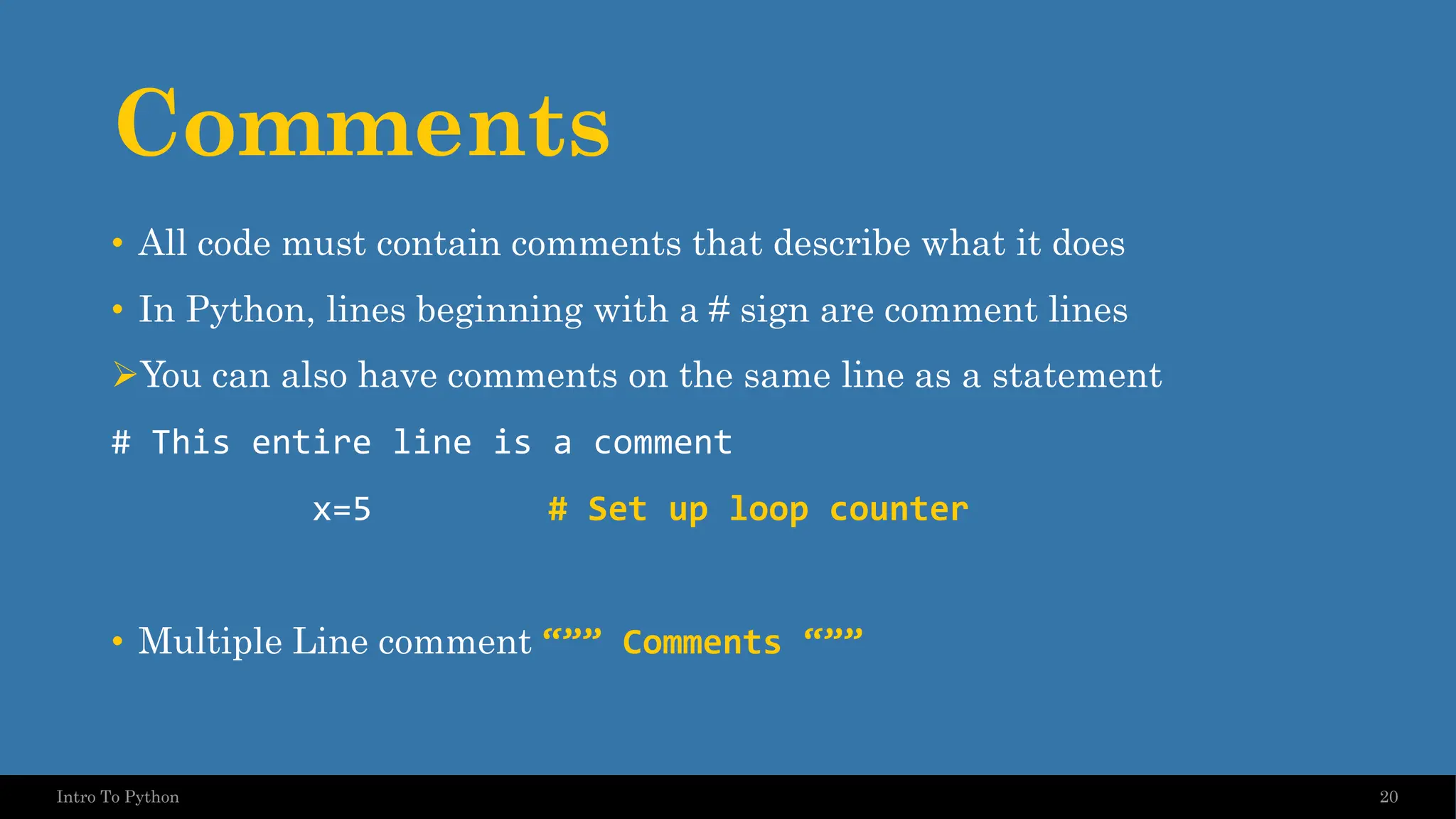
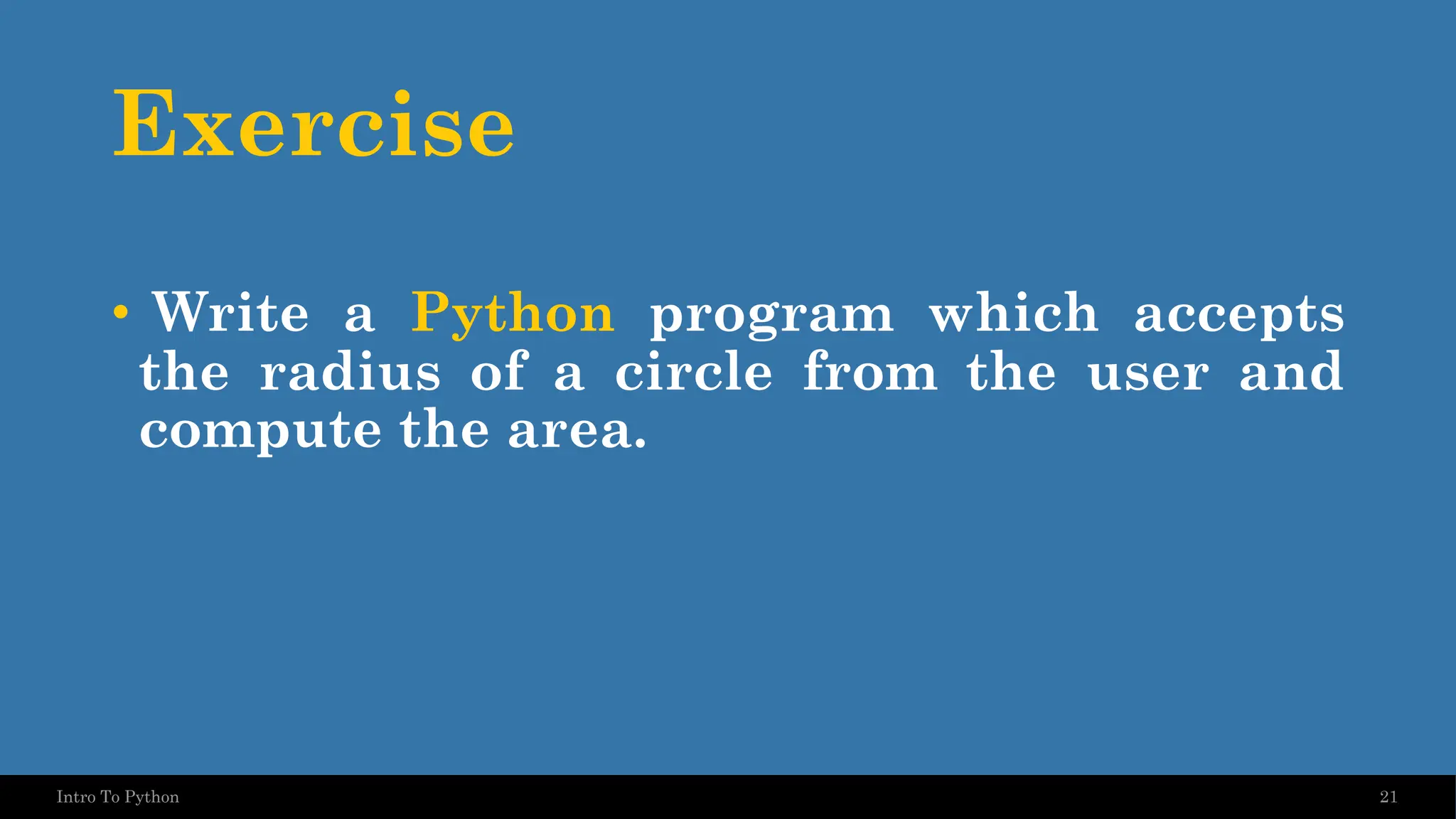
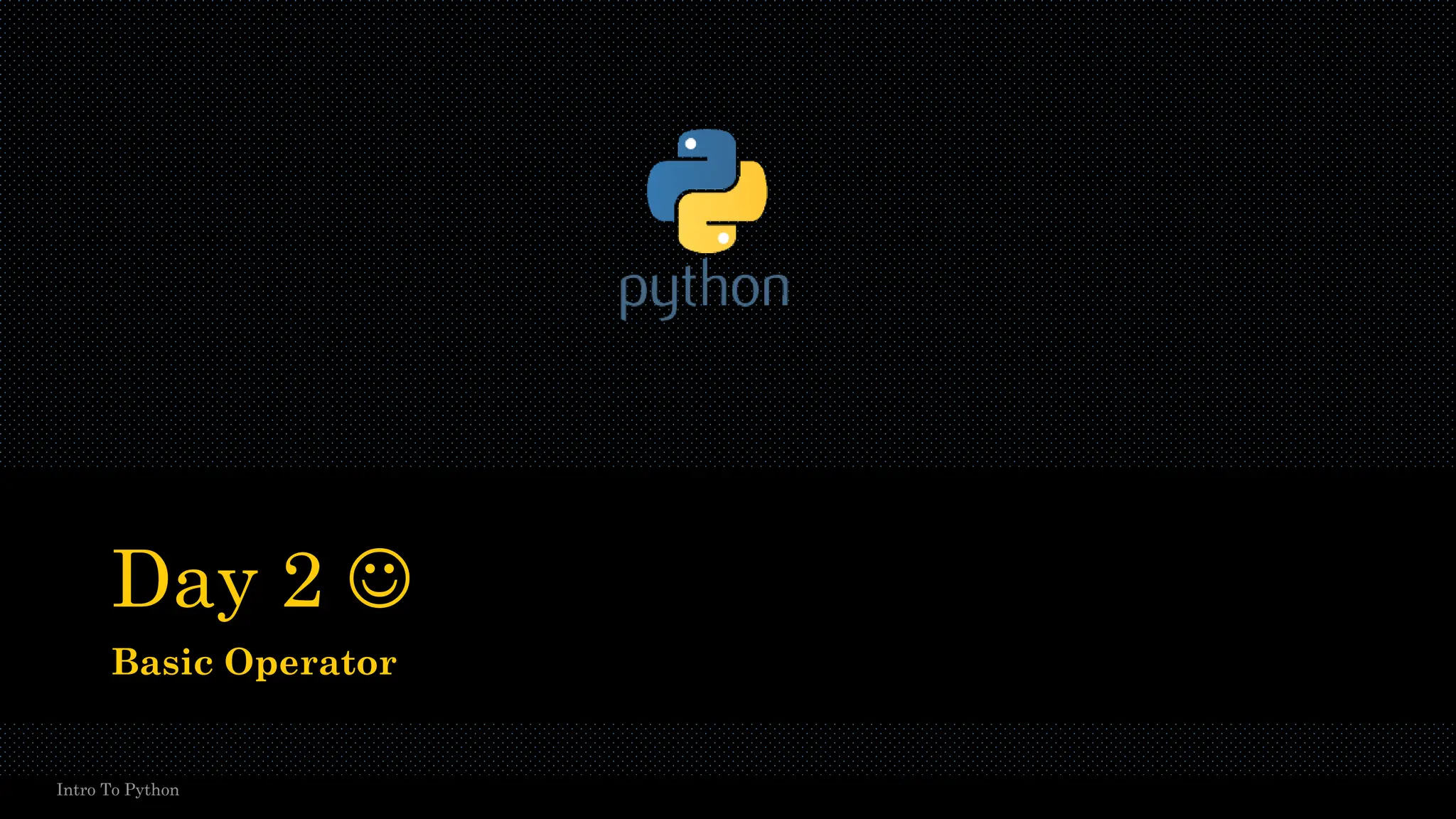
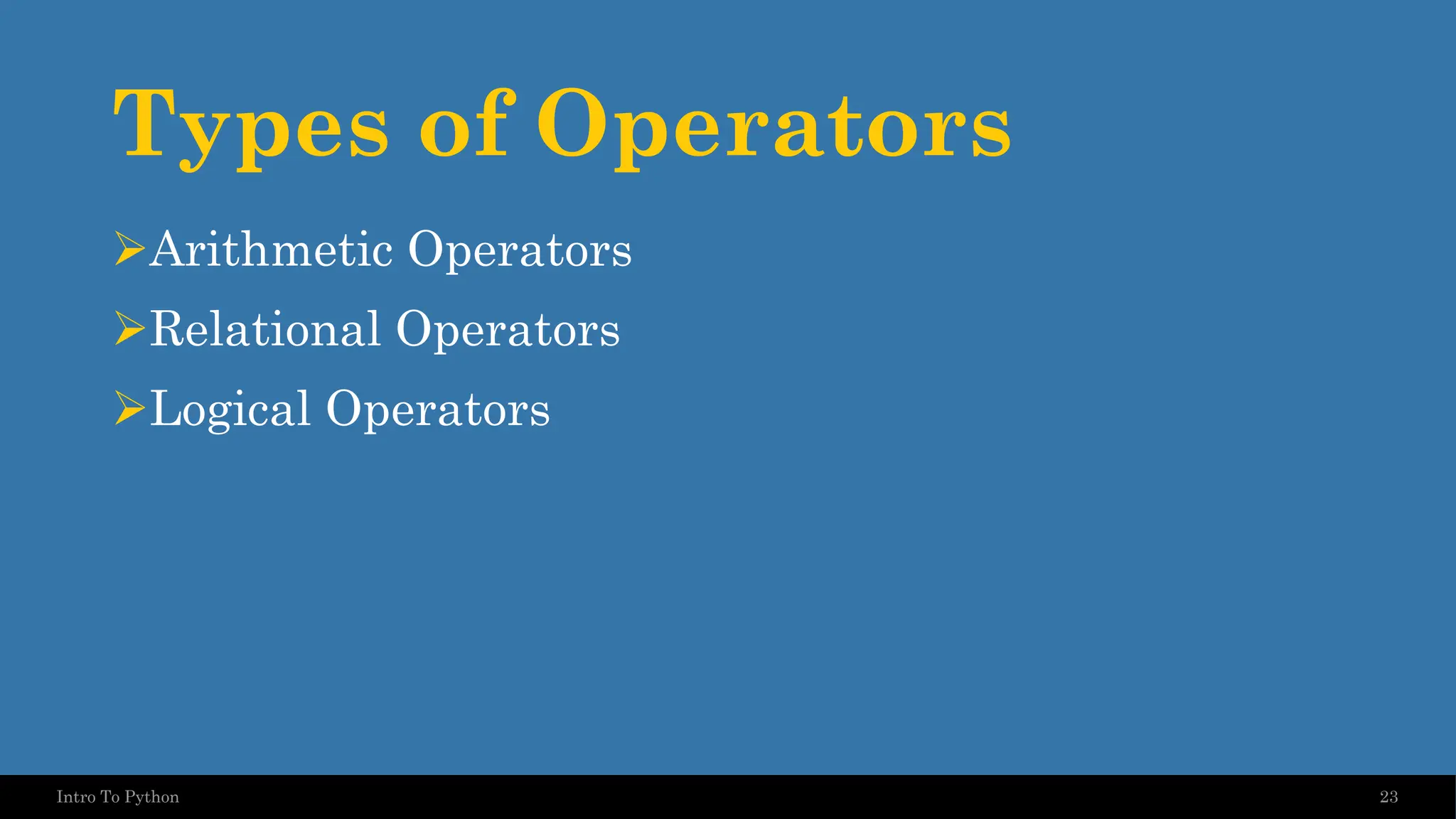
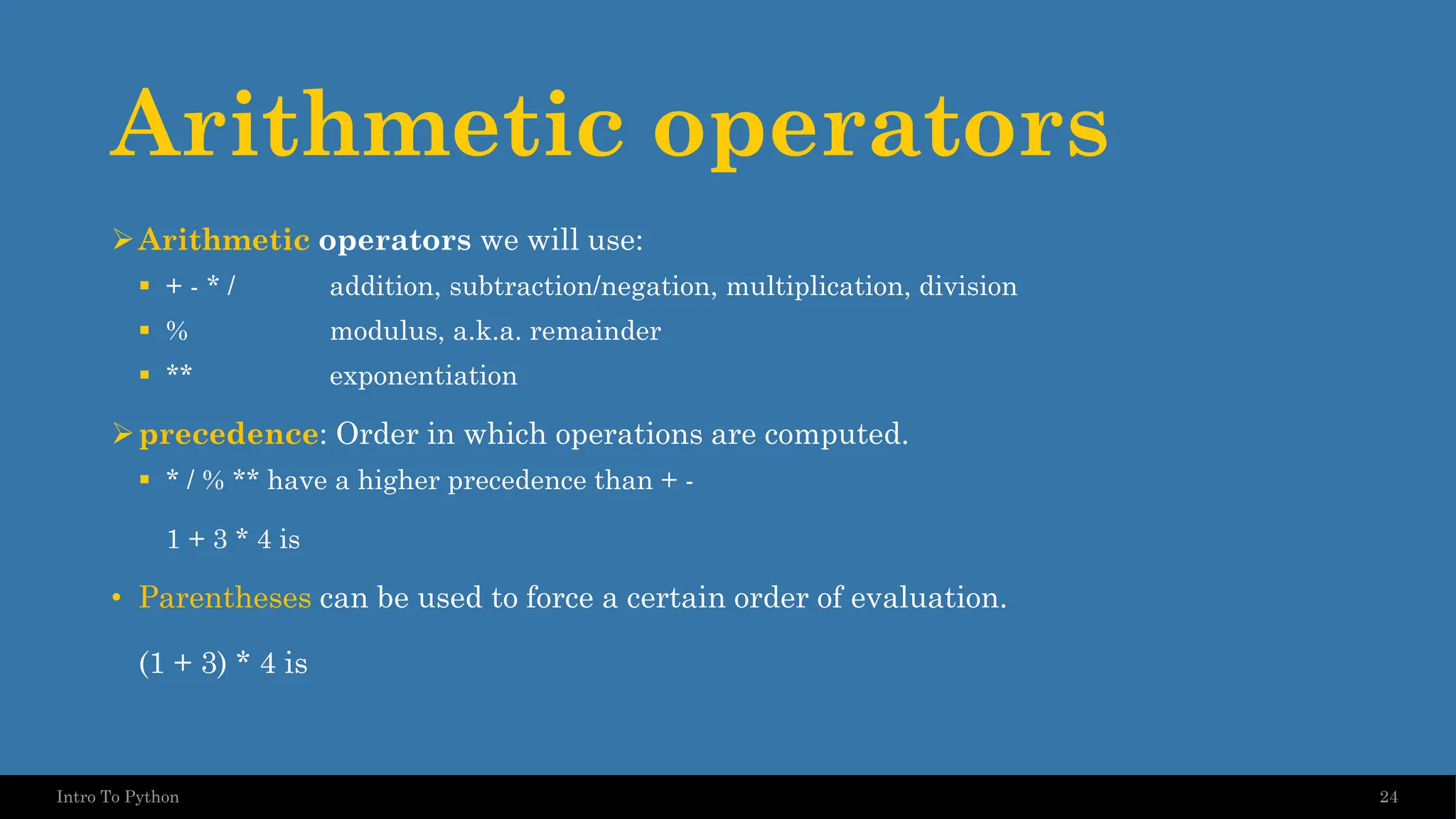
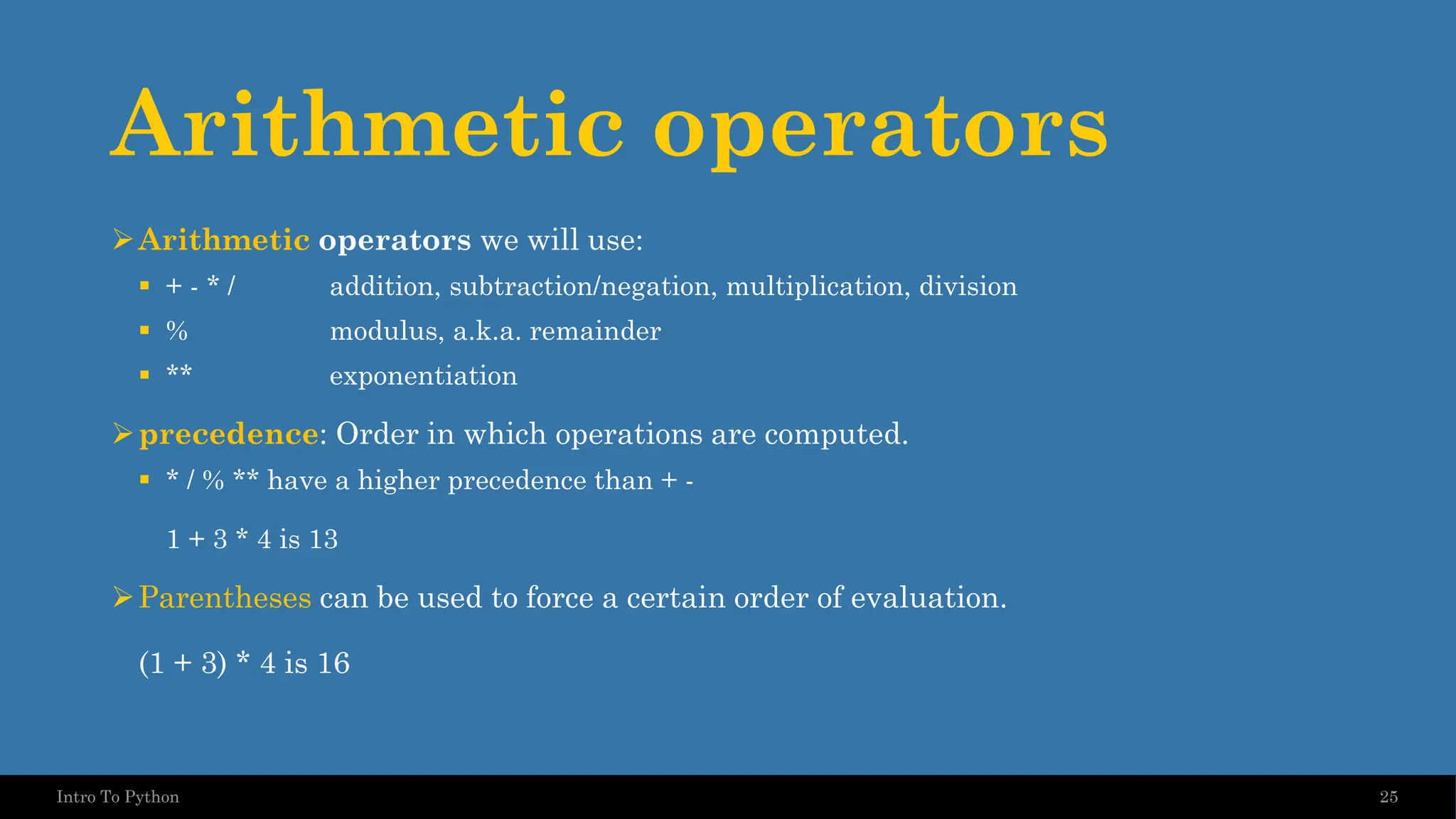
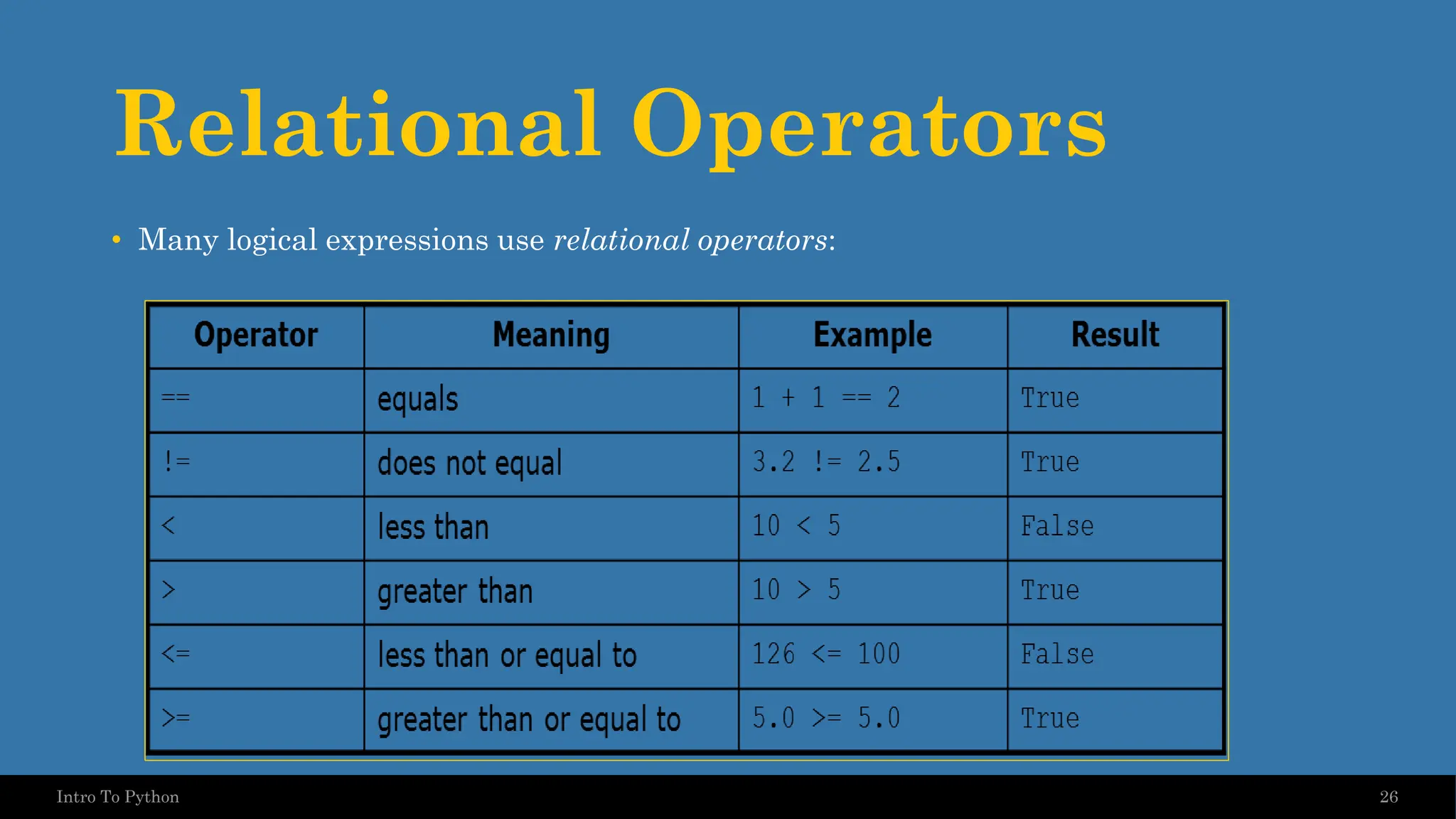
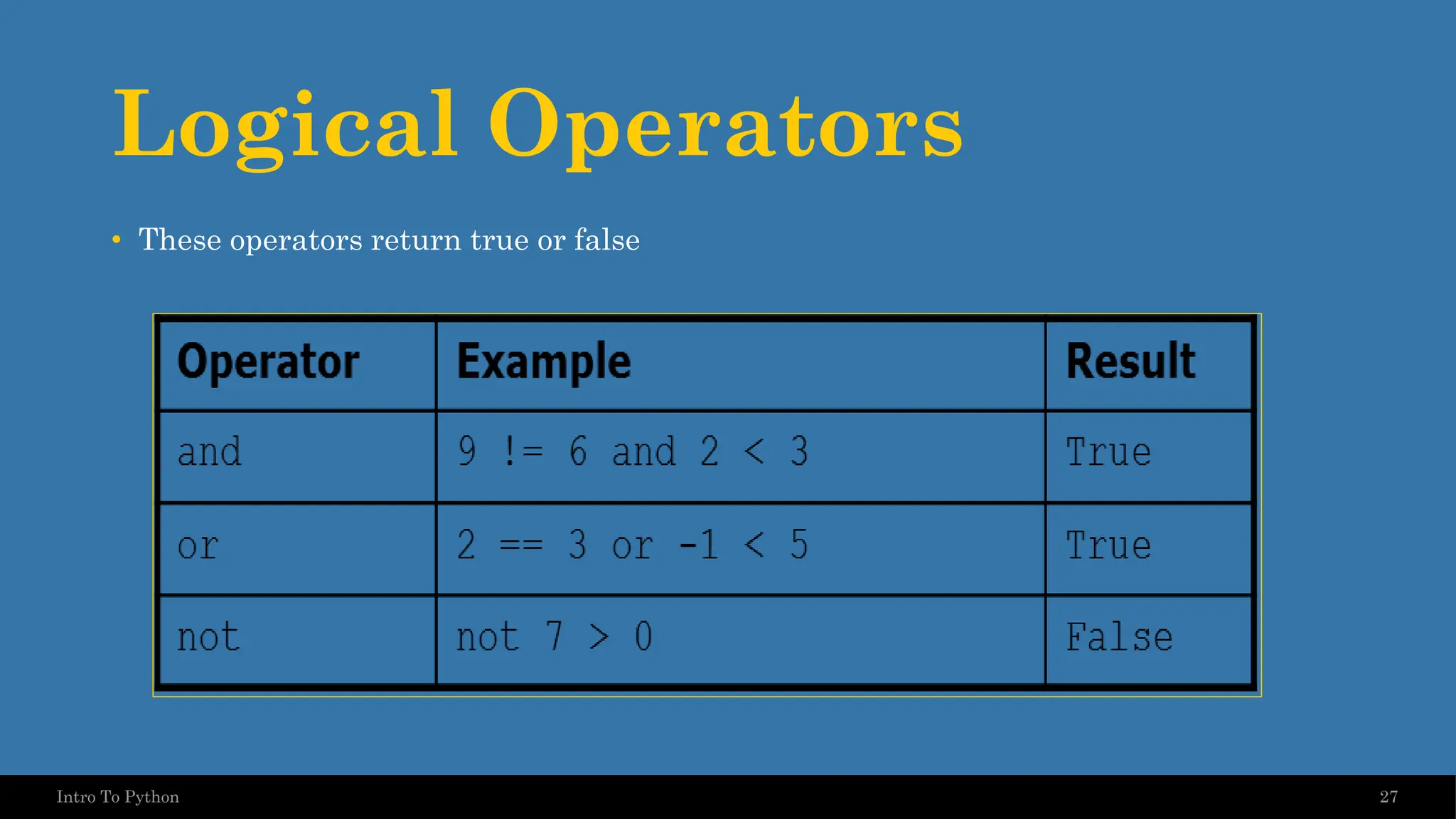
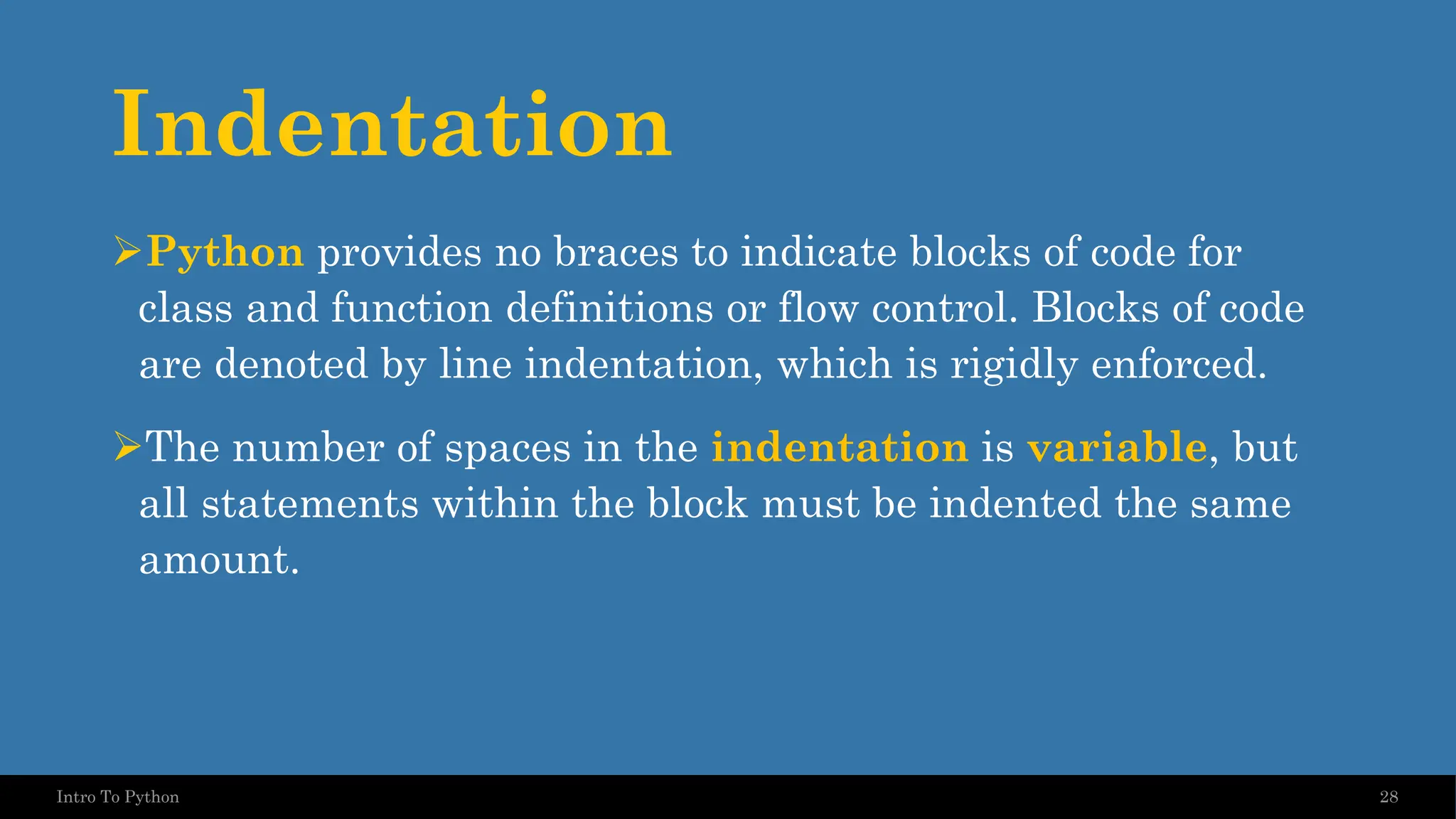
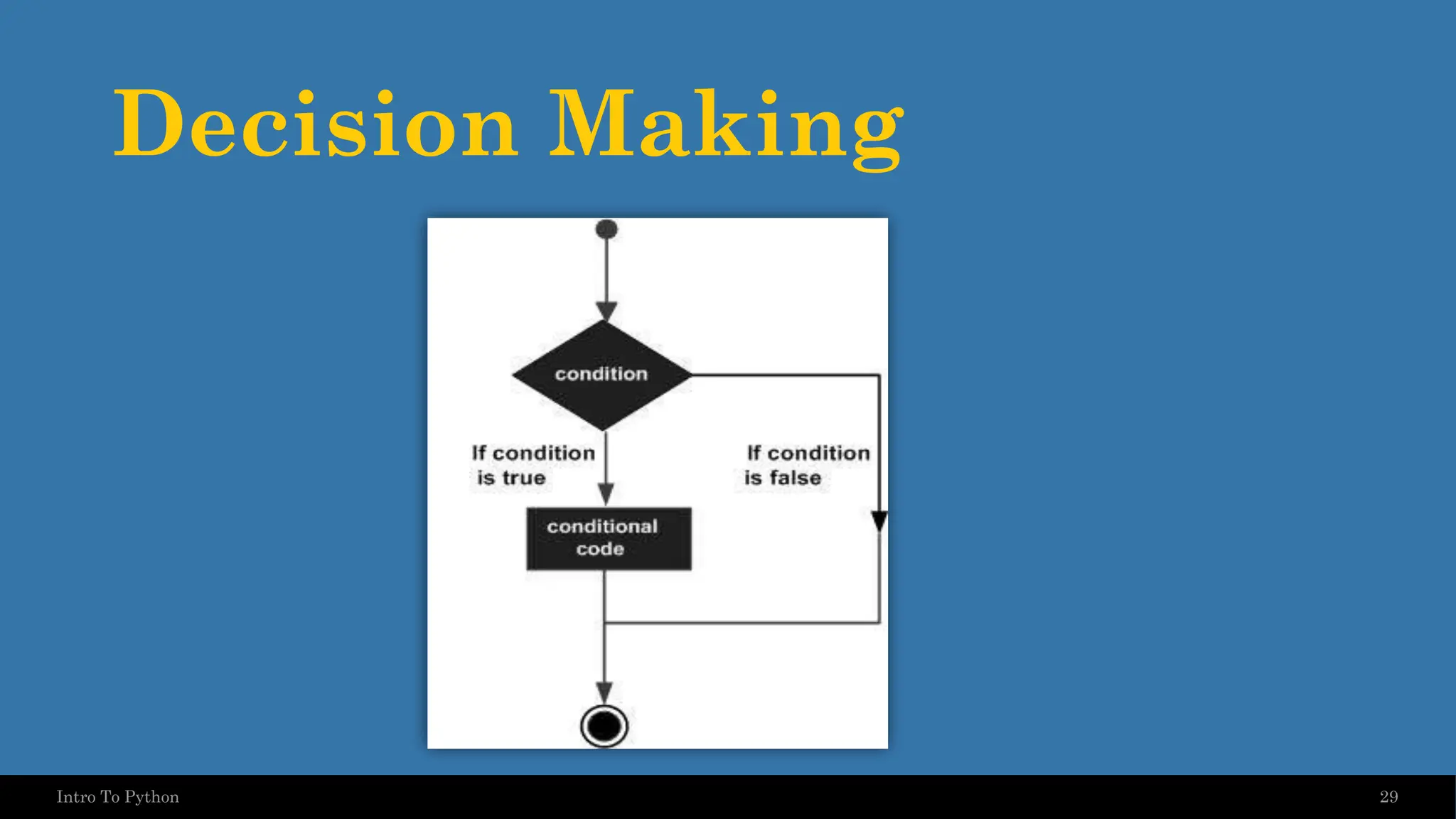
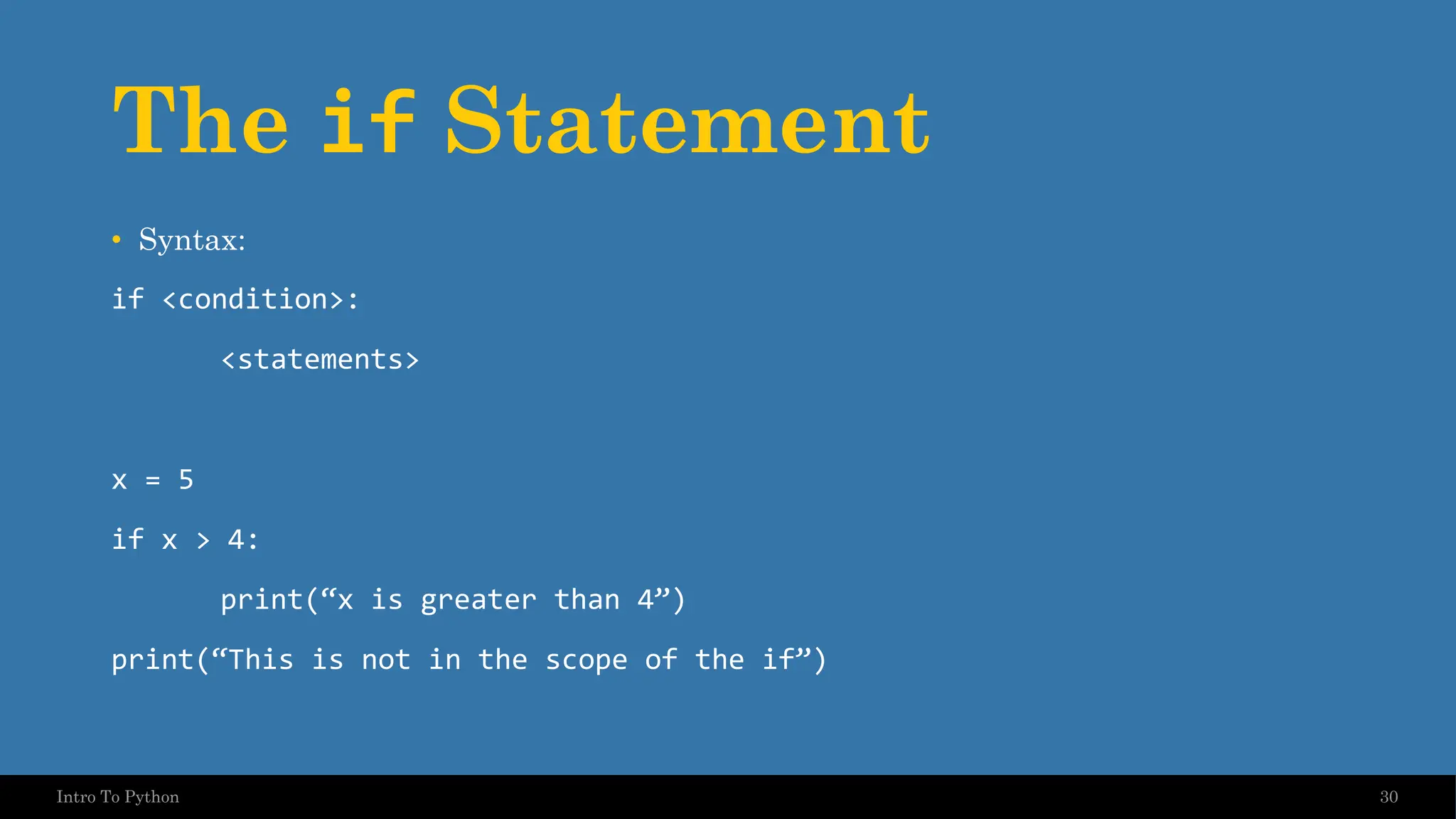
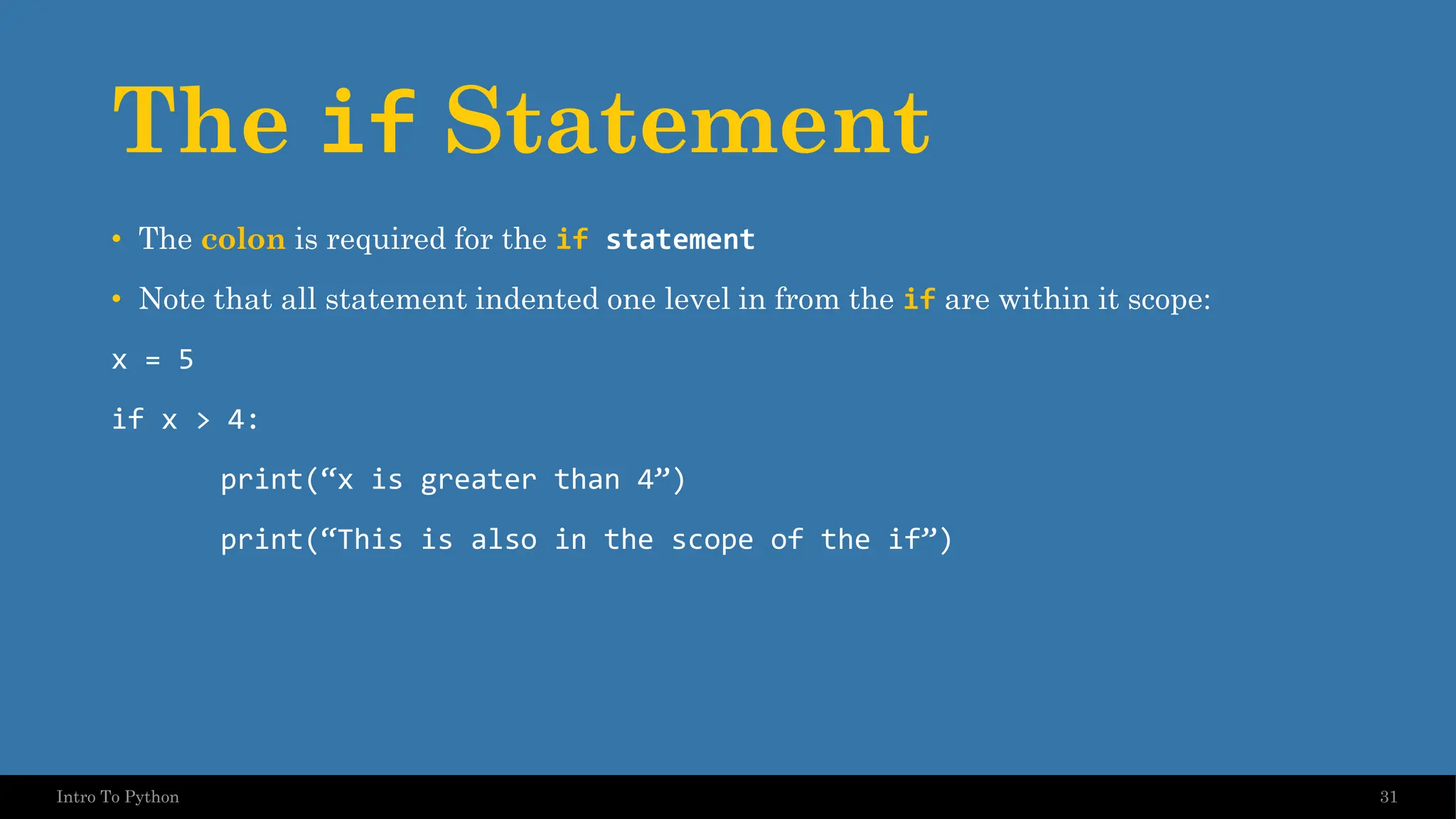
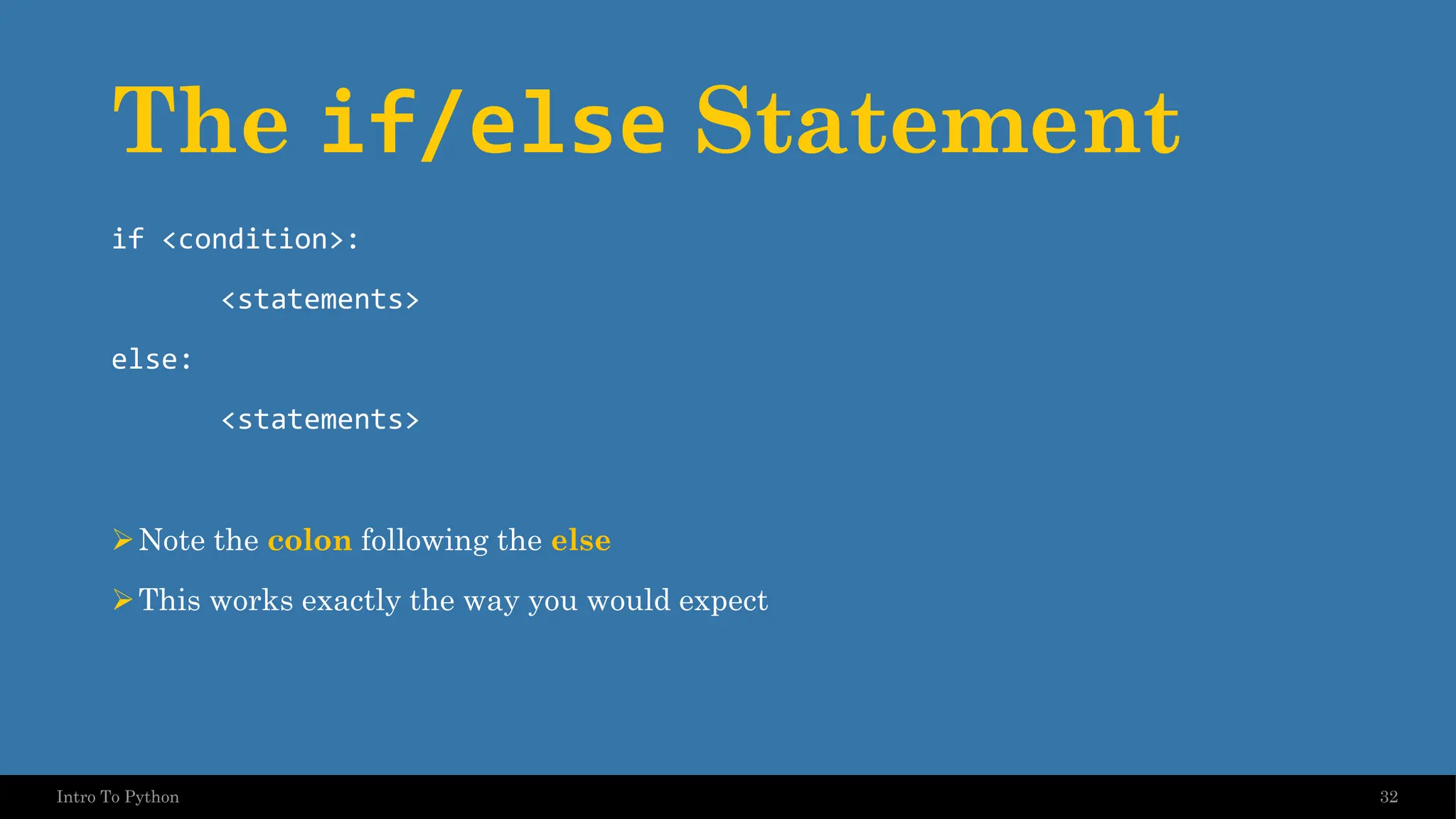
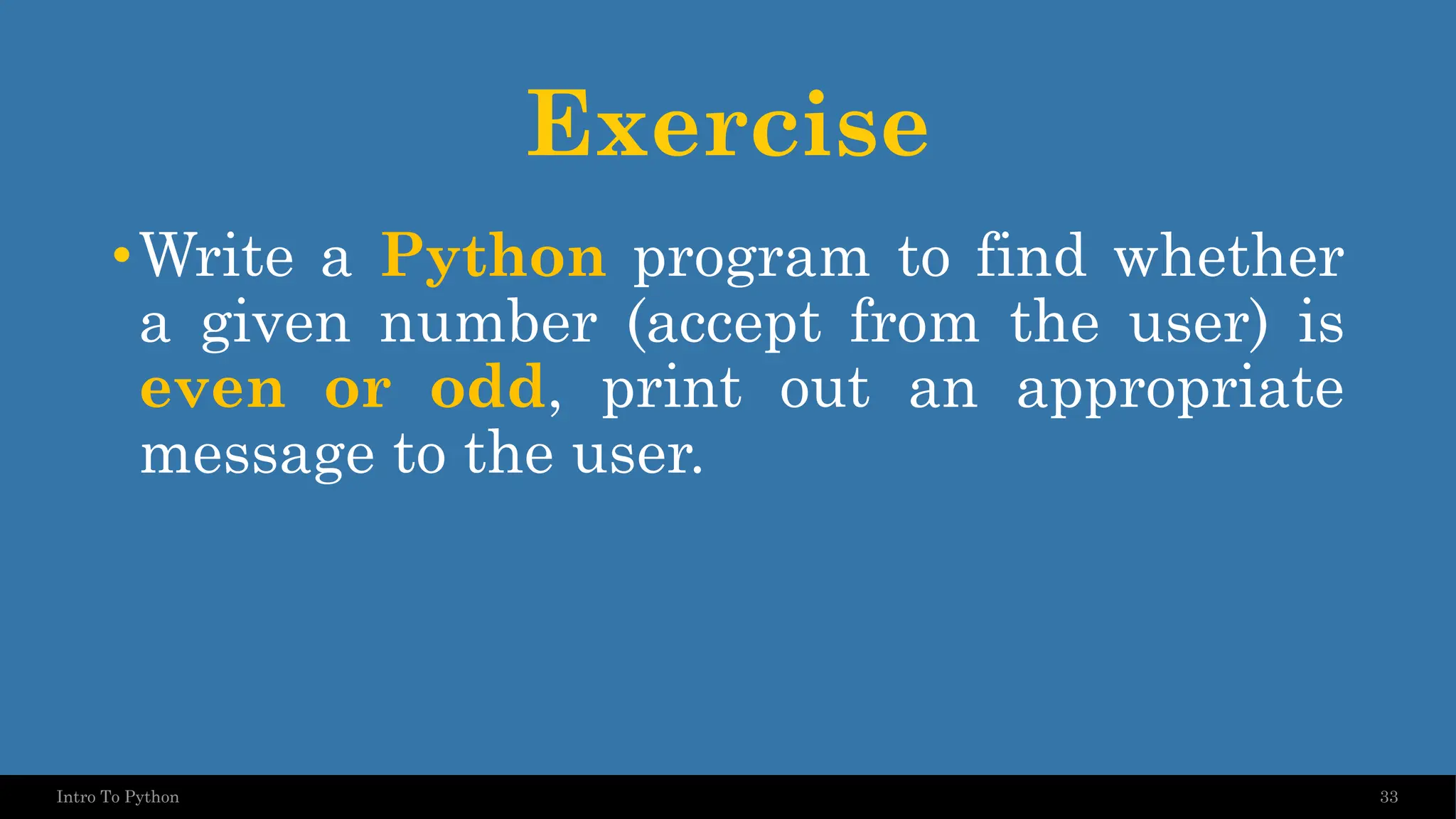
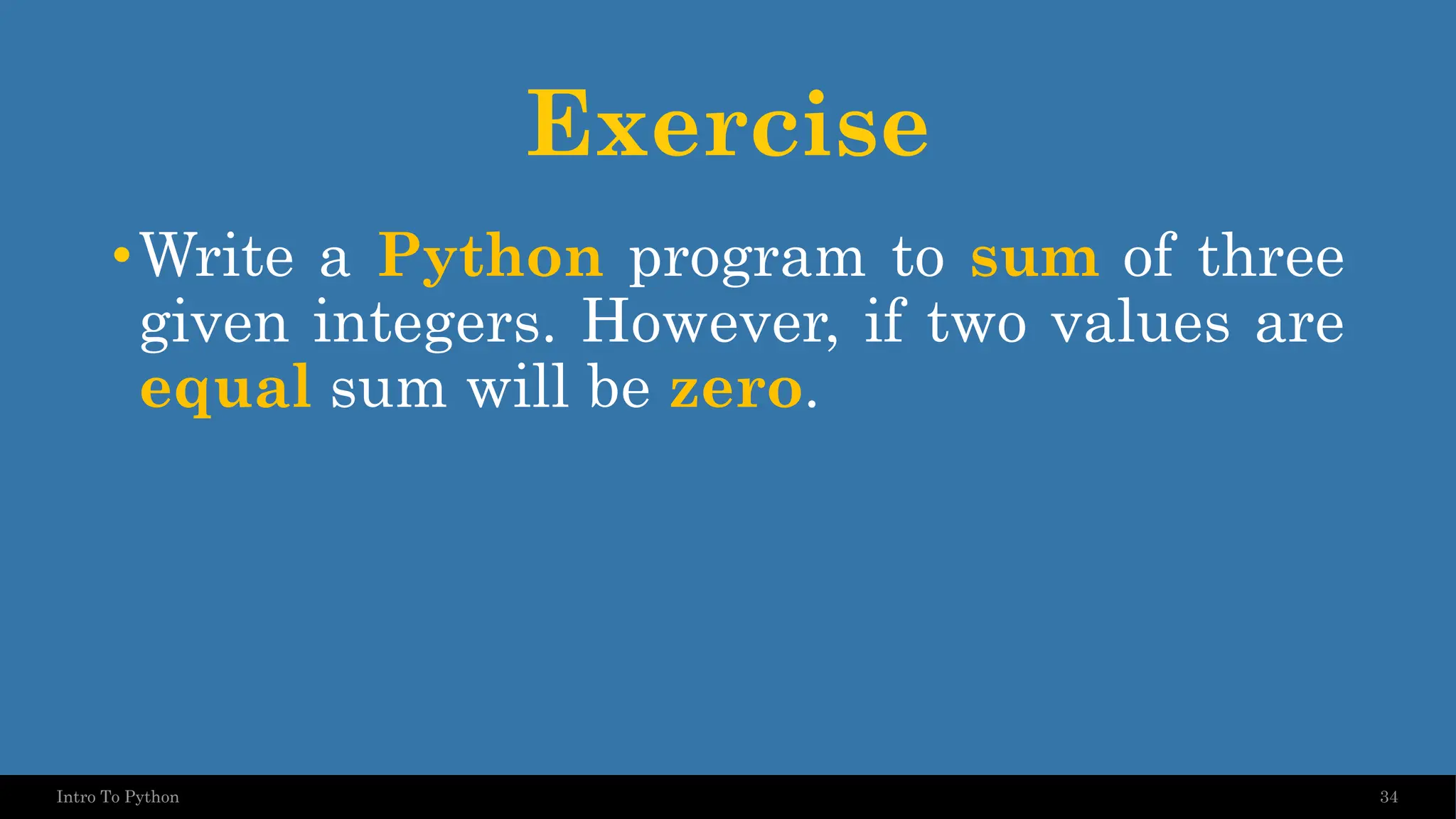
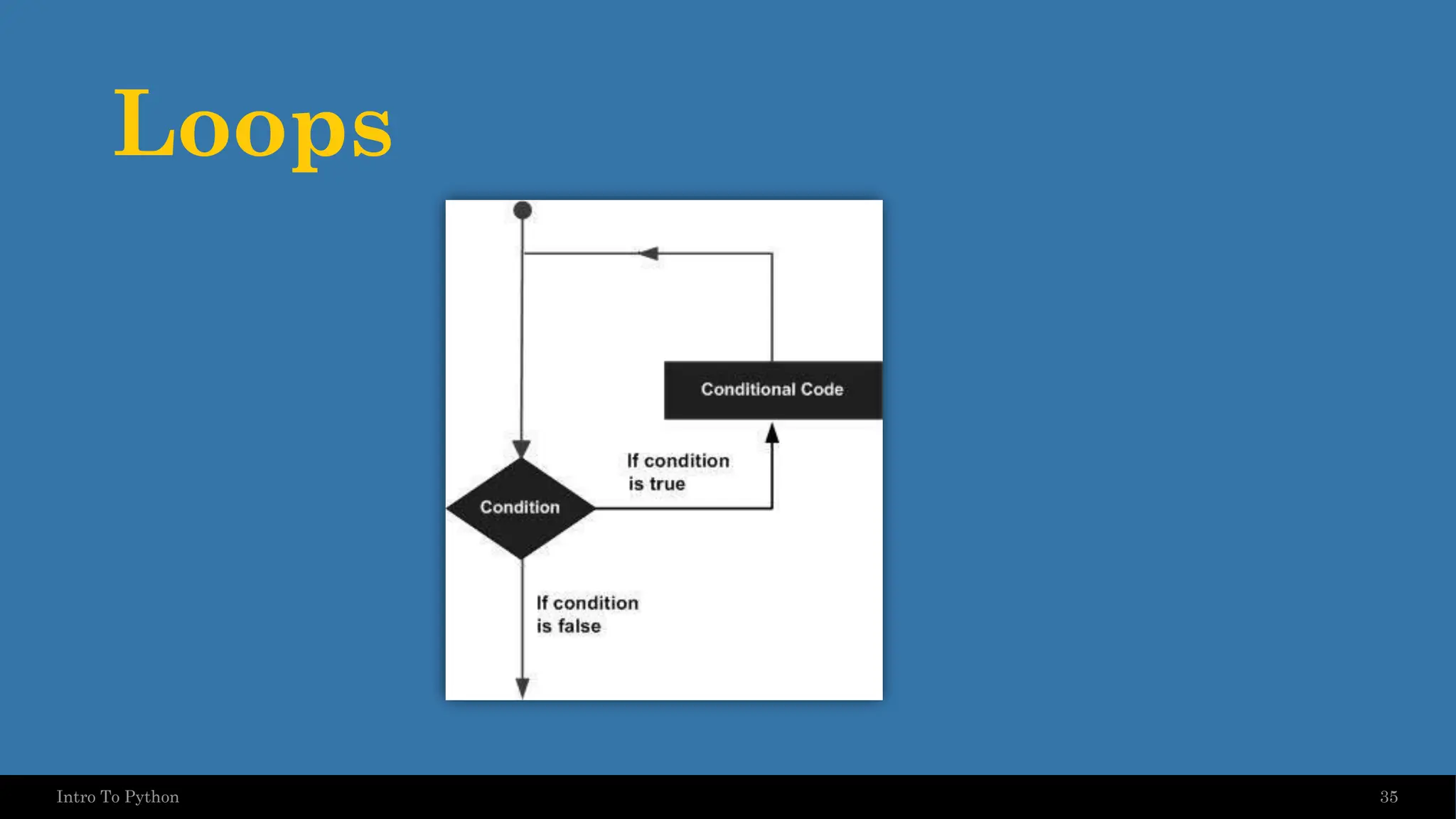
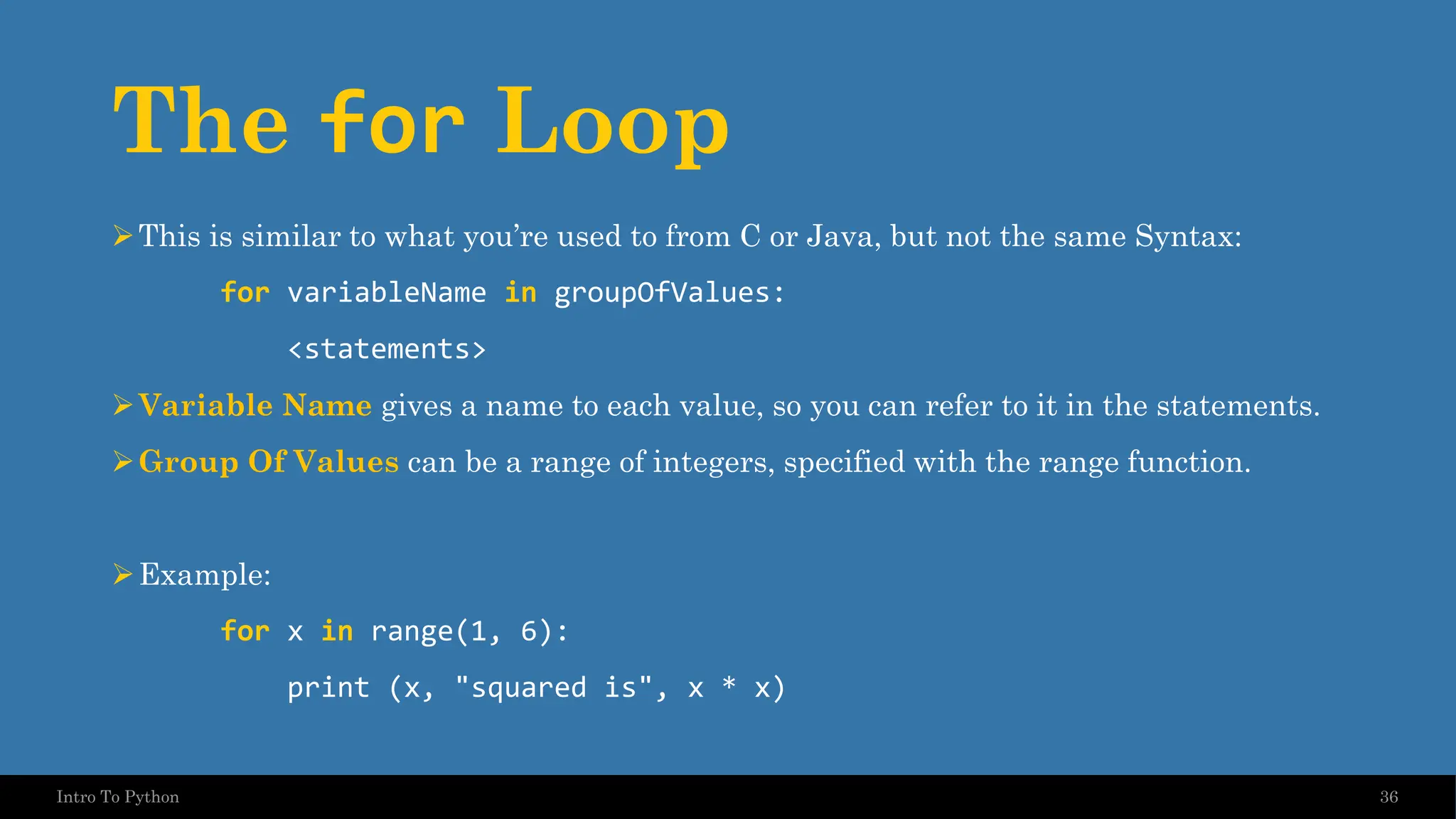
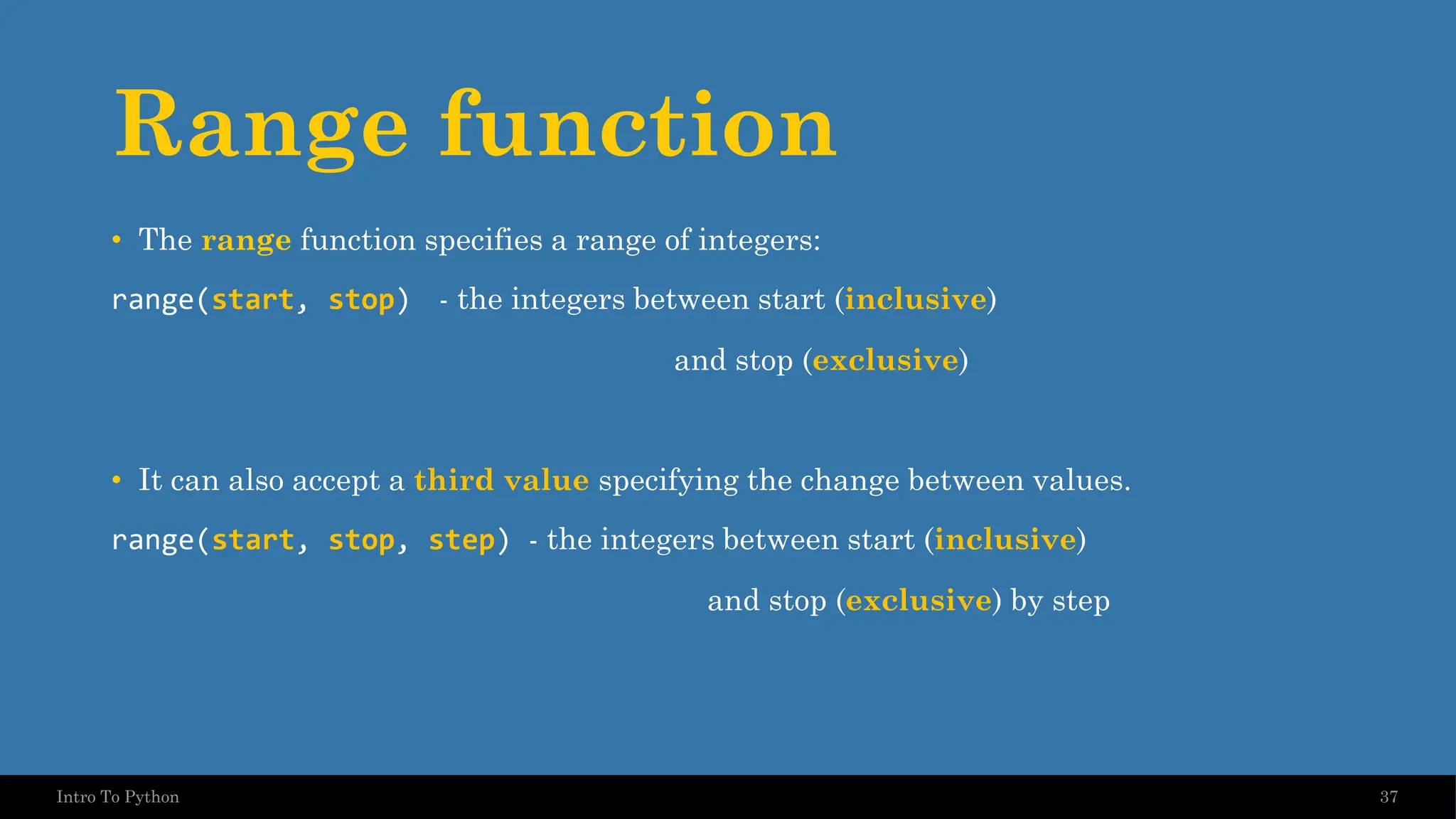
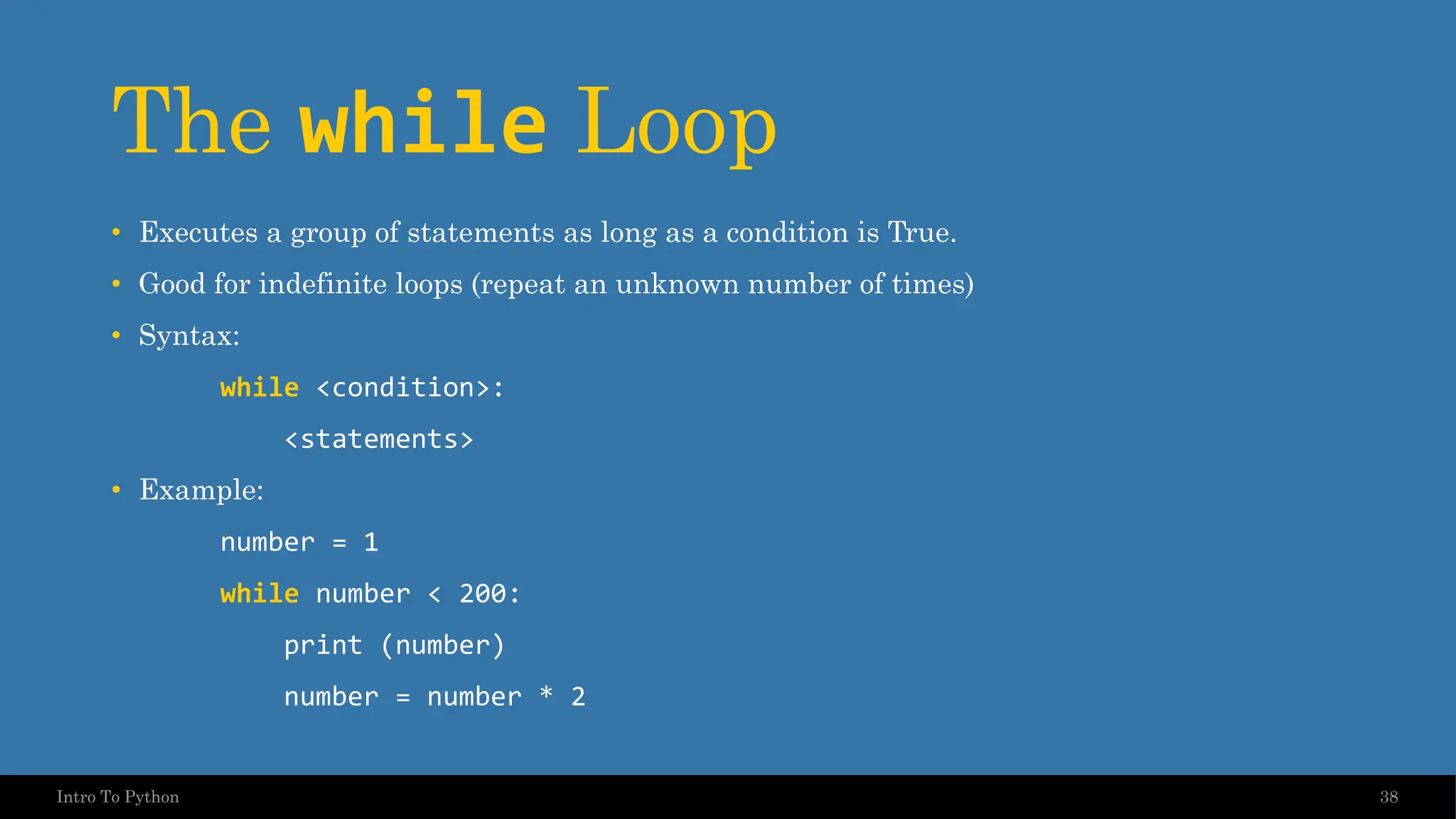
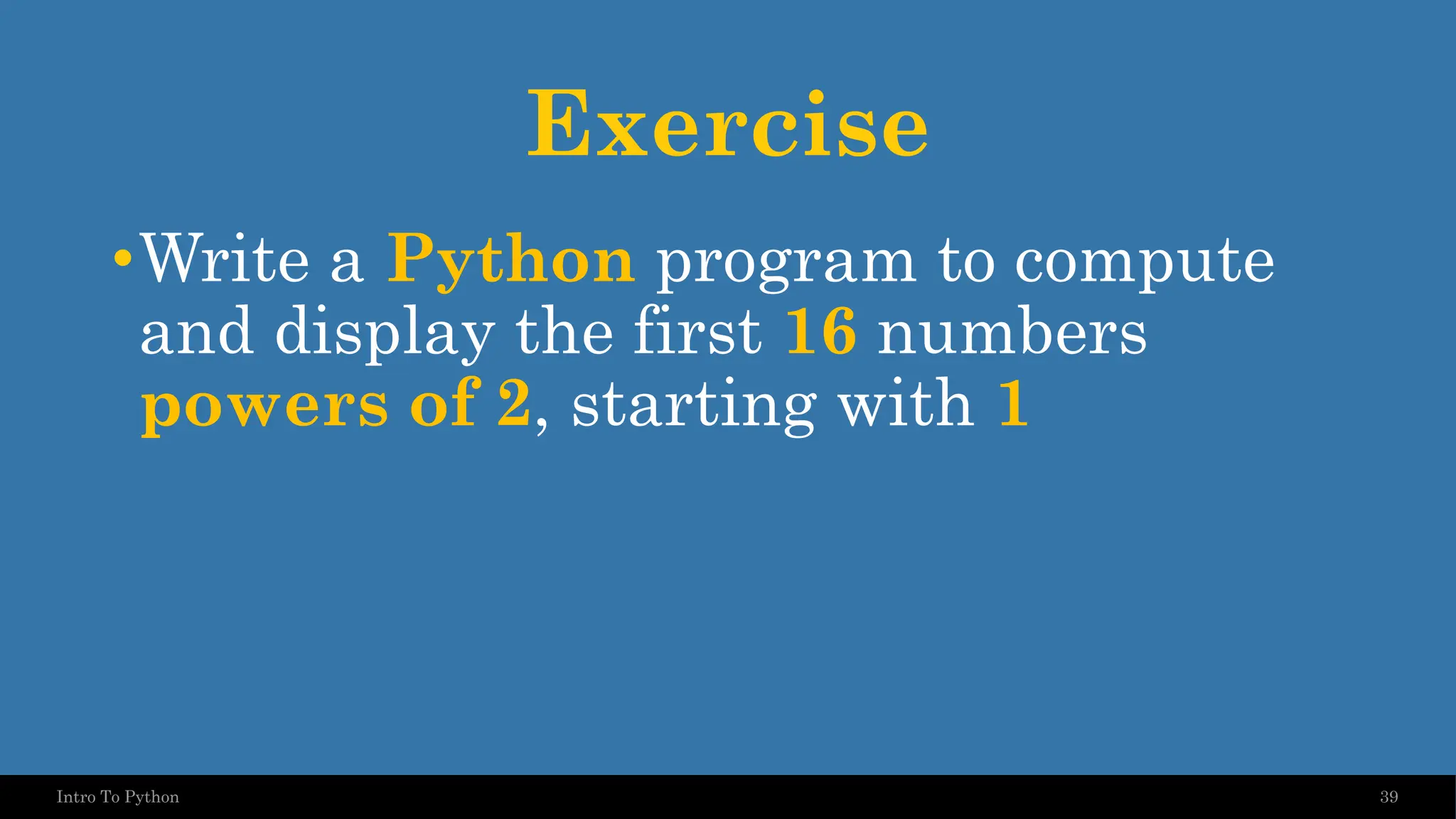
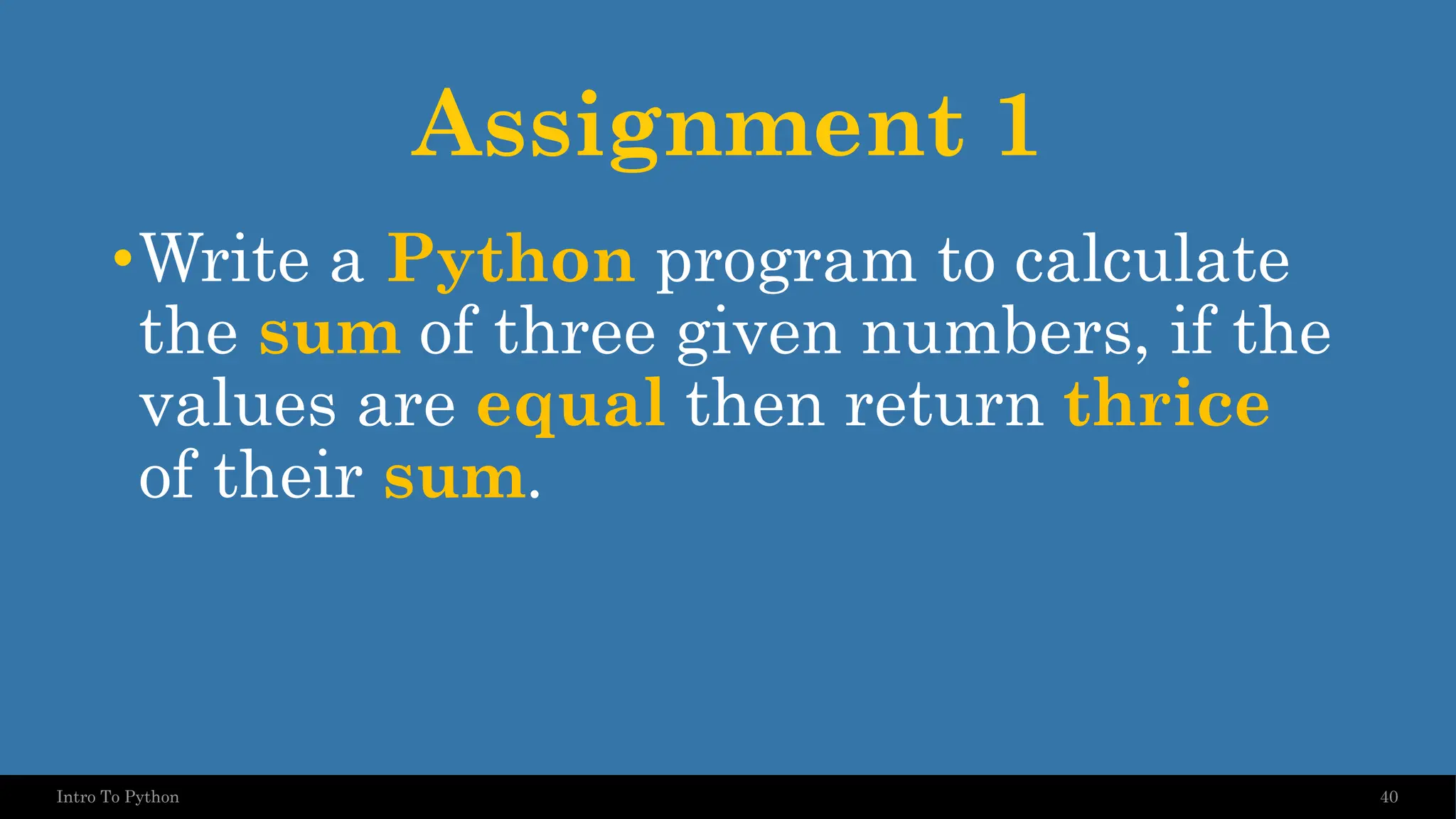
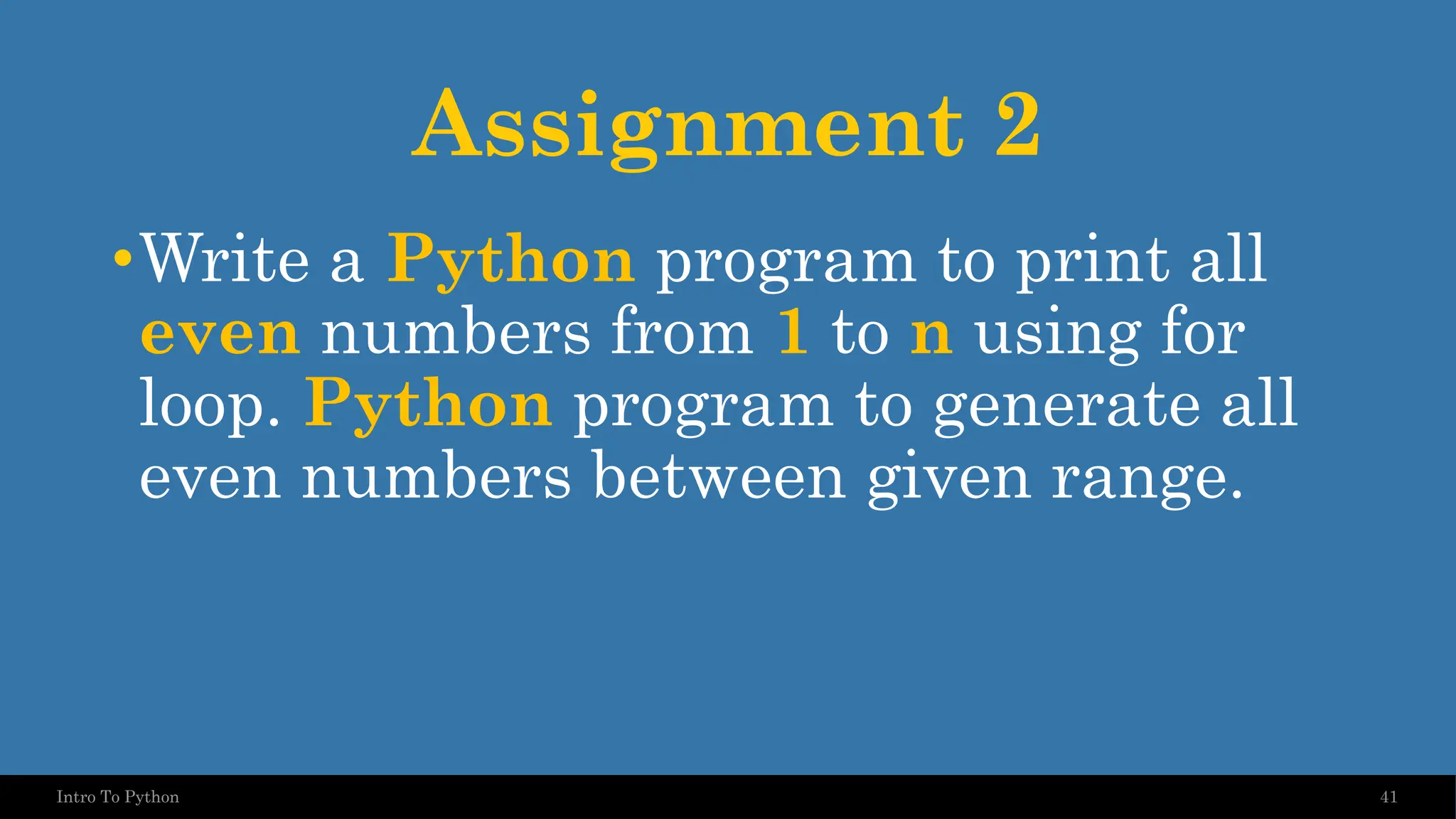
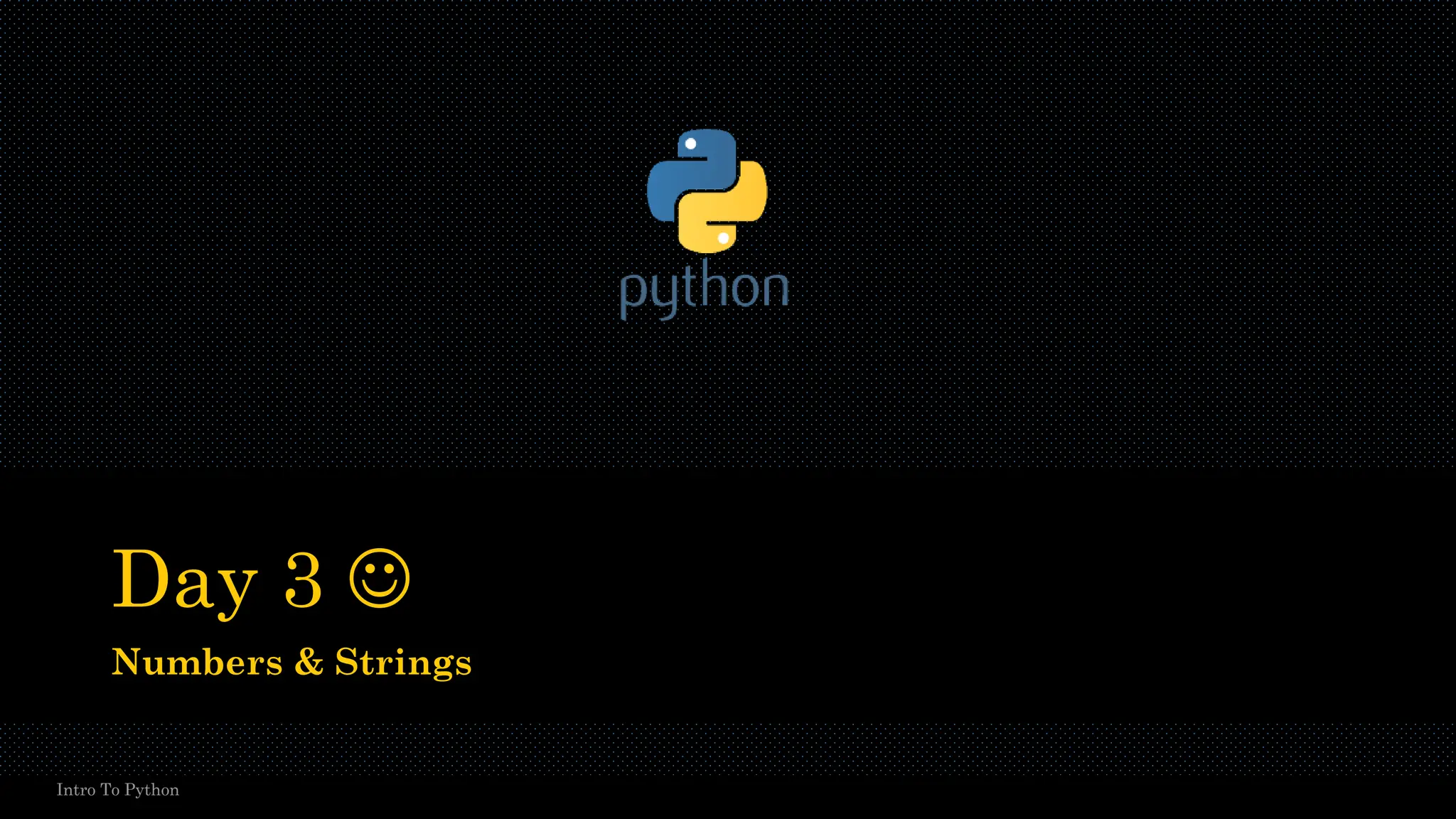
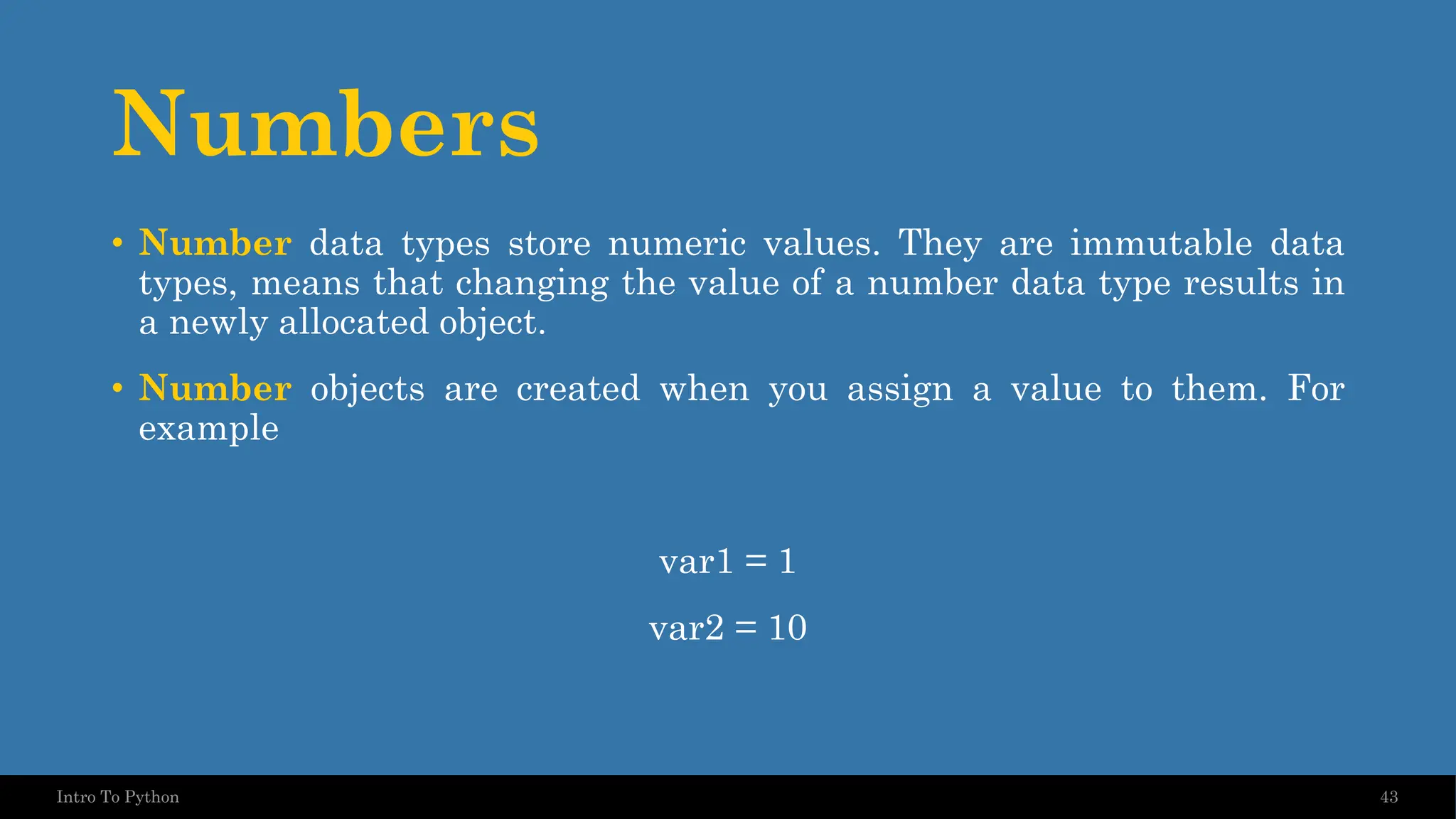
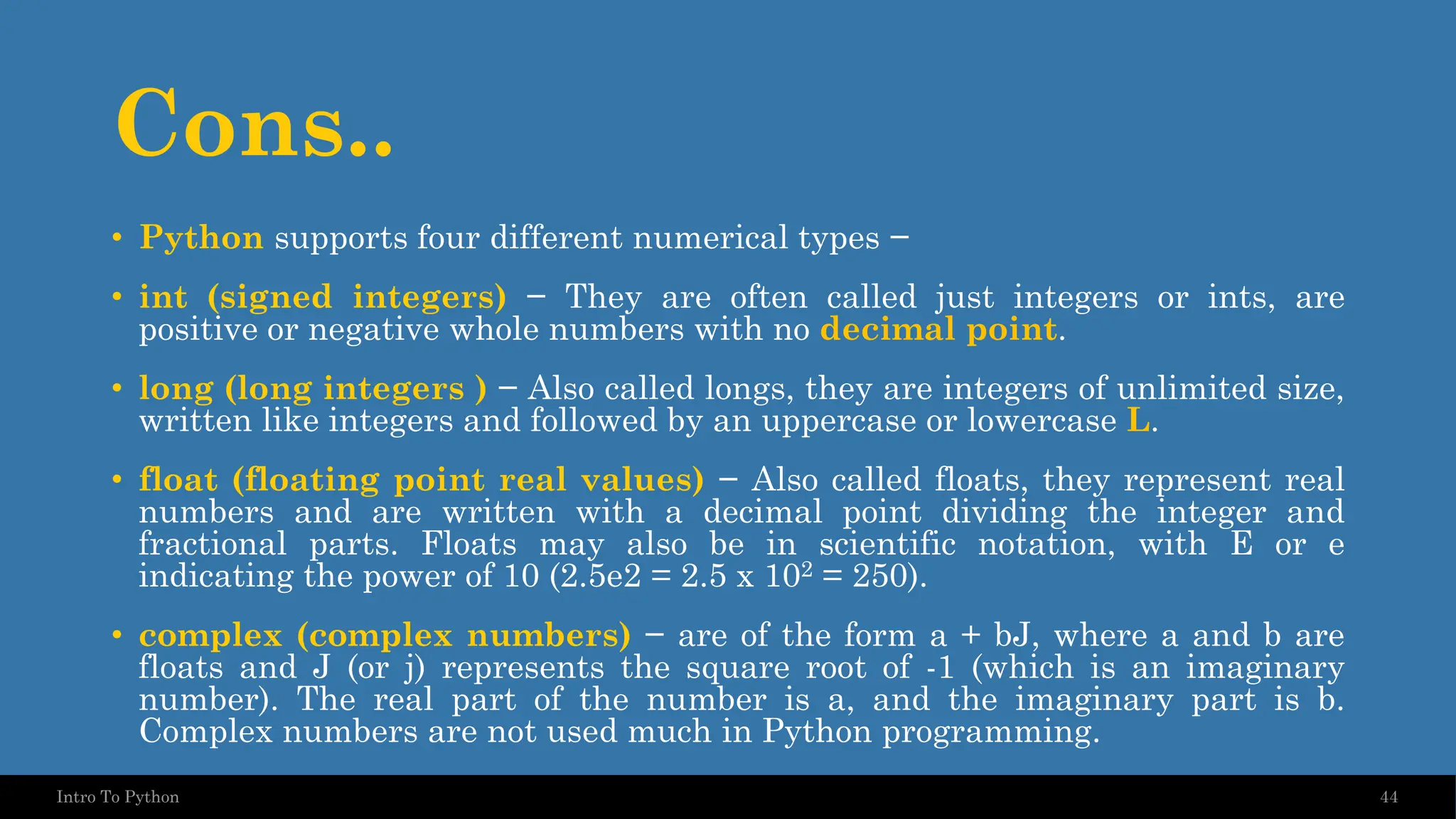
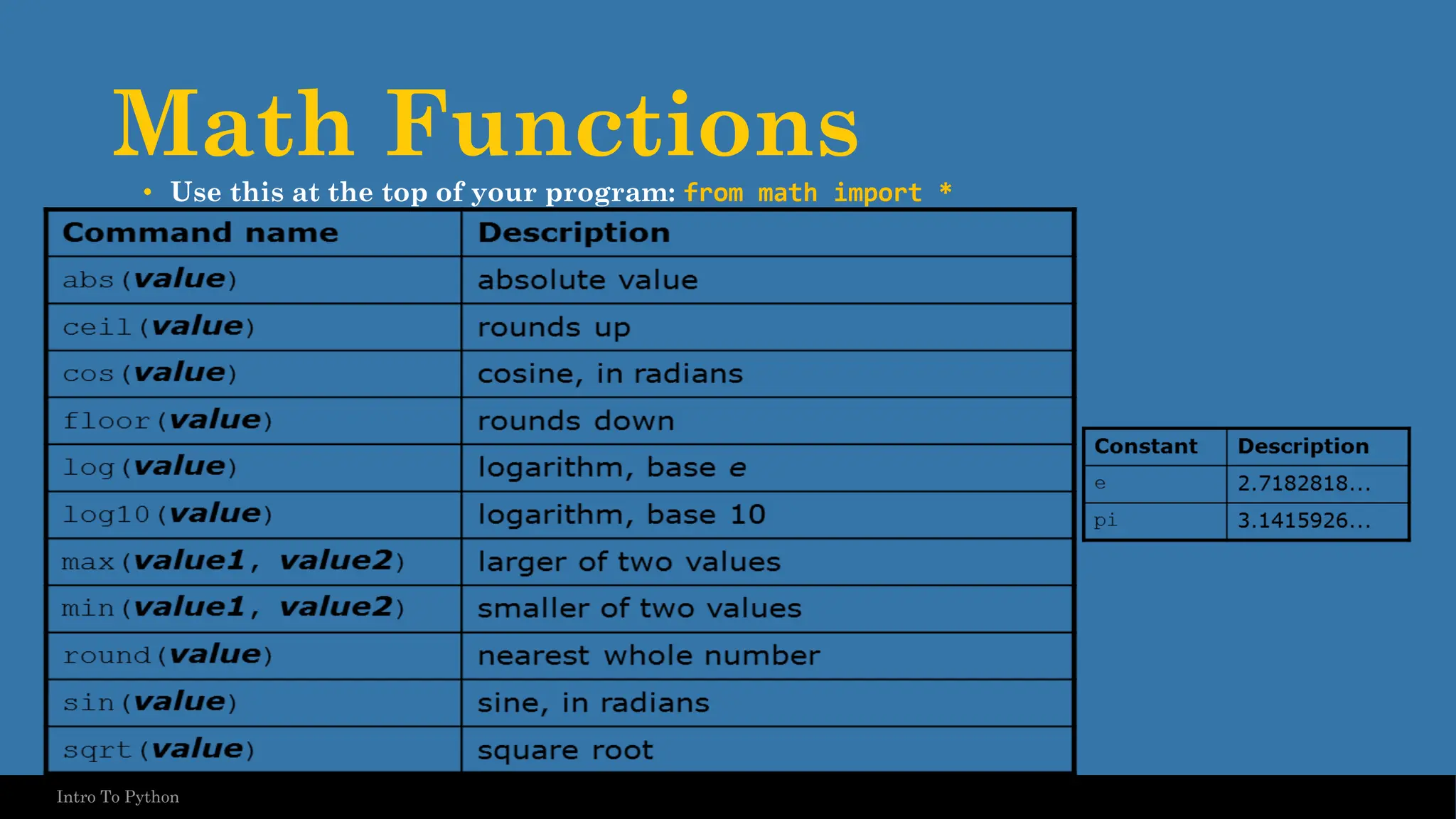
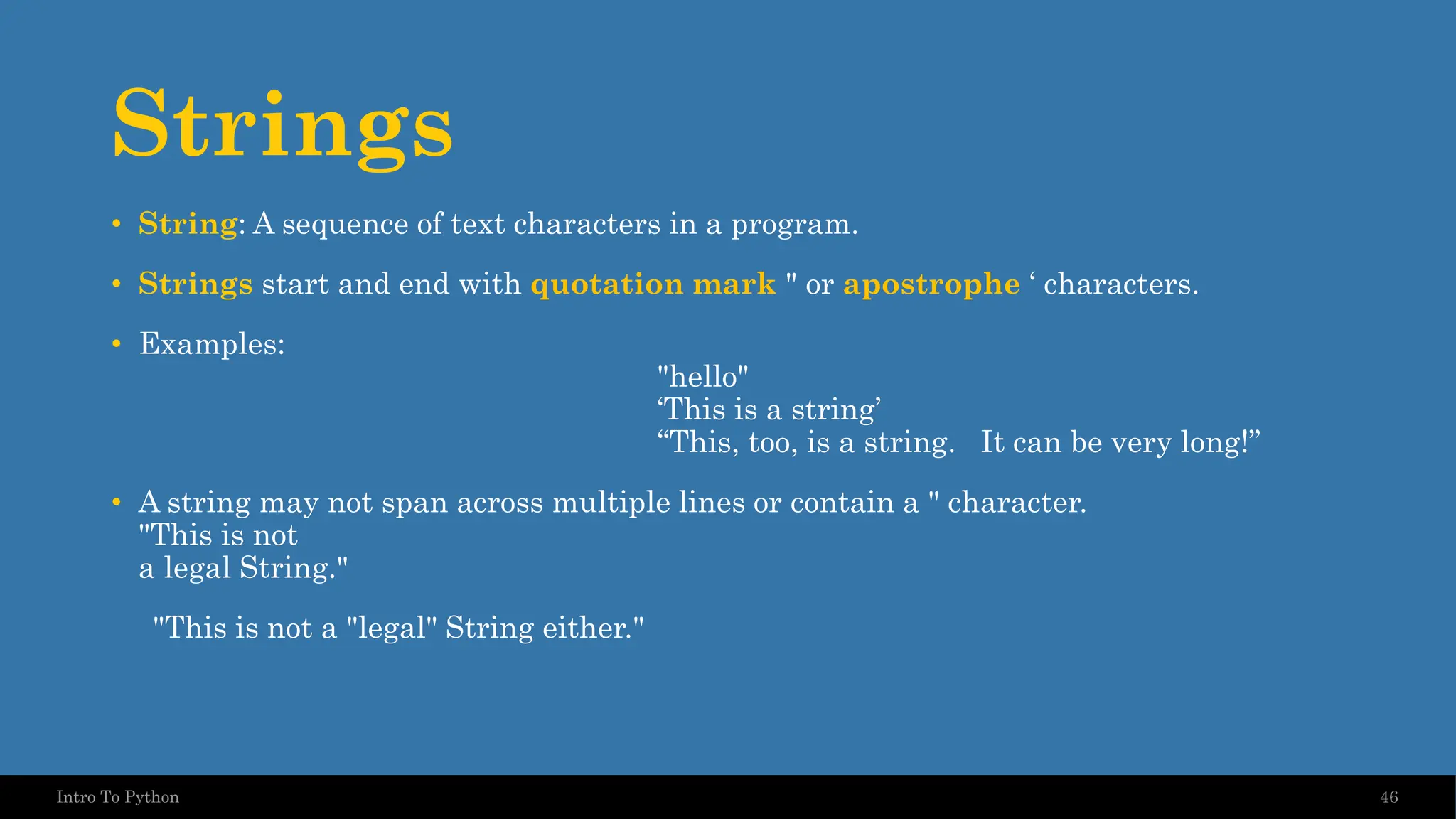
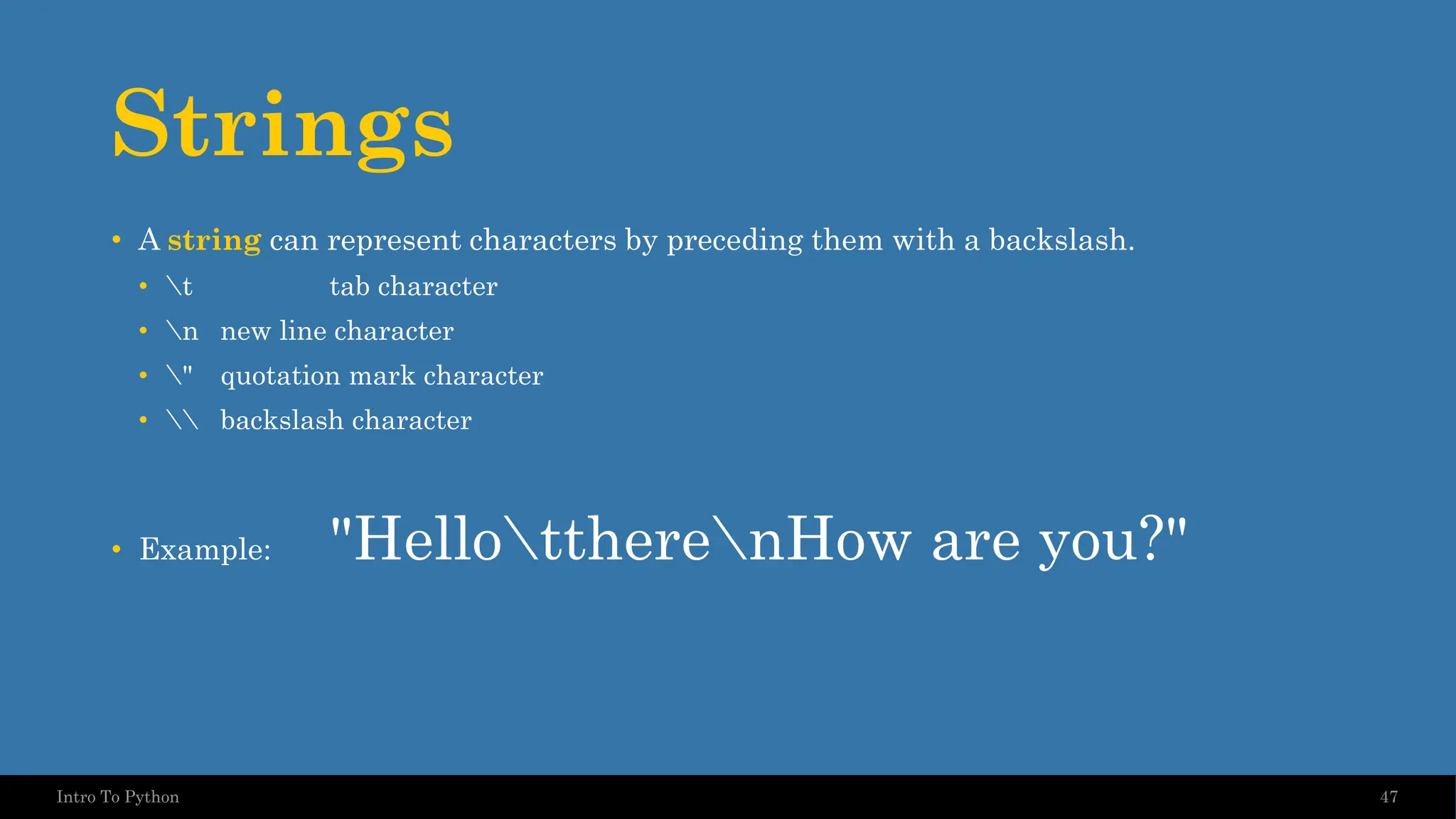
![Indexing Strings ➢As with other languages, you can use square brackets to index a string as if it were an array: name = “John Dove” print(name, “starts with “, name[0]) • Output John Dove starts with J 48 Intro To Python](https://image.slidesharecdn.com/introduction-to-python-240806084550-ac80a512/75/Introduction-to-Python-print-datatype-pdf-48-2048.jpg)
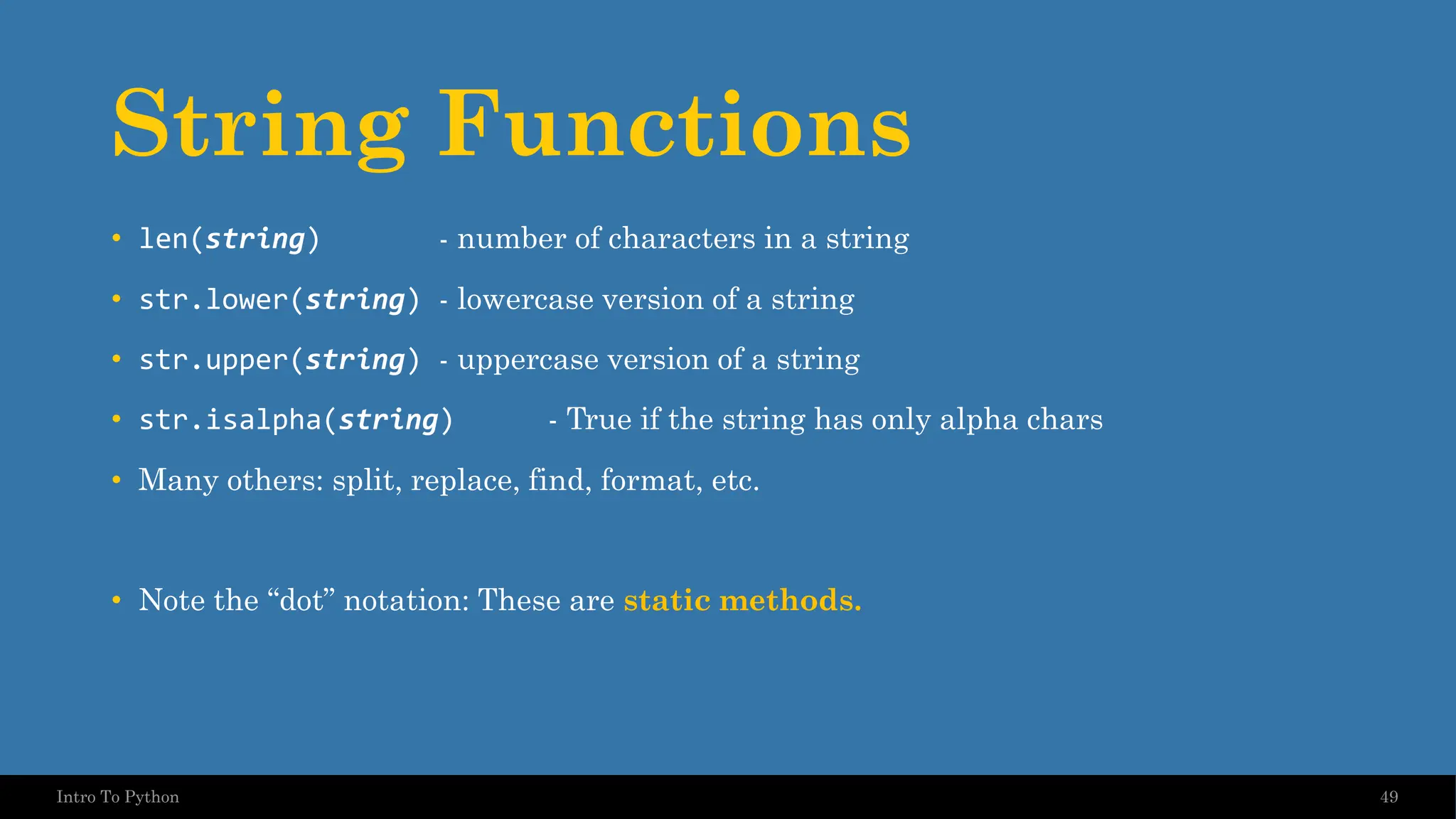
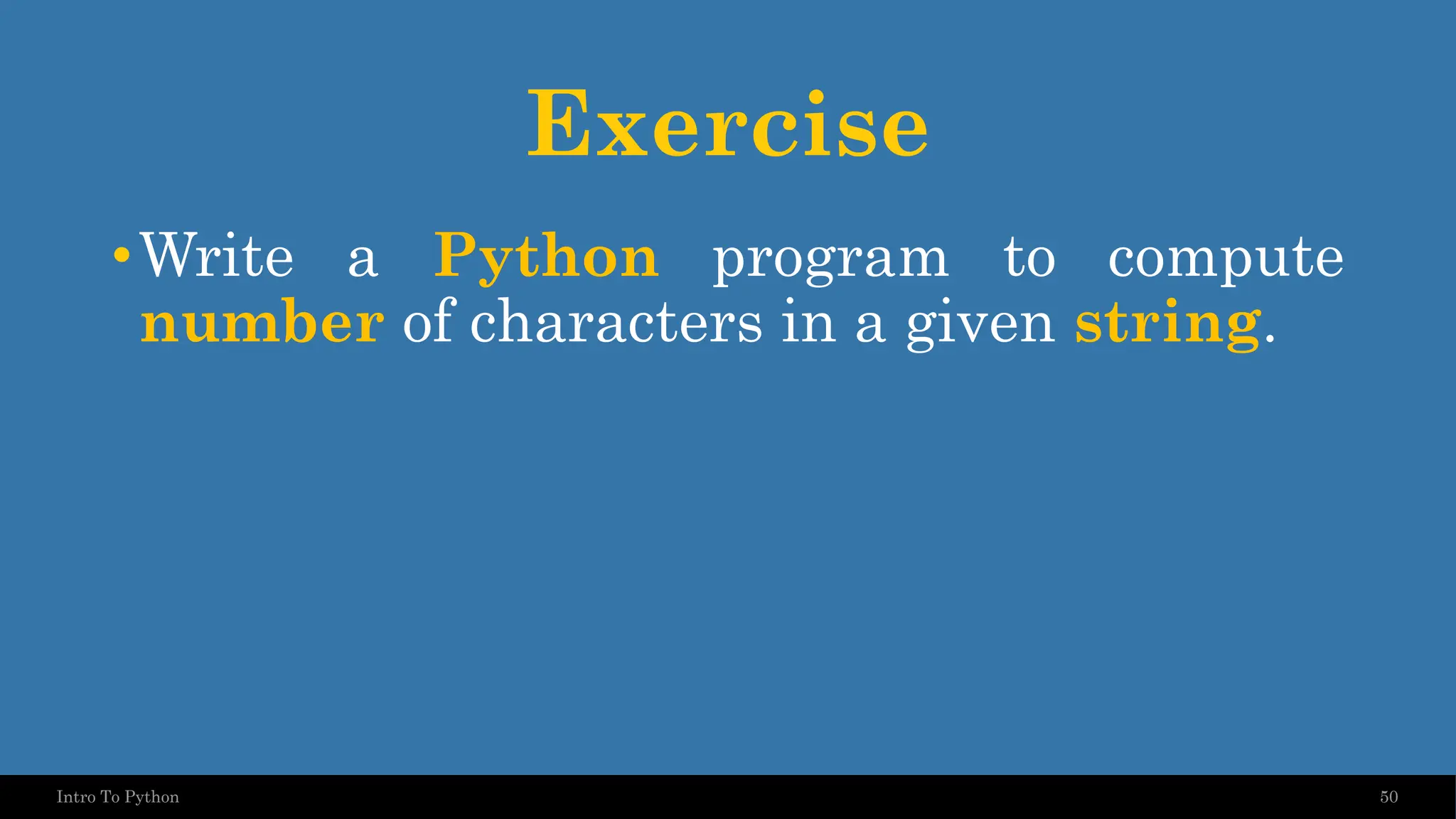
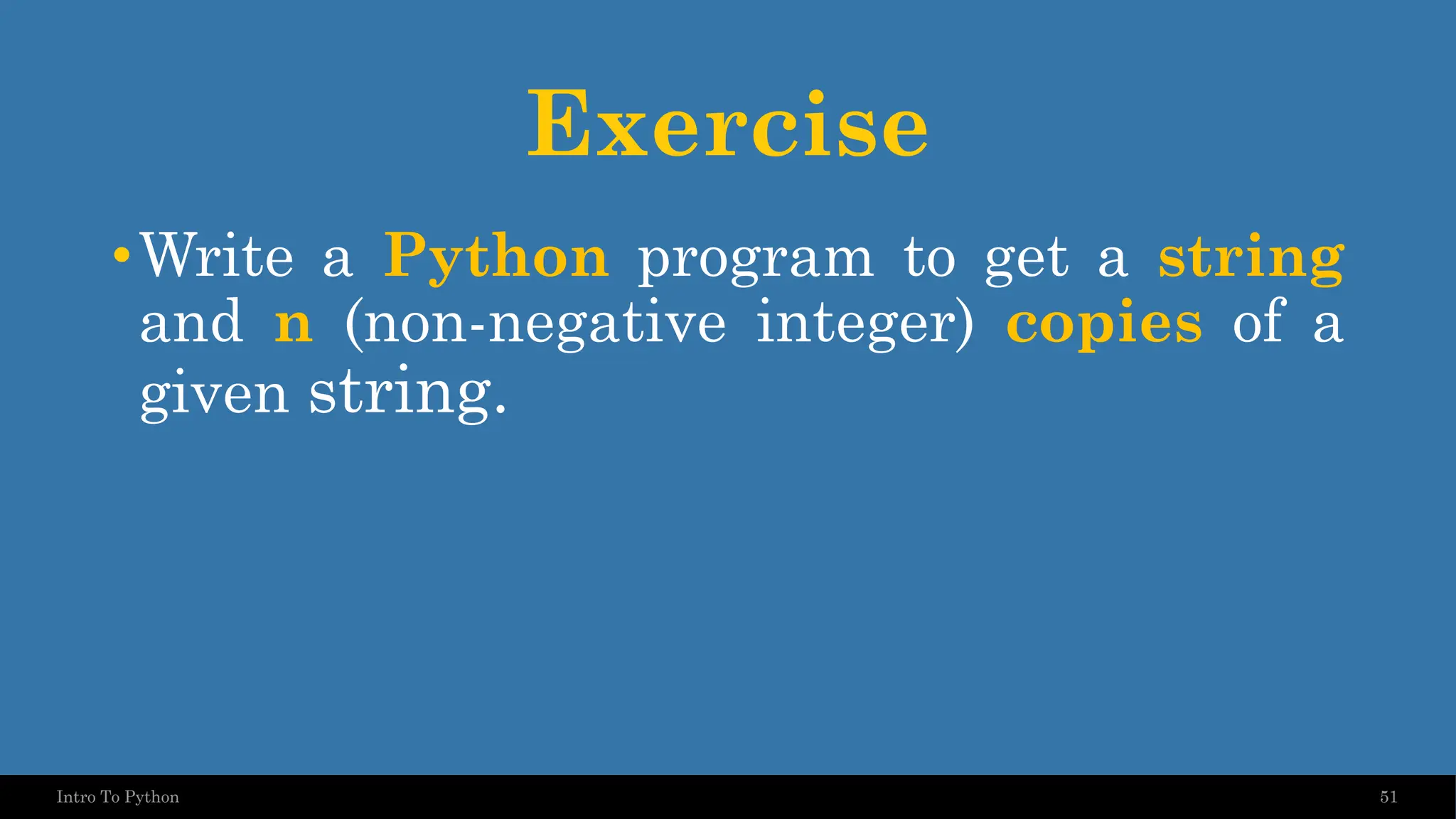
![Exercise •Write a Python program to test whether a passed letter is a vowel or not. •[aeiou] 52 Intro To Python](https://image.slidesharecdn.com/introduction-to-python-240806084550-ac80a512/75/Introduction-to-Python-print-datatype-pdf-52-2048.jpg)
![Lists • The most basic data structure in Python is the sequence. Each element of a sequence is assigned a number - its position or index. The first index is zero, the second index is one, and so forth. • The list is a most versatile datatype available in Python which can be written as a list of comma-separated values (items) between square brackets. Important thing about a list is that items in a list need not be of the same type. ➢list1 = ['physics', 'chemistry', 1997, 2000] ➢list2 = [1, 2, 3, 4, 5 ] 53 Intro To Python](https://image.slidesharecdn.com/introduction-to-python-240806084550-ac80a512/75/Introduction-to-Python-print-datatype-pdf-53-2048.jpg)
![Lists • To access values in lists, use the square brackets for slicing along with the index or indices to obtain value available at that index. For example • list1 = ['physics', 'chemistry', 1997, 2000] • list2 = [1, 2, 3, 4, 5, 6, 7 ] • print ("list1[0]: ", list1[0]) • print ("list2[1:5]: ", list2[1:5]) 54 Intro To Python](https://image.slidesharecdn.com/introduction-to-python-240806084550-ac80a512/75/Introduction-to-Python-print-datatype-pdf-54-2048.jpg)
![Lists • You can update single or multiple elements of lists by giving the slice on the left-hand side of the assignment operator, and you can add to elements in a list with the append() method. For example • list = ['physics', 'chemistry', 1997, 2000]; • print ("Value available at index 2 : “) • print (list[2]) • list[2] = 2001; • print "New value available at index 2 : " • print (list[2]) 55 Intro To Python](https://image.slidesharecdn.com/introduction-to-python-240806084550-ac80a512/75/Introduction-to-Python-print-datatype-pdf-55-2048.jpg)
![Lists • To remove a list element, you can use either the del statement if you know exactly which element(s) you are deleting or the remove() method if you do not know. For example • list1 = ['physics', 'chemistry', 1997, 2000]; • print (list1) • del (list1[2]) • print ("After deleting value at index 2 : “) • print (list1) 56 Intro To Python](https://image.slidesharecdn.com/introduction-to-python-240806084550-ac80a512/75/Introduction-to-Python-print-datatype-pdf-56-2048.jpg)
![Basic Lists Operation Python Expression Results Description len([1, 2, 3]) 3 Length [1, 2, 3] + [4, 5, 6] [1, 2, 3, 4, 5, 6] Concatenation ['Hi!'] * 4 ['Hi!', 'Hi!', 'Hi!', 'Hi!'] Repetition 3 in [1, 2, 3] True Membership for x in [1, 2, 3]: print x, 1 2 3 Iteration 57 Intro To Python](https://image.slidesharecdn.com/introduction-to-python-240806084550-ac80a512/75/Introduction-to-Python-print-datatype-pdf-57-2048.jpg)
![Indexing, Slicing, and Matrixes 58 • L = ['spam', 'Spam', 'SPAM!’] Python Expression Results Description L[2] SPAM! Offsets start at zero L[-2] Spam Negative: count from the right L[1:] ['Spam', 'SPAM!'] Slicing fetches sections Intro To Python](https://image.slidesharecdn.com/introduction-to-python-240806084550-ac80a512/75/Introduction-to-Python-print-datatype-pdf-58-2048.jpg)
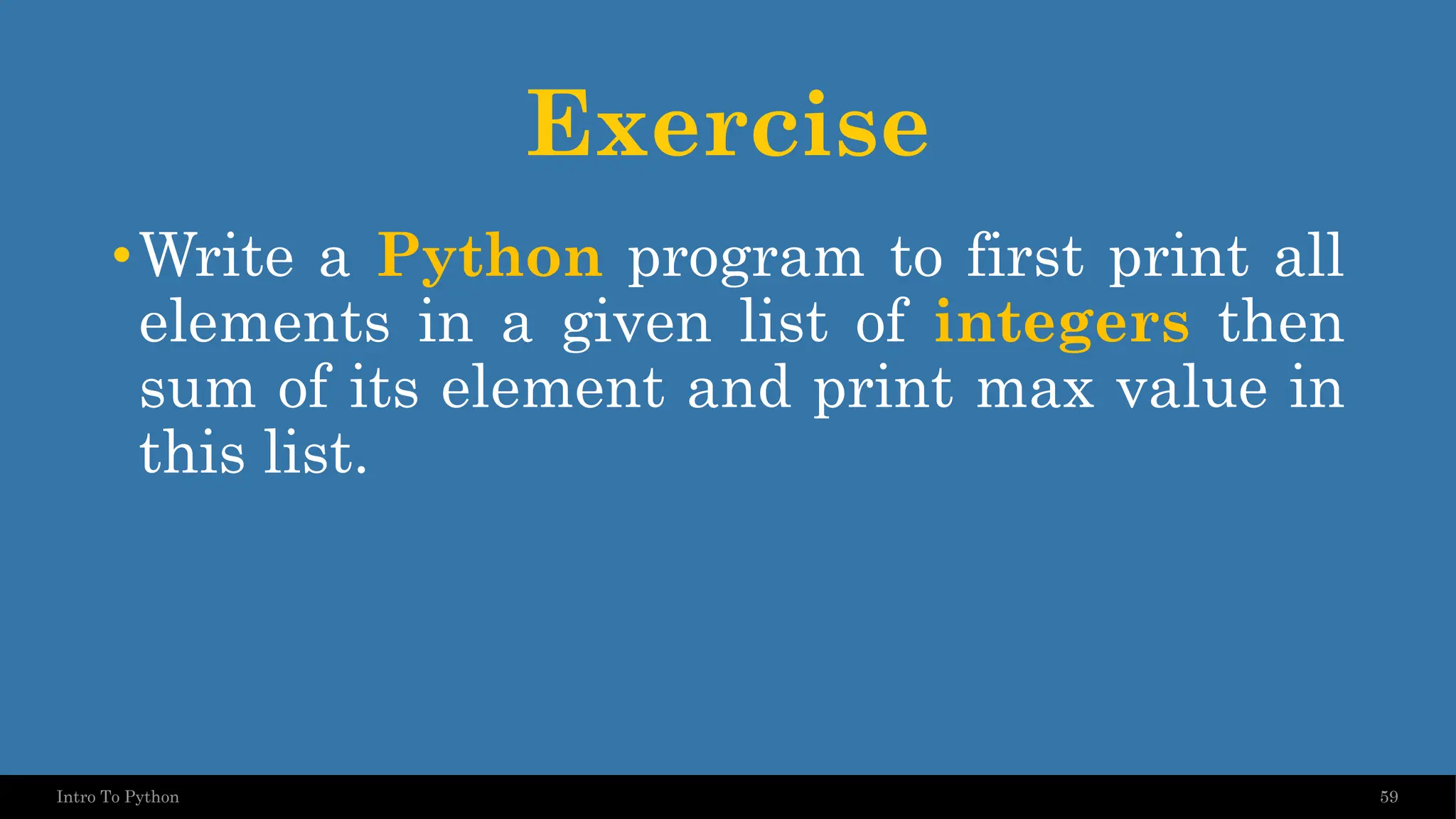
![Exercise •Write a Python program to create a histogram from a given list of integers. • Ex. [6,3,7] • ****** • *** • ******* 60 Intro To Python](https://image.slidesharecdn.com/introduction-to-python-240806084550-ac80a512/75/Introduction-to-Python-print-datatype-pdf-60-2048.jpg)
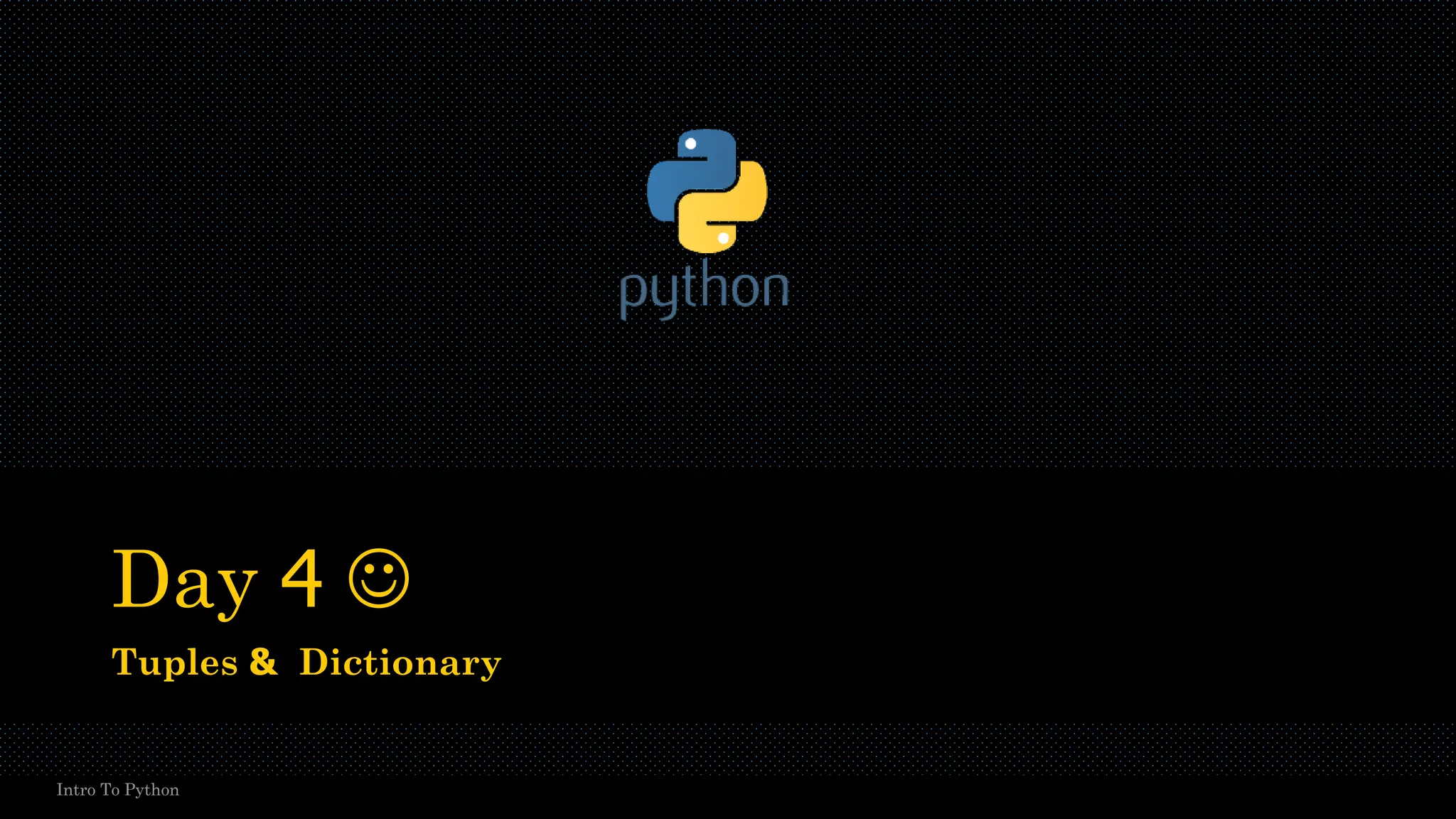
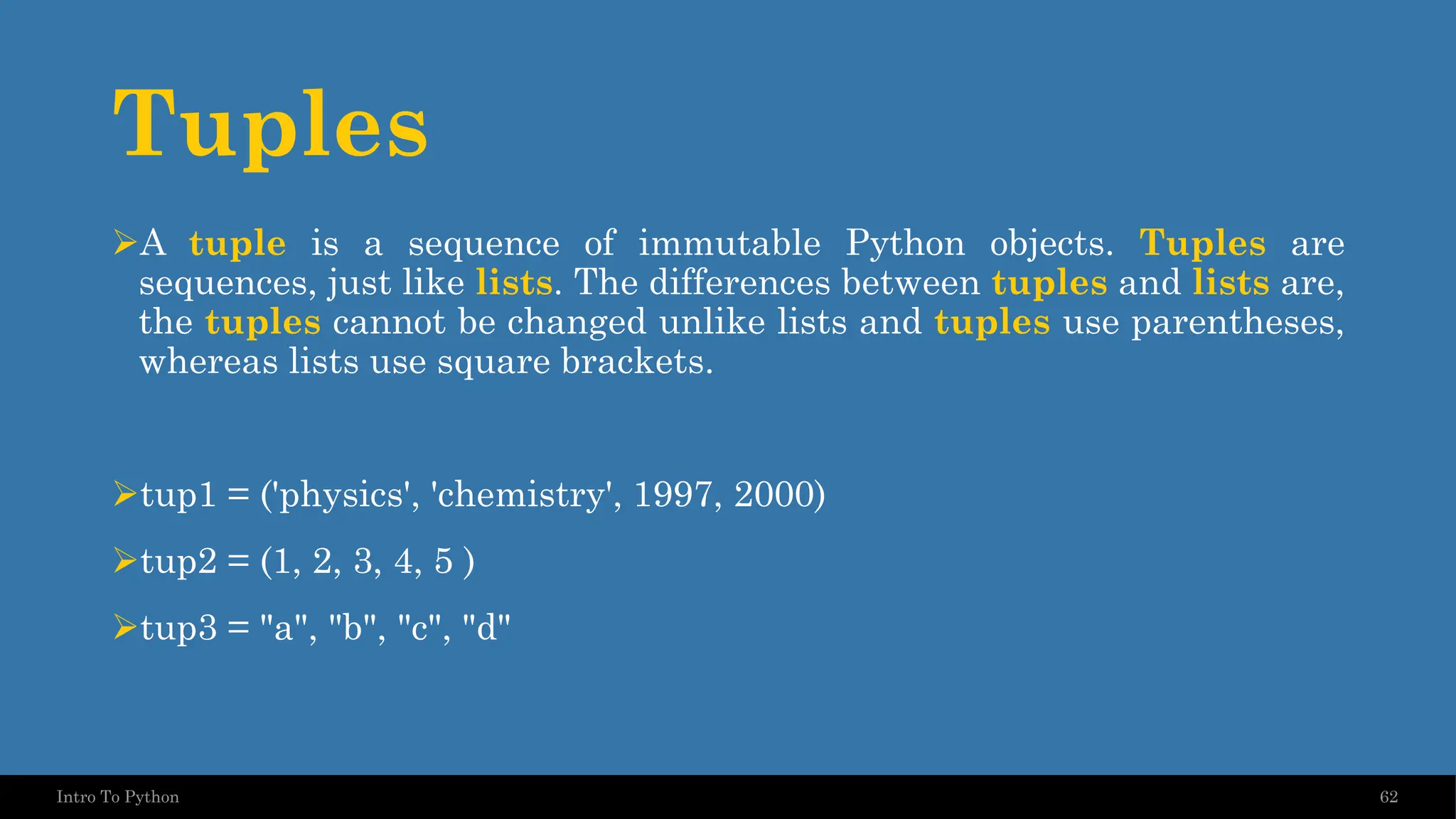
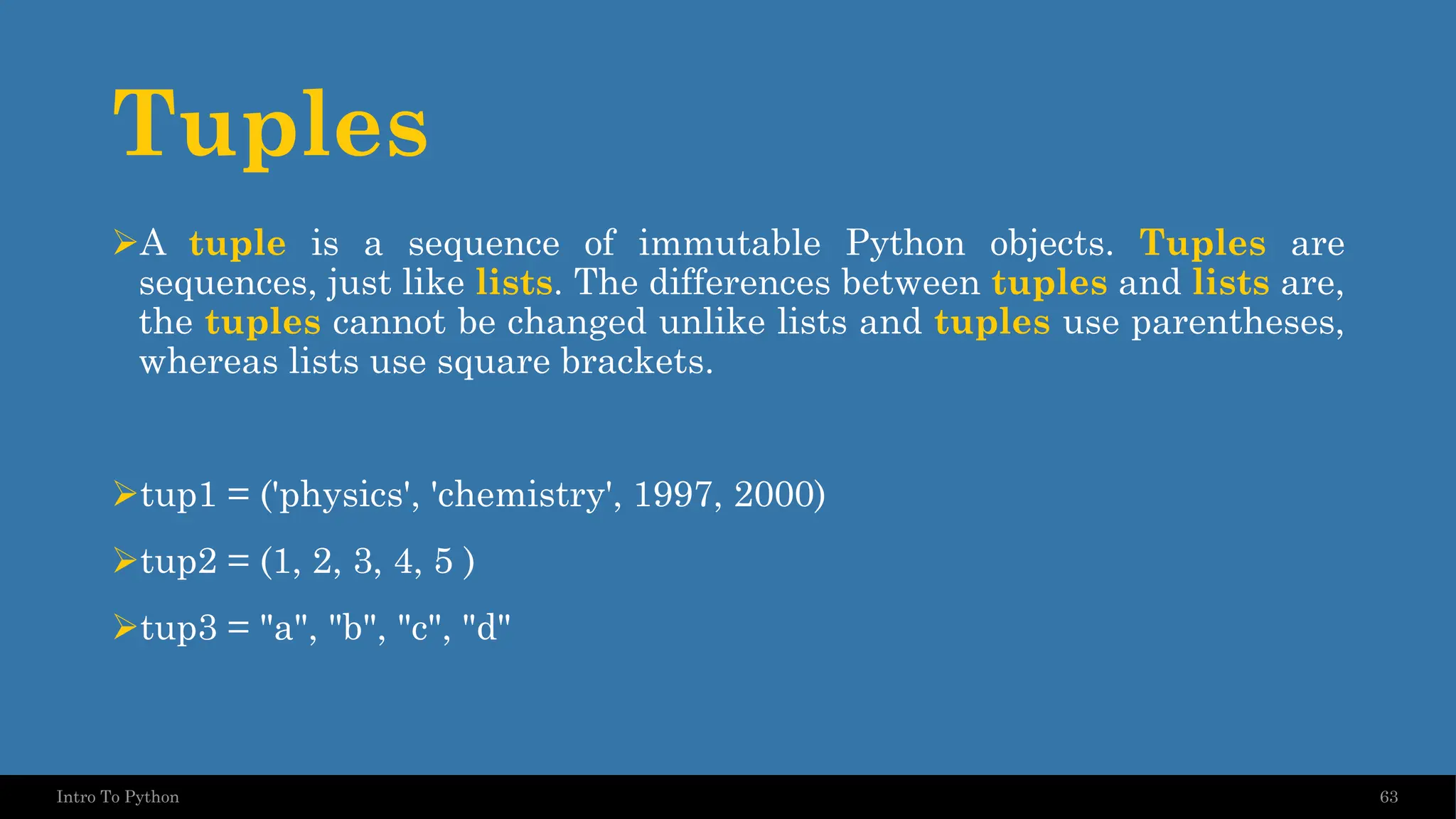
![Accessing Values in Tuples ➢To access values in tuple, use the square brackets for slicing along with the index or indices to obtain value available at that index. ➢tup1 = ('physics', 'chemistry', 1997, 2000) ➢tup2 = (1, 2, 3, 4, 5, 6, 7 ) ➢print "tup1[0]: ", tup1[0] ➢print "tup2[1:5]: ", tup2[1:5] 64 Intro To Python](https://image.slidesharecdn.com/introduction-to-python-240806084550-ac80a512/75/Introduction-to-Python-print-datatype-pdf-64-2048.jpg)
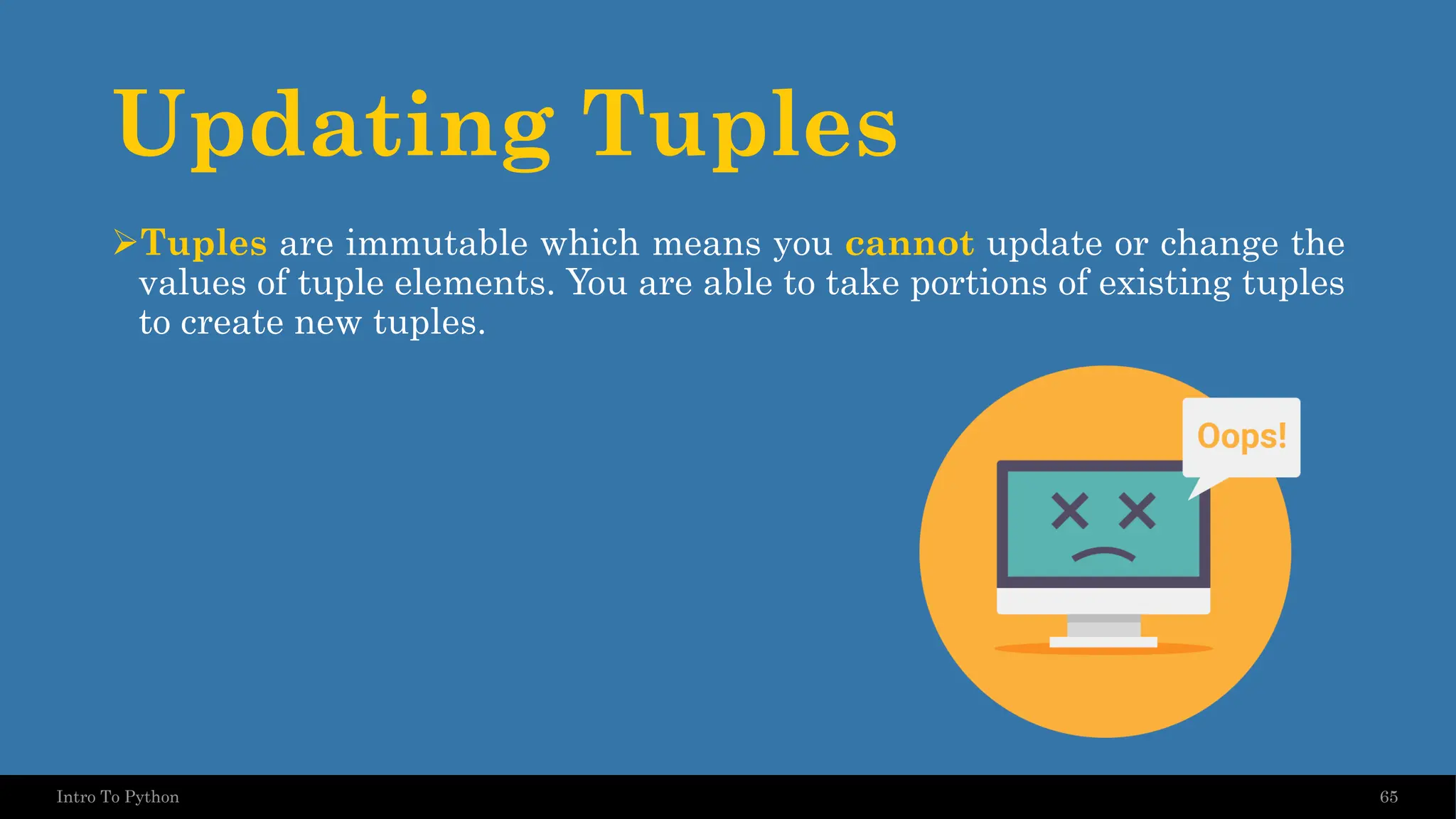
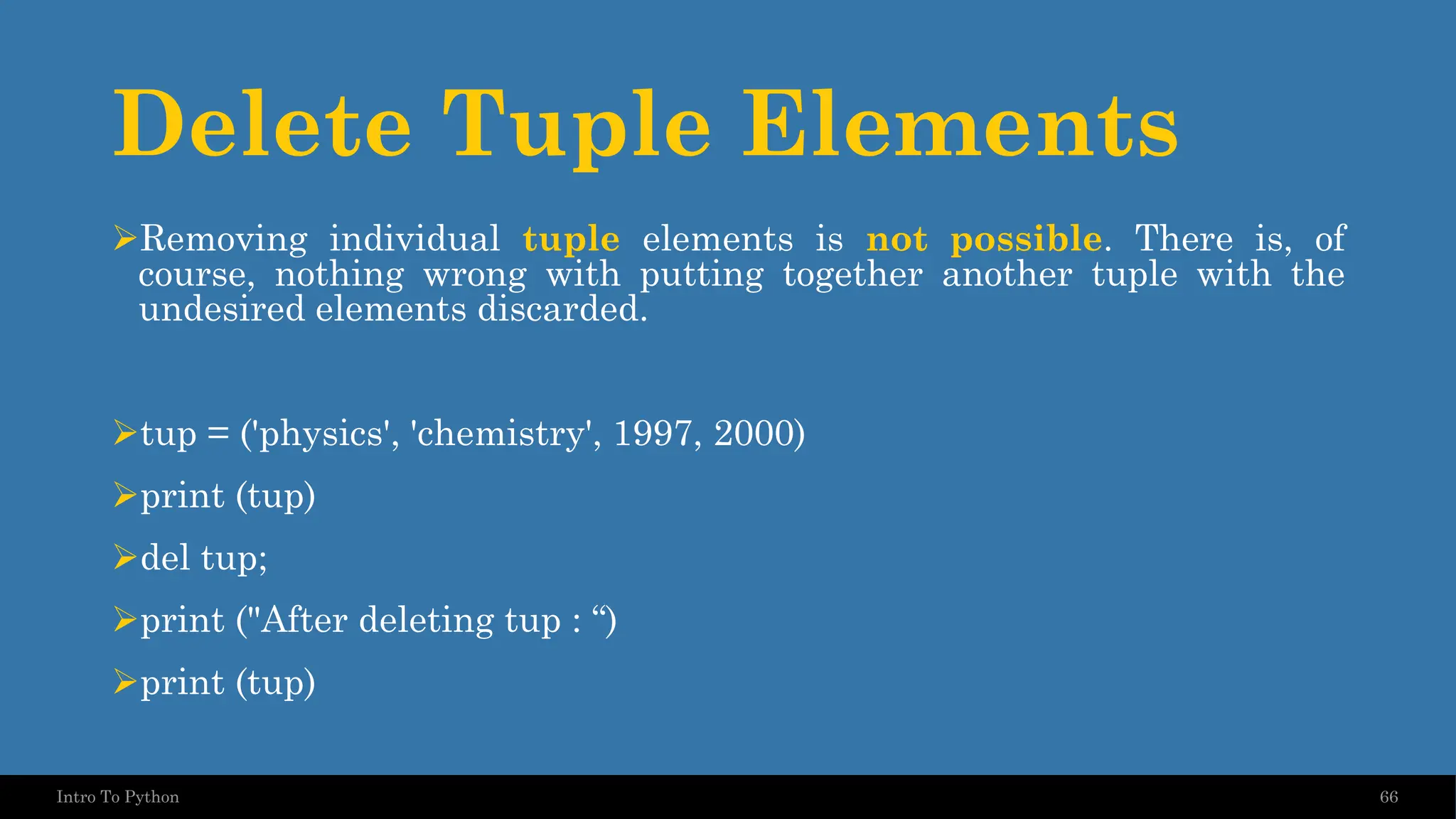
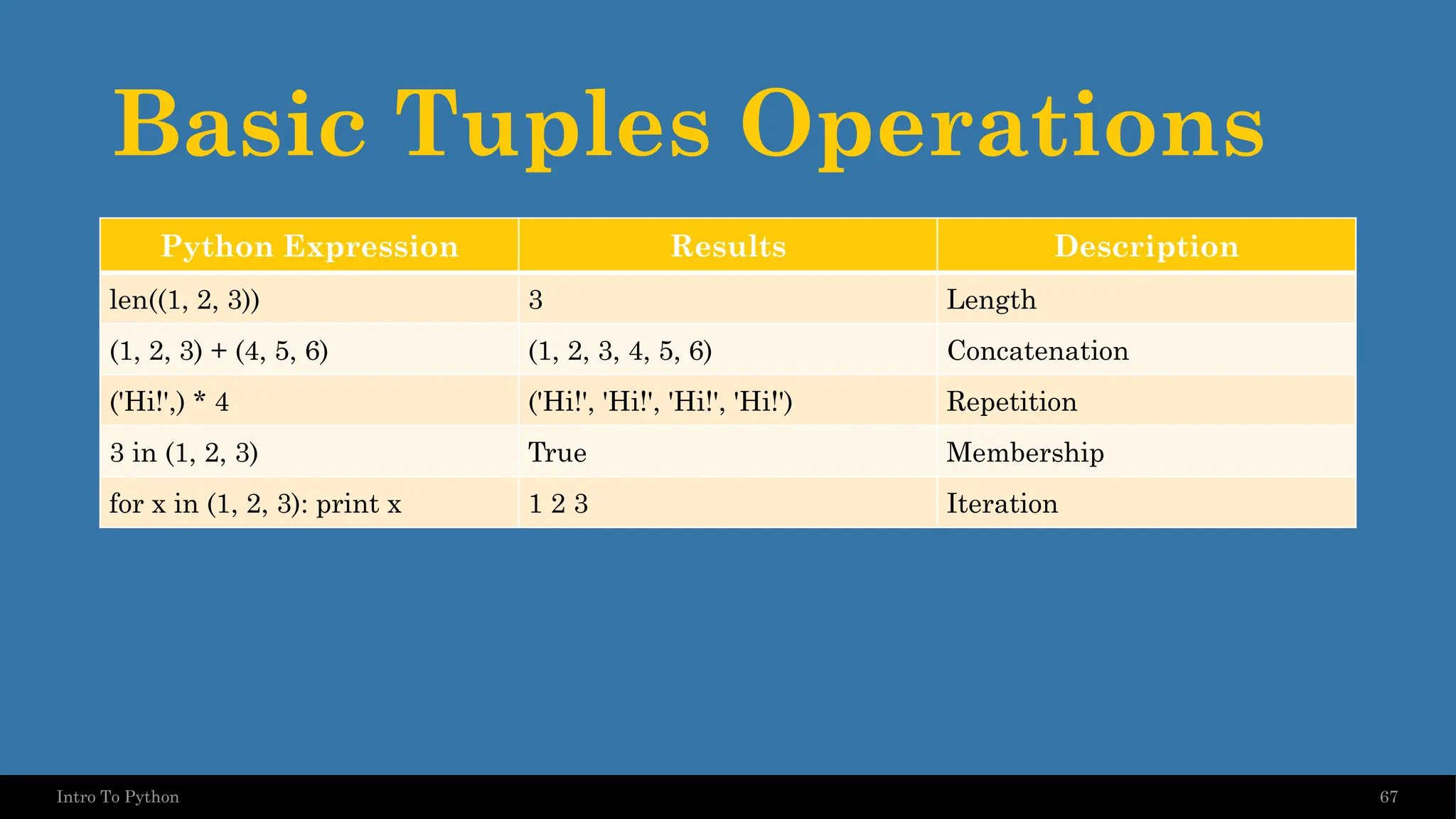
![Indexing, Slicing, and Matrixes 68 • L = ('spam', 'Spam', 'SPAM!') Python Expression Results Description L[2] SPAM! Offsets start at zero L[-2] Spam Negative: count from the right L[1:] ['Spam', 'SPAM!'] Slicing fetches sections Intro To Python](https://image.slidesharecdn.com/introduction-to-python-240806084550-ac80a512/75/Introduction-to-Python-print-datatype-pdf-68-2048.jpg)
![Dictionaries ➢A dictionary is a data type similar to arrays, but works with keys and values instead of indexes. Each value stored in a dictionary can be accessed using a key, which is any type of object (a string, a number, a list, etc.) instead of using its index to address it. Keys are unique within a dictionary while values may not be. The values of a dictionary can be of any type, but the keys must be of an immutable data type such as strings, numbers, or tuples. ➢dict = {'Name': 'Zara', 'Age': 7, 'Class': 'First'} ➢print "dict['Name']: ", dict['Name'] ➢print "dict['Age']: ", dict['Age'] 69 Intro To Python](https://image.slidesharecdn.com/introduction-to-python-240806084550-ac80a512/75/Introduction-to-Python-print-datatype-pdf-69-2048.jpg)
![Updating Dictionary ➢You can update a dictionary by adding a new entry or a key-value pair, modifying an existing entry, or deleting an existing entry. ➢dict = {'Name': 'Zara', 'Age': 7, 'Class': 'First'} ➢dict['Age'] = 8; # update existing entry ➢dict['School'] = "DPS School"; # Add new entry ➢print "dict['Age']: ", dict['Age'] ➢print "dict['School']: ", dict['School'] 70 Intro To Python](https://image.slidesharecdn.com/introduction-to-python-240806084550-ac80a512/75/Introduction-to-Python-print-datatype-pdf-70-2048.jpg)
![Delete Dictionary Elements ➢You can either remove individual dictionary elements or clear the entire contents of a dictionary. You can also delete entire dictionary in a single operation. ➢dict = {'Name': 'Zara', 'Age': 7, 'Class': 'First'} ➢del dict['Name']; # remove entry with key 'Name' ➢dict.clear() # remove all entries in dict ➢del dict # delete entire dictionary ➢print "dict['Age']: ", dict['Age'] ➢print "dict['School']: ", dict['School'] 71 Intro To Python](https://image.slidesharecdn.com/introduction-to-python-240806084550-ac80a512/75/Introduction-to-Python-print-datatype-pdf-71-2048.jpg)
![Properties of Dictionary Keys ➢Dictionary values have no restrictions. They can be any arbitrary Python object, either standard objects or user-defined objects. However, same is not true for the keys. ➢There are two important points to remember about dictionary keys : ➢(a) More than one entry per key not allowed. Which means no duplicate key is allowed. When duplicate keys encountered during assignment, the last assignment wins. ➢ (b) Keys must be immutable. Which means you can use strings, numbers or tuples as dictionary keys but something like ['key'] is not allowed 72 Intro To Python](https://image.slidesharecdn.com/introduction-to-python-240806084550-ac80a512/75/Introduction-to-Python-print-datatype-pdf-72-2048.jpg)
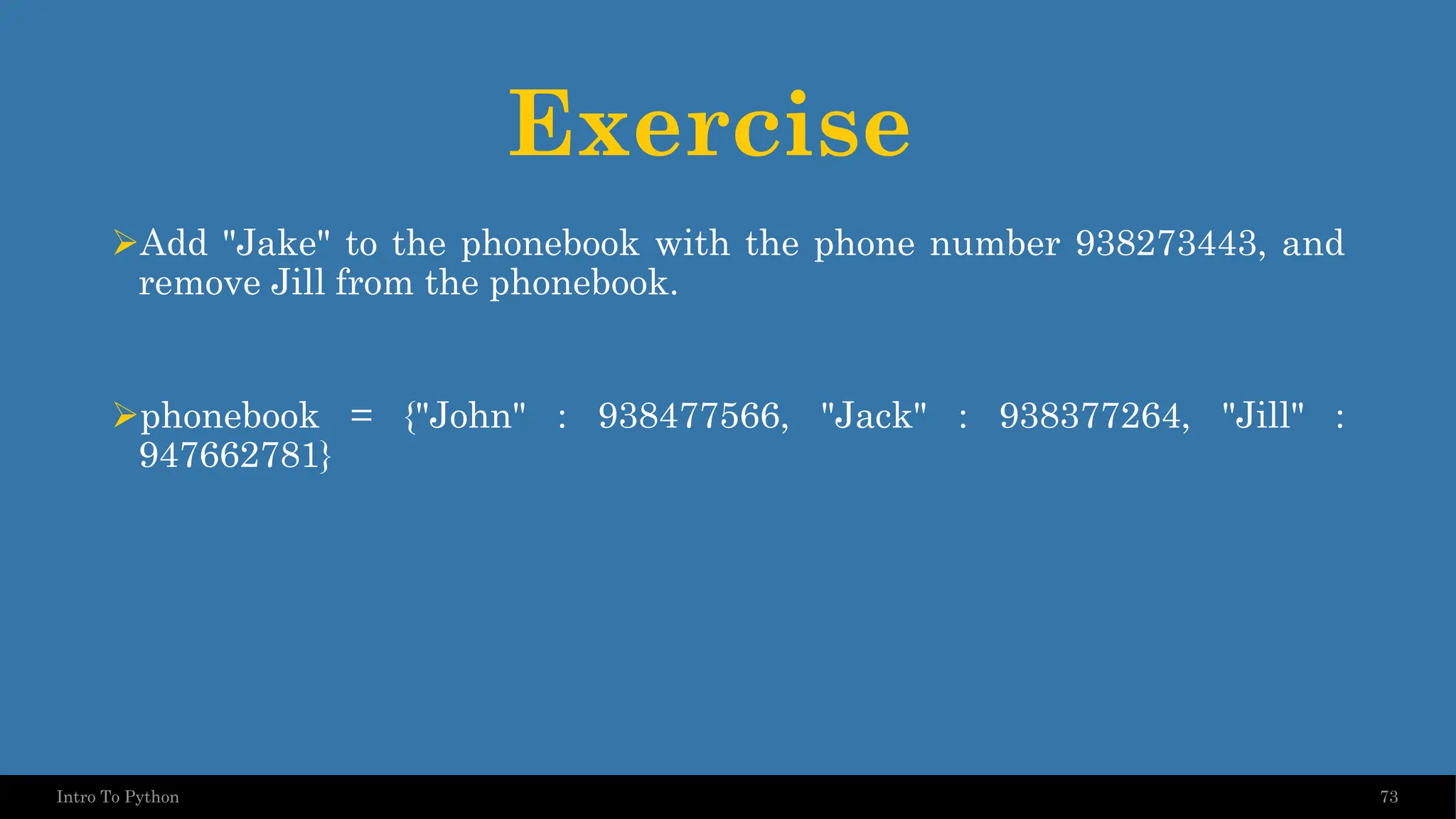
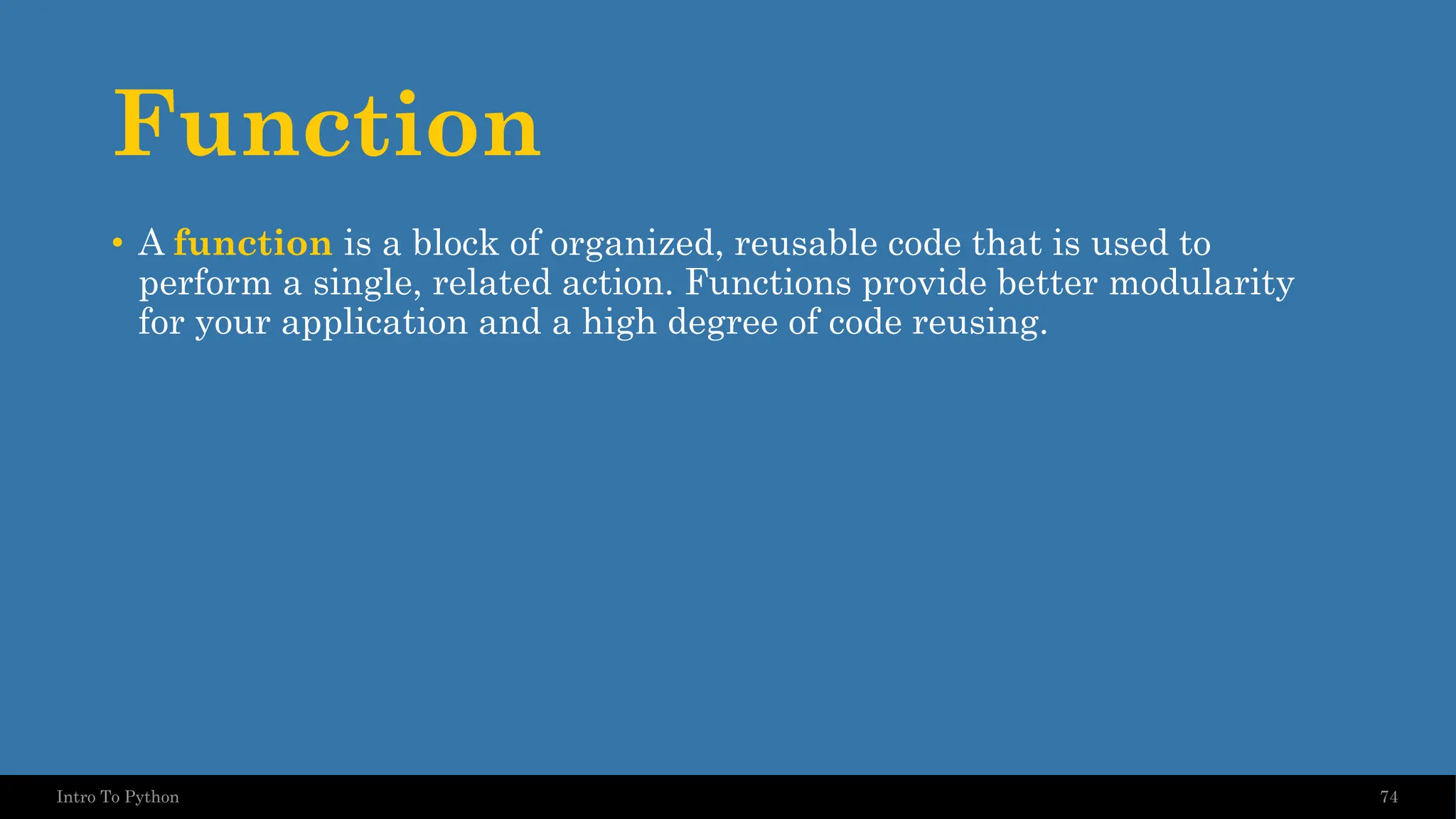
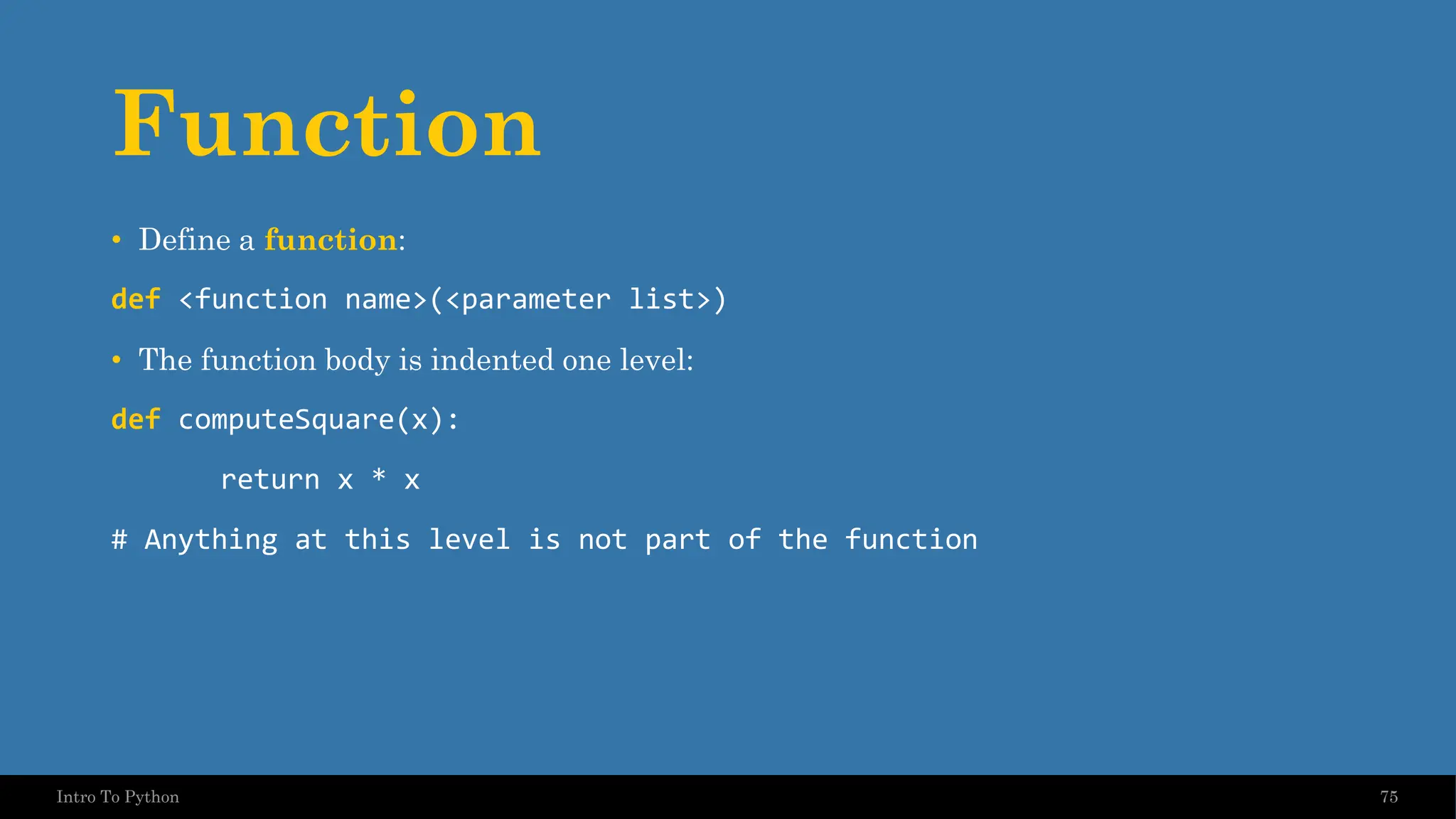
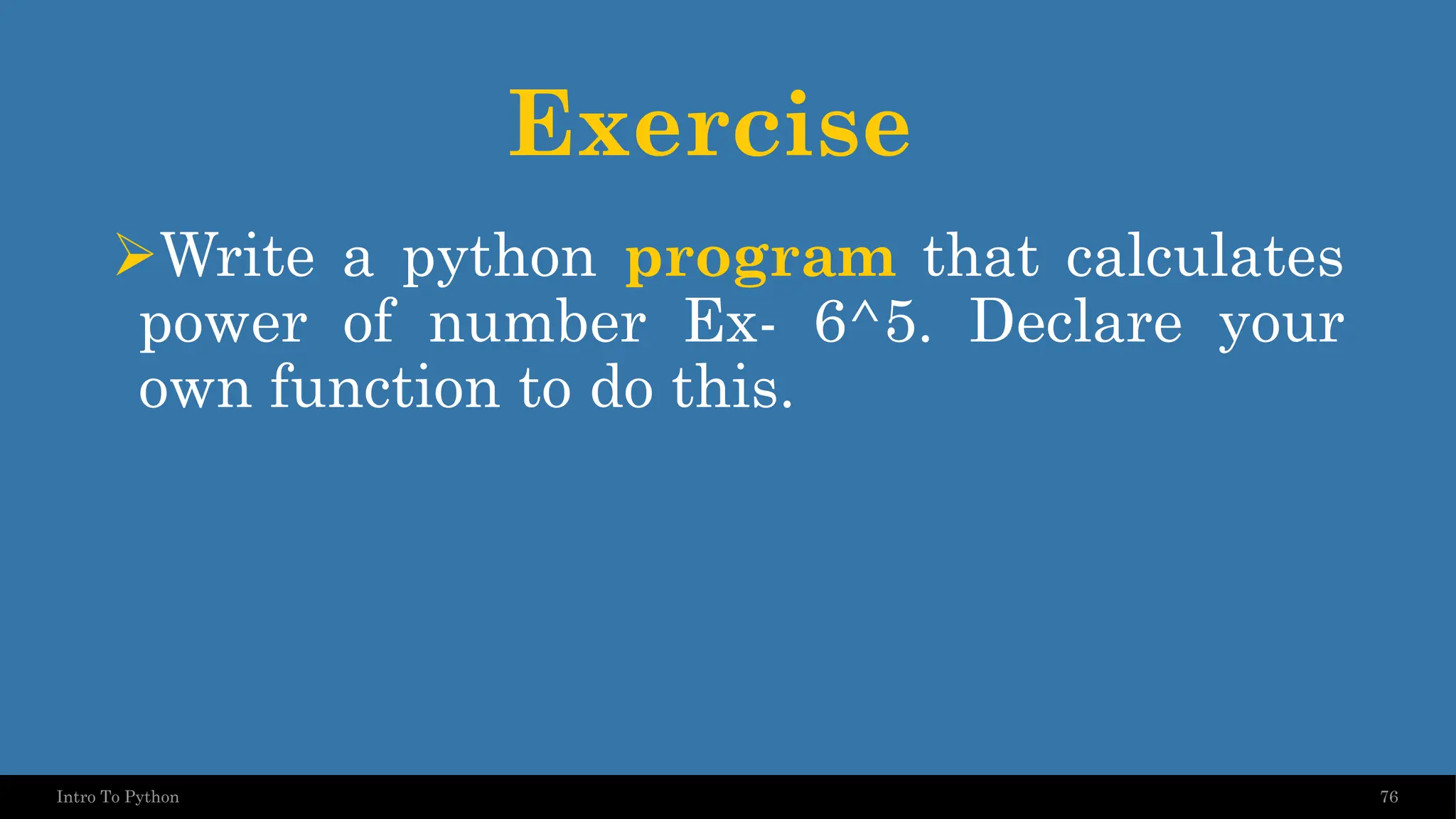
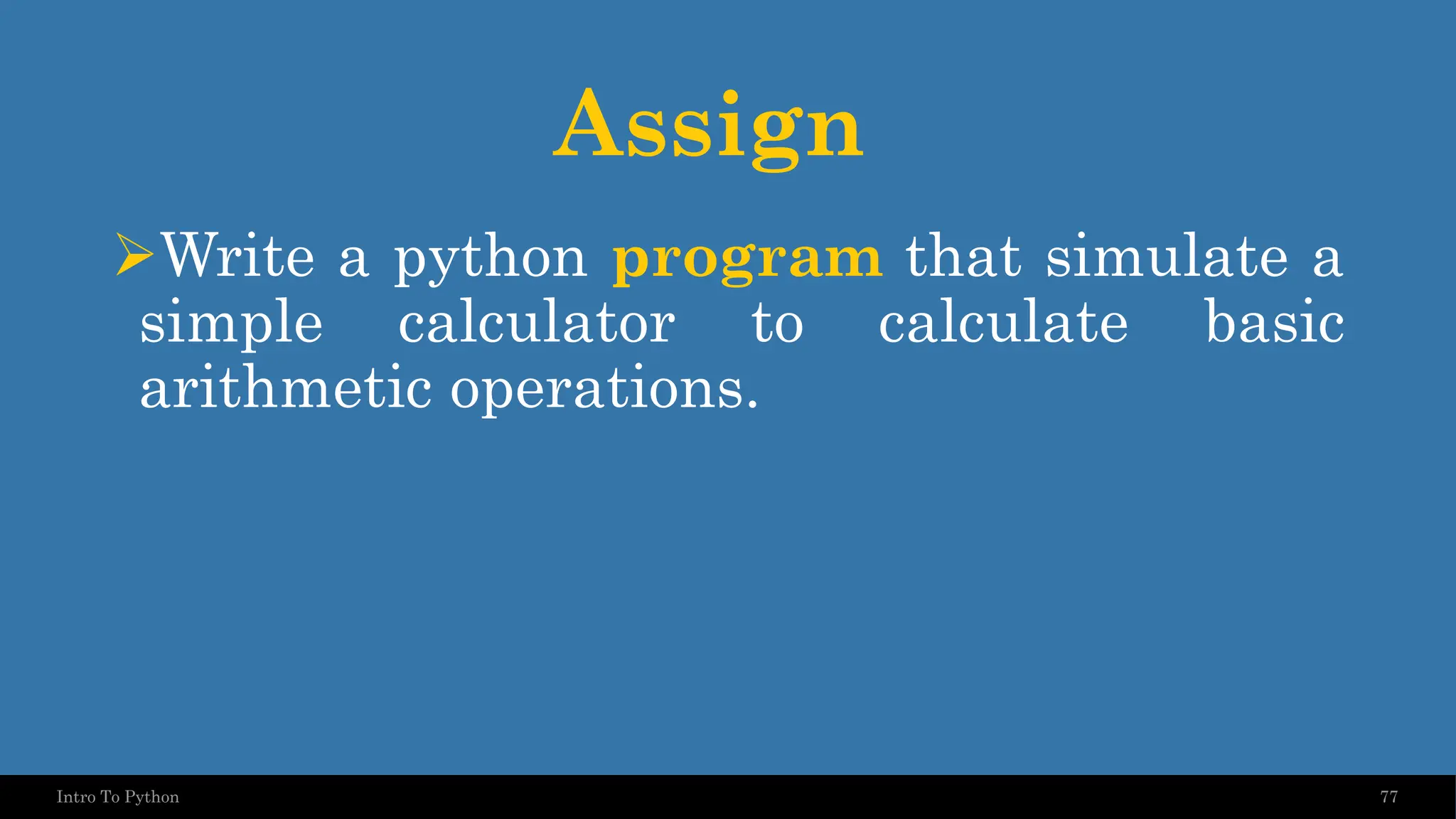
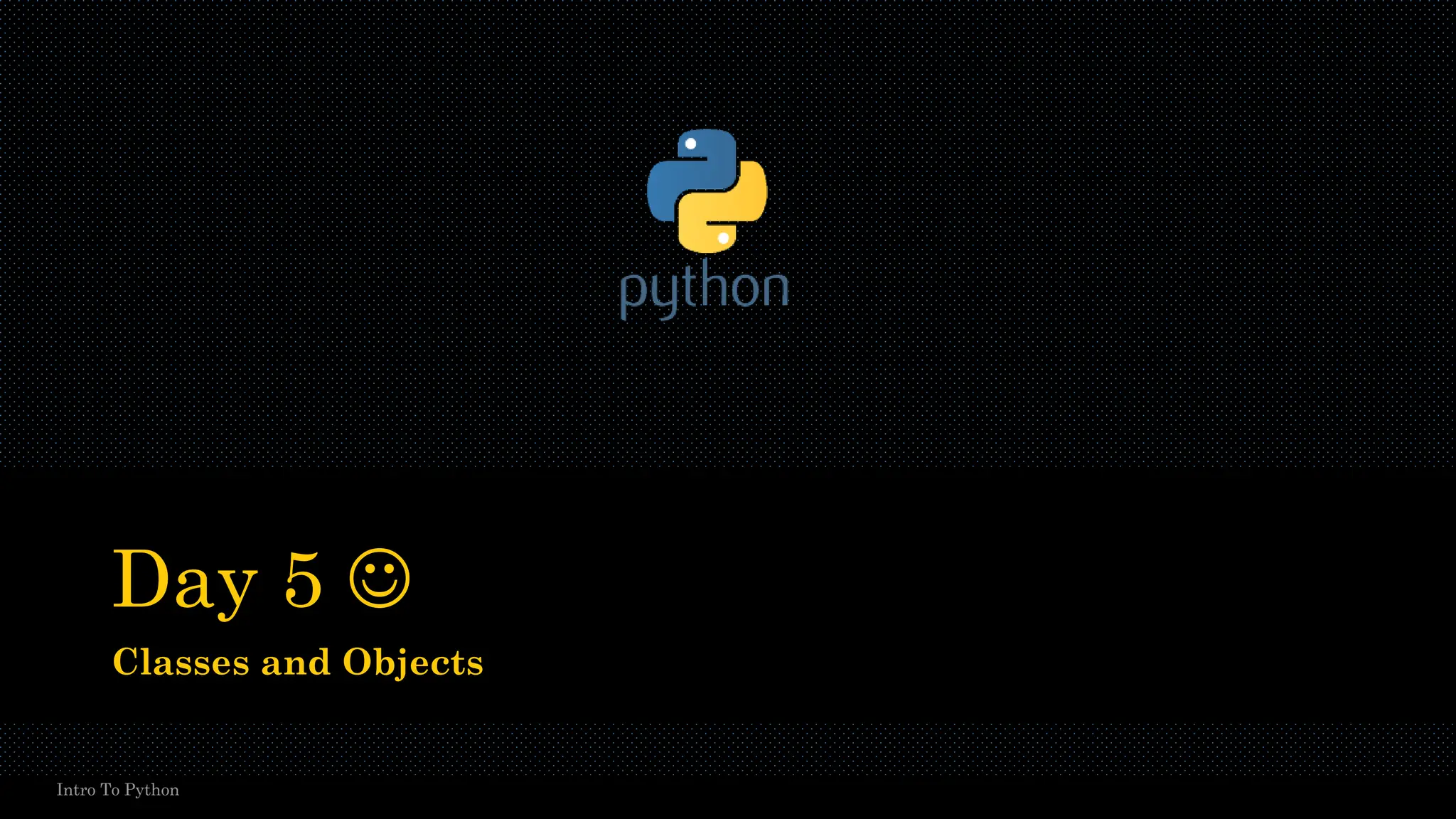
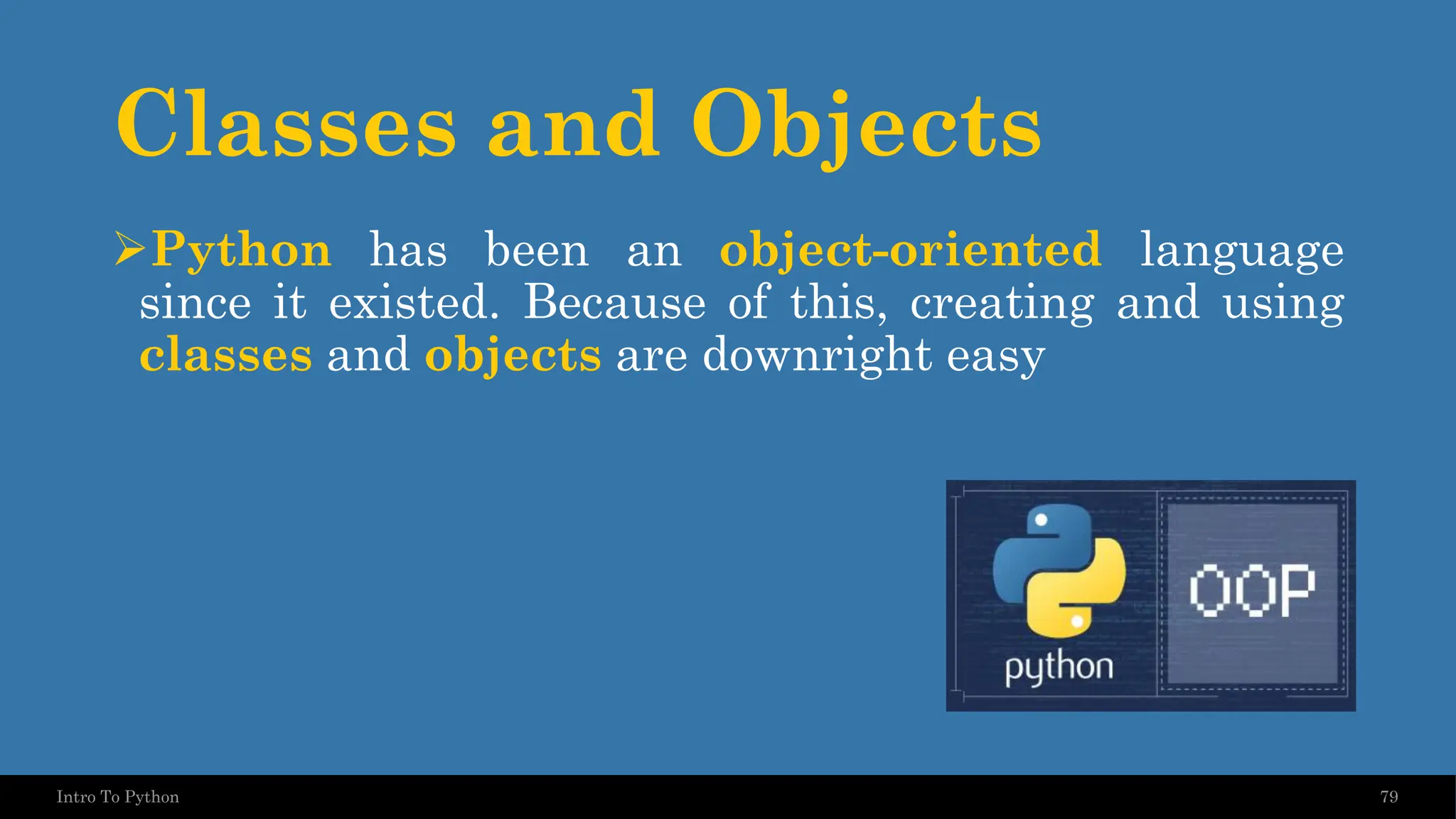
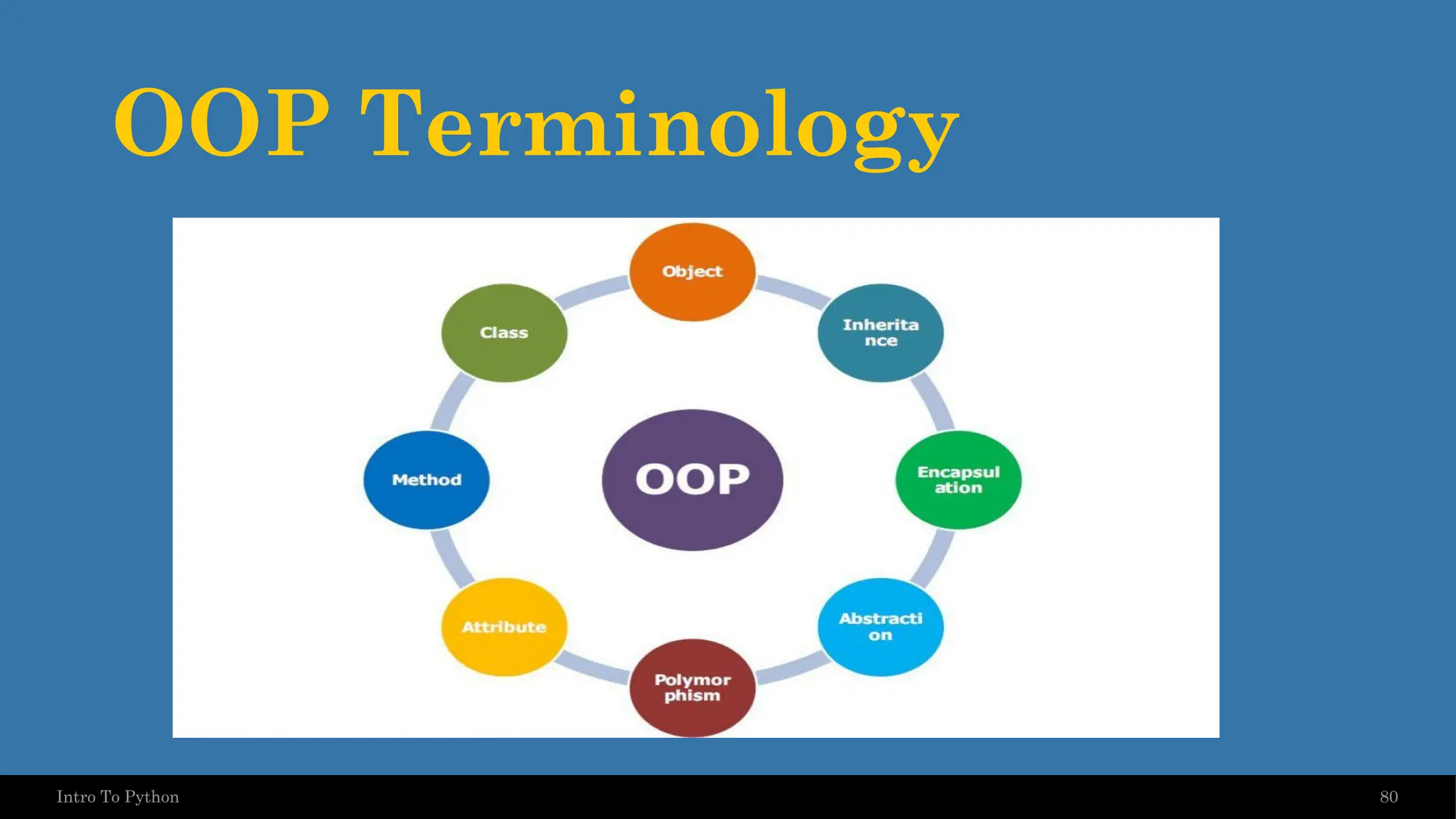
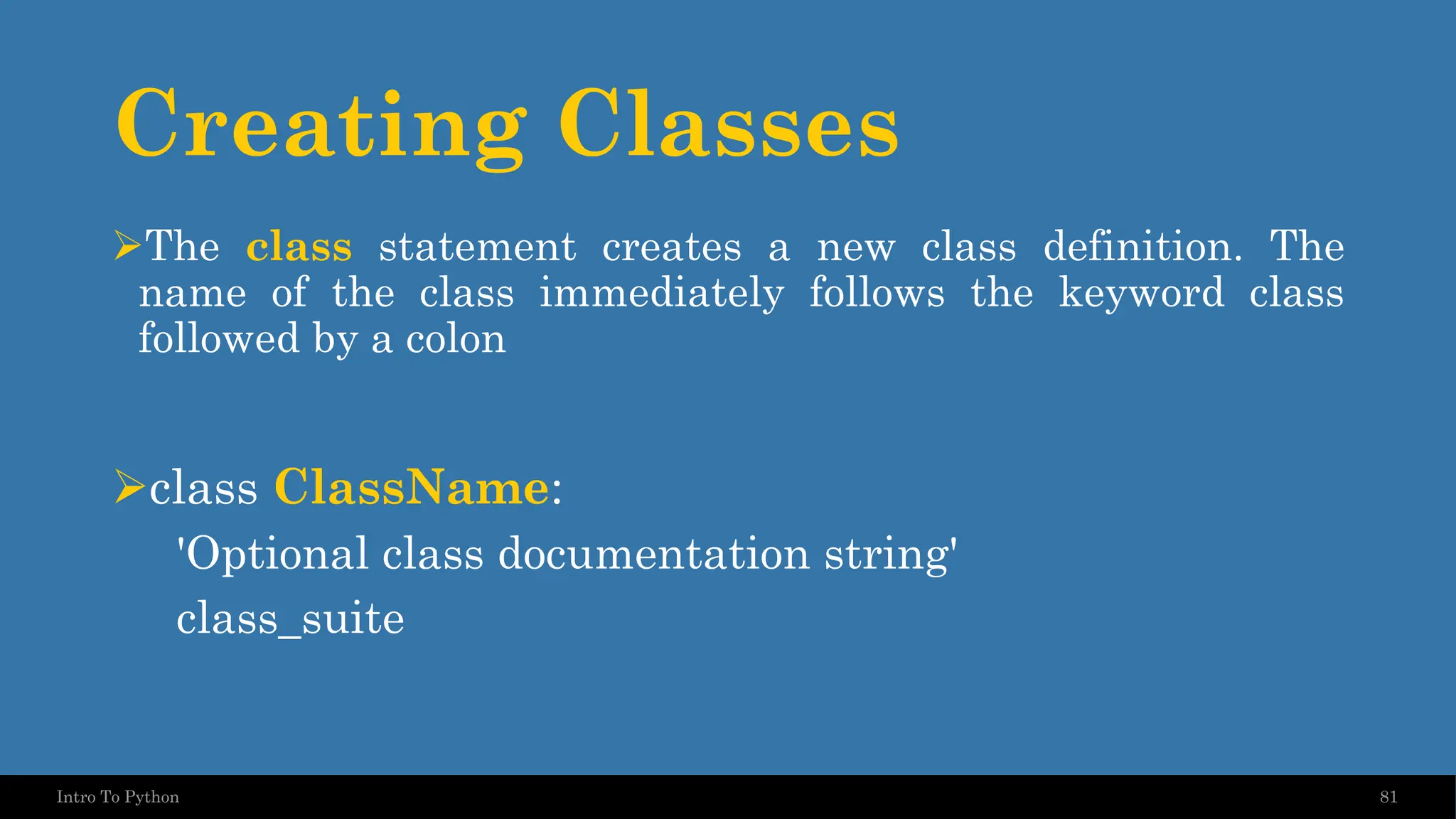
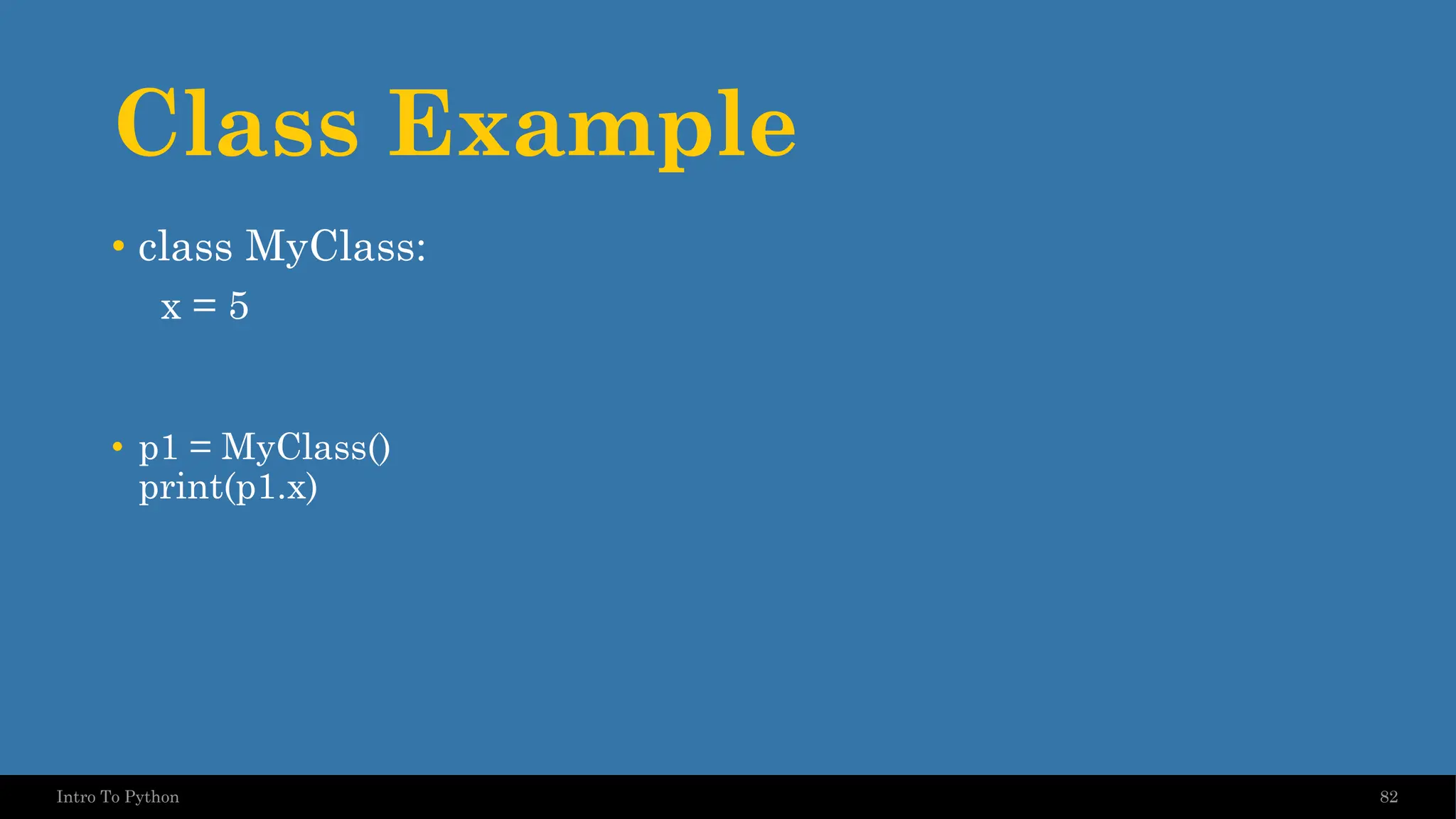
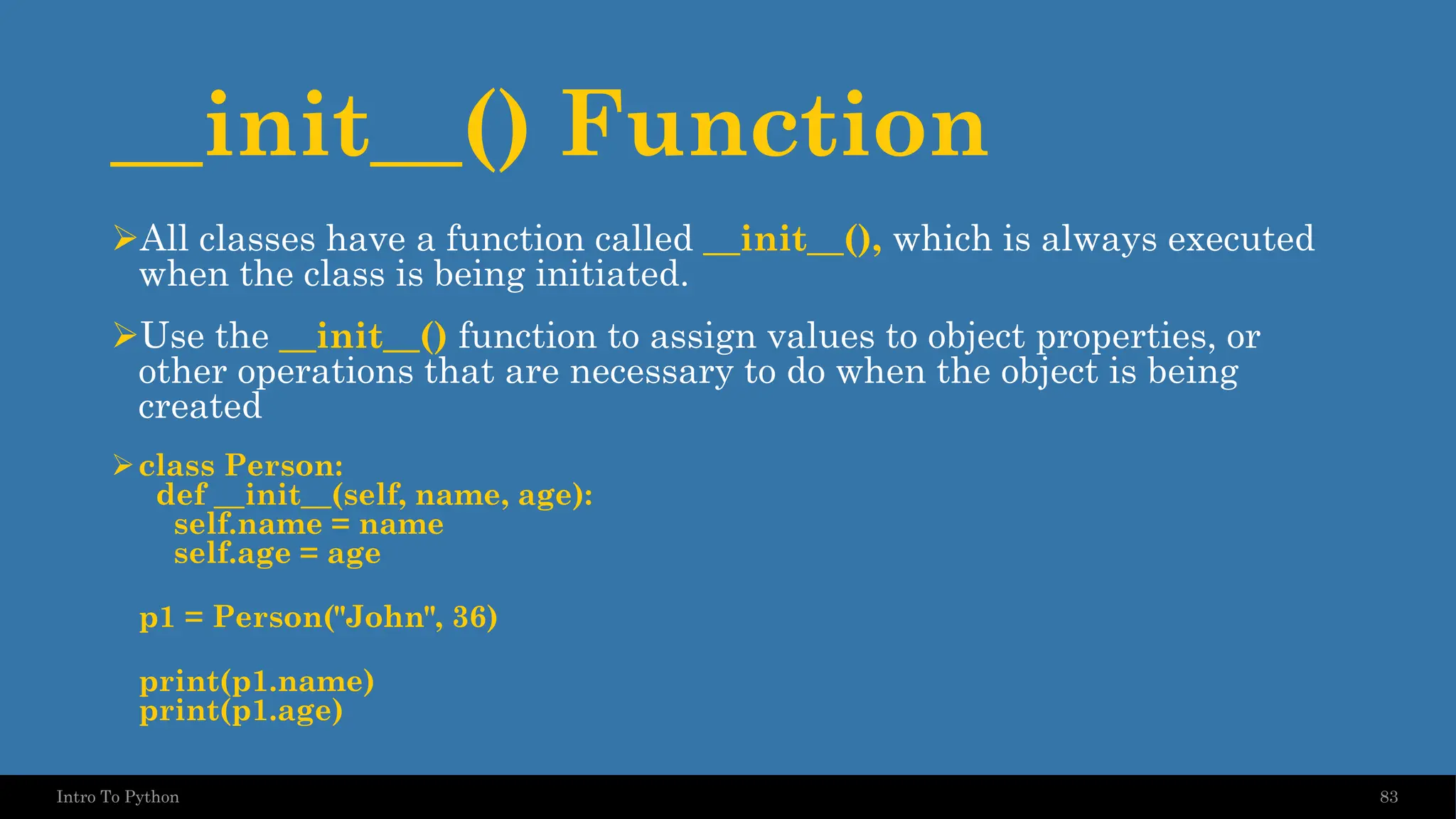
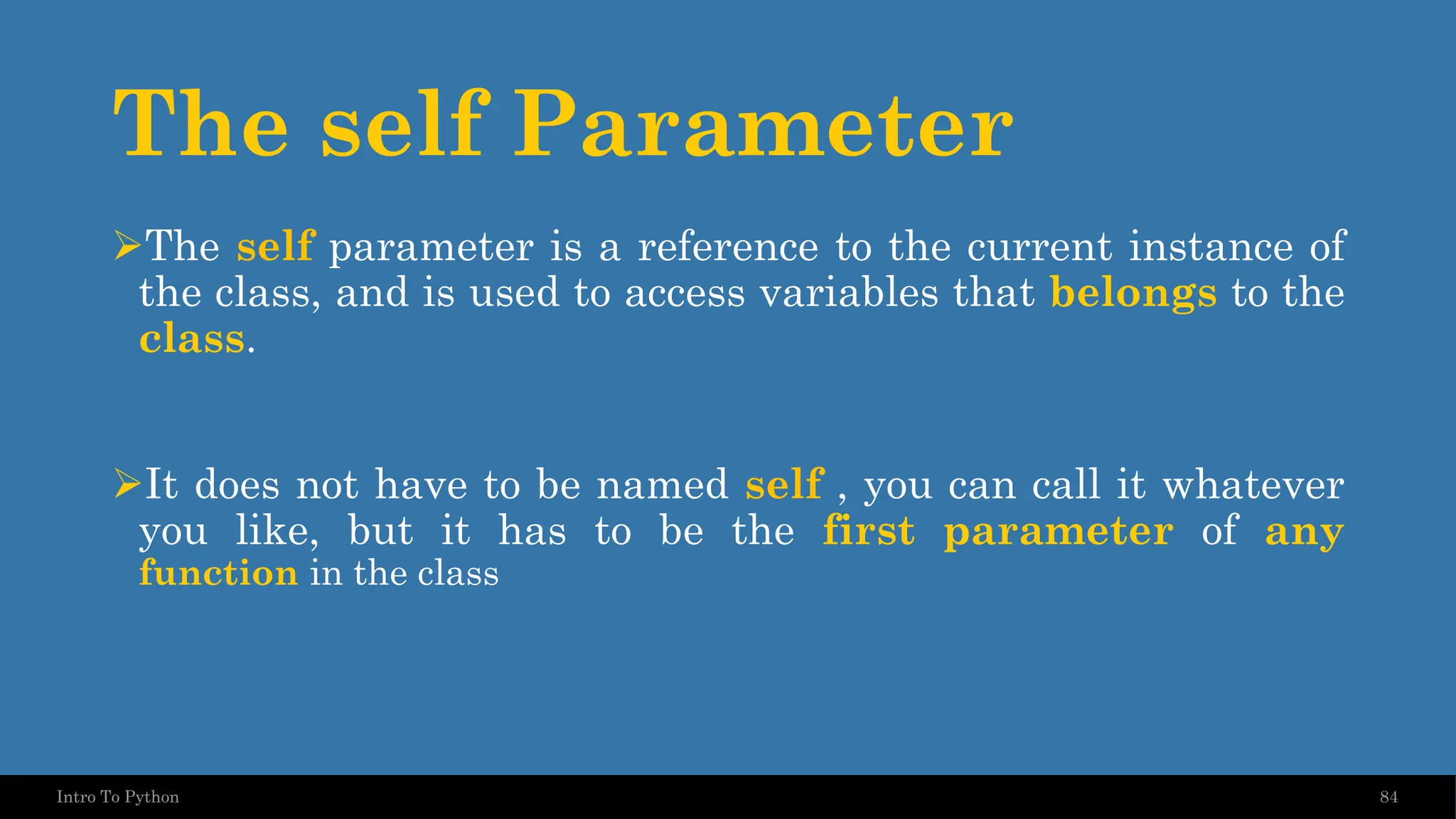
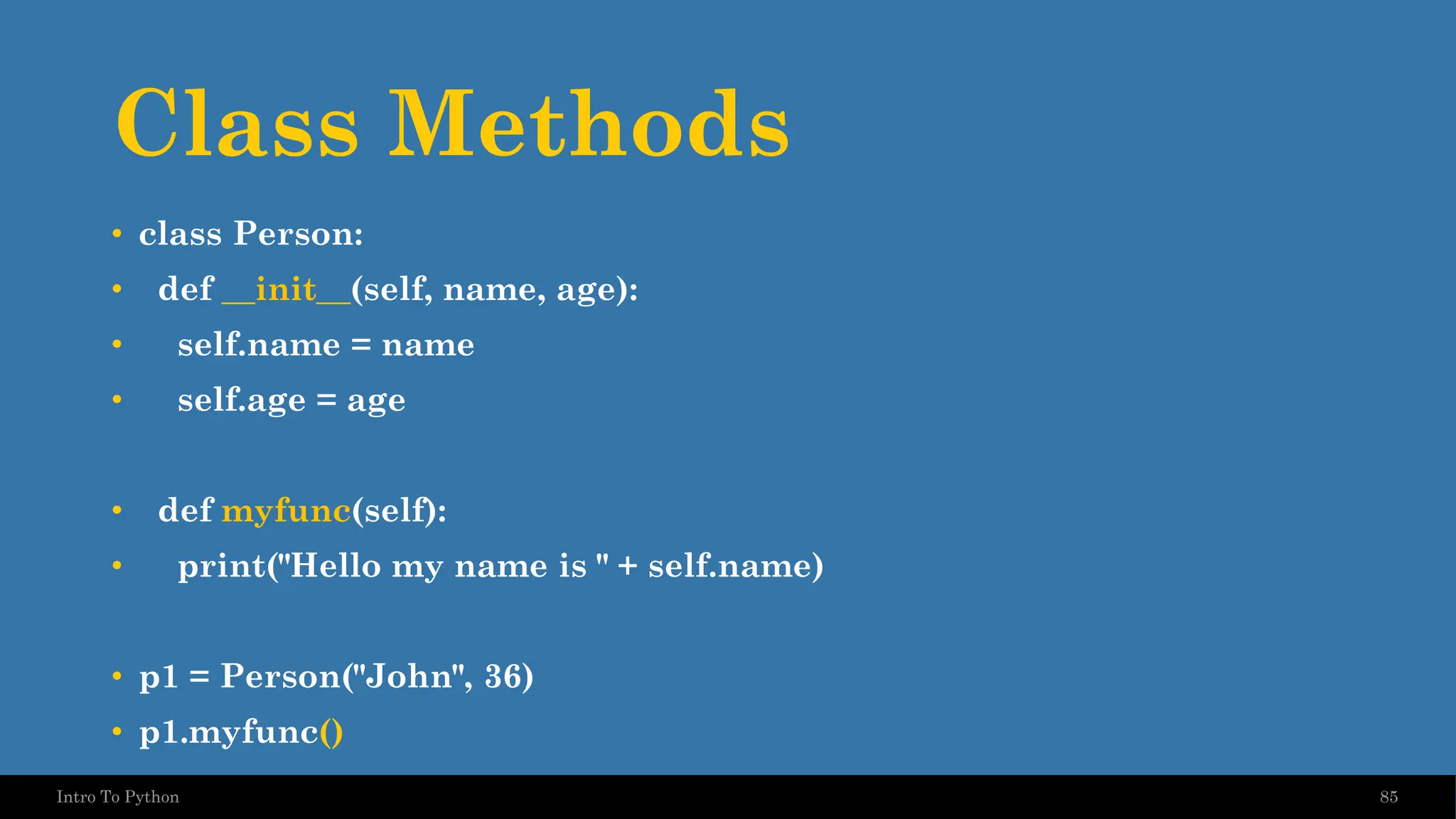
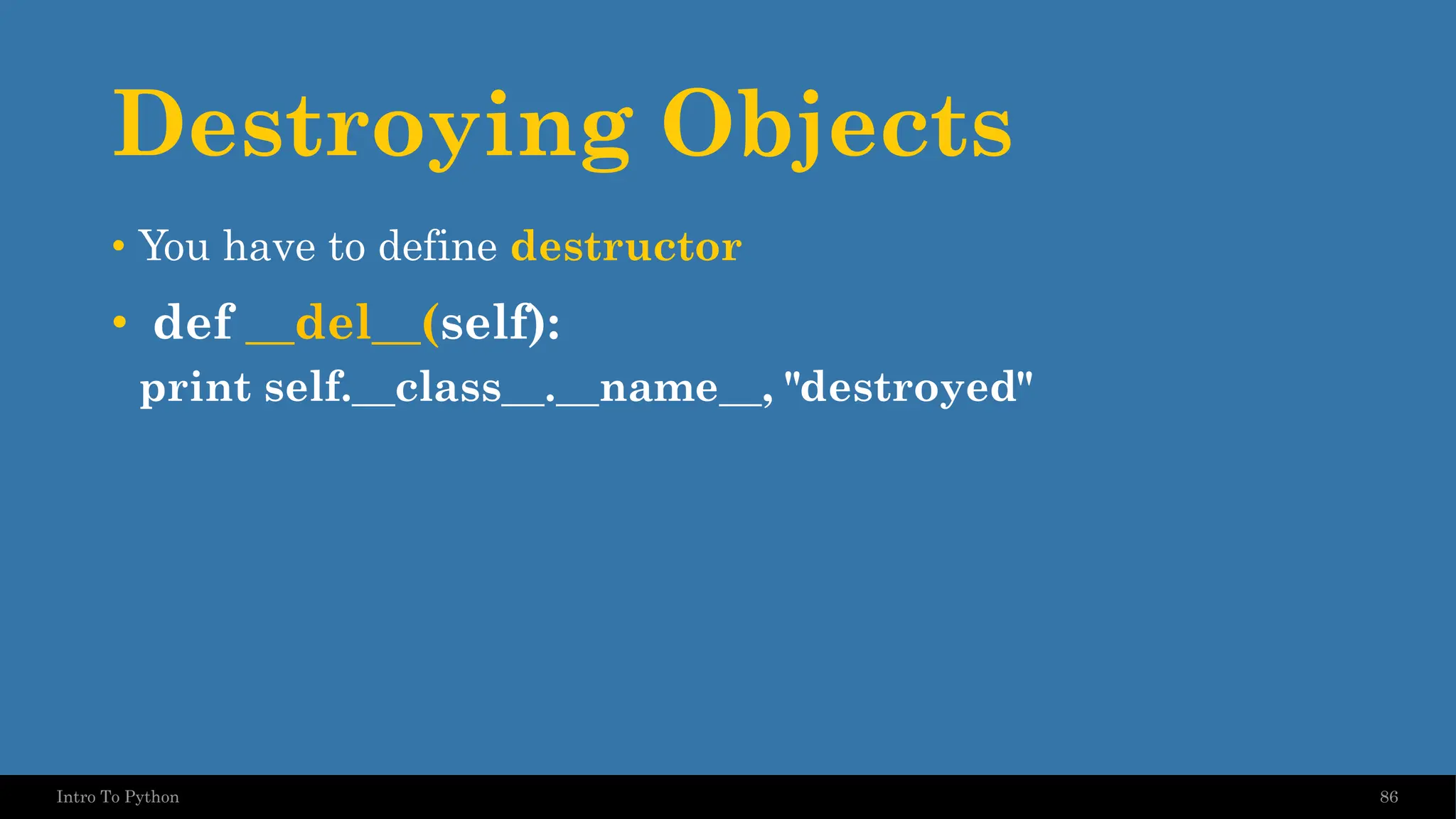
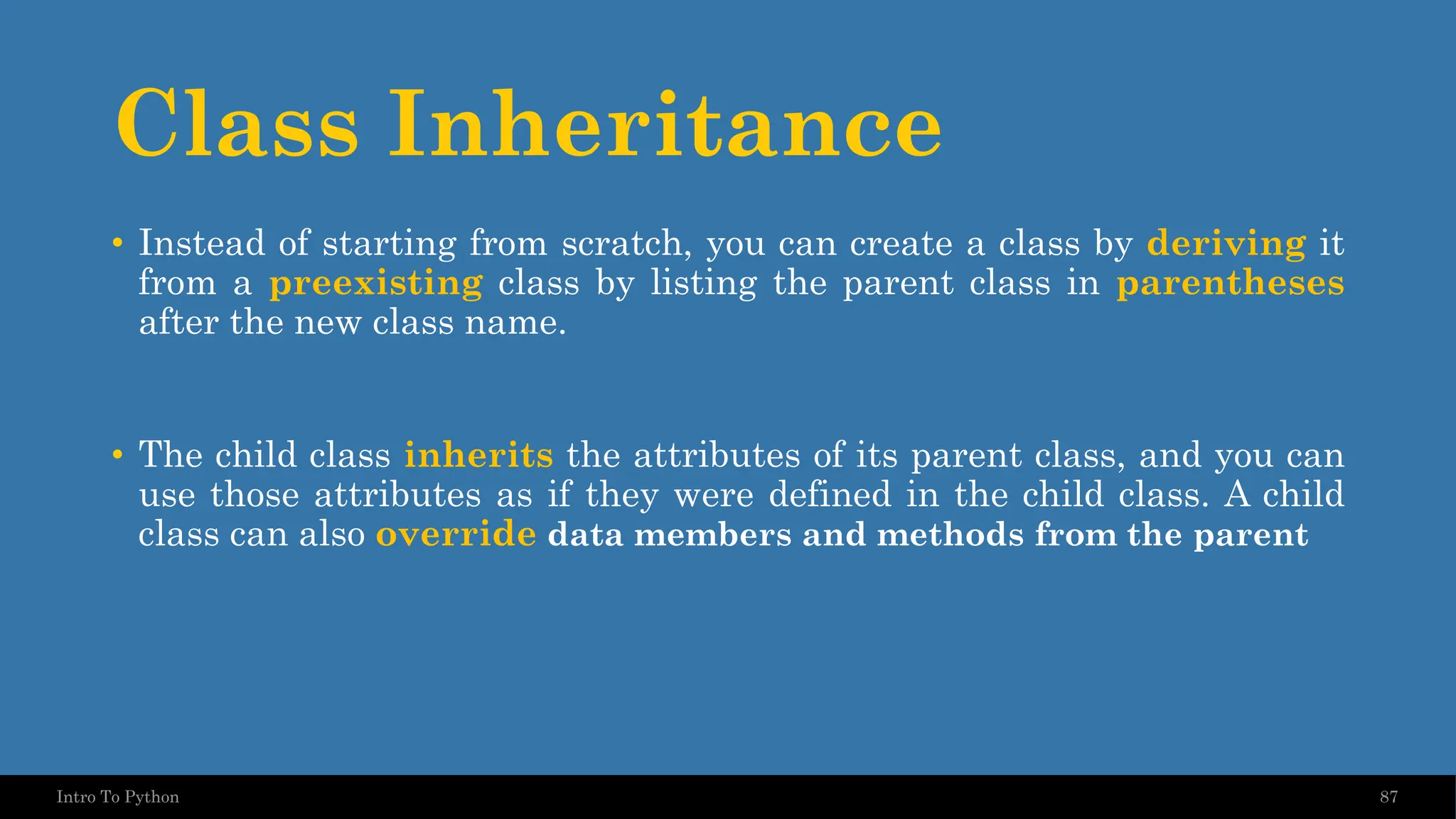
![Class Inheritance 88 Intro To Python • class SubClassName (ParentClass1[, ParentClass2, ...]): 'Optional class documentation string' class_suite](https://image.slidesharecdn.com/introduction-to-python-240806084550-ac80a512/75/Introduction-to-Python-print-datatype-pdf-88-2048.jpg)
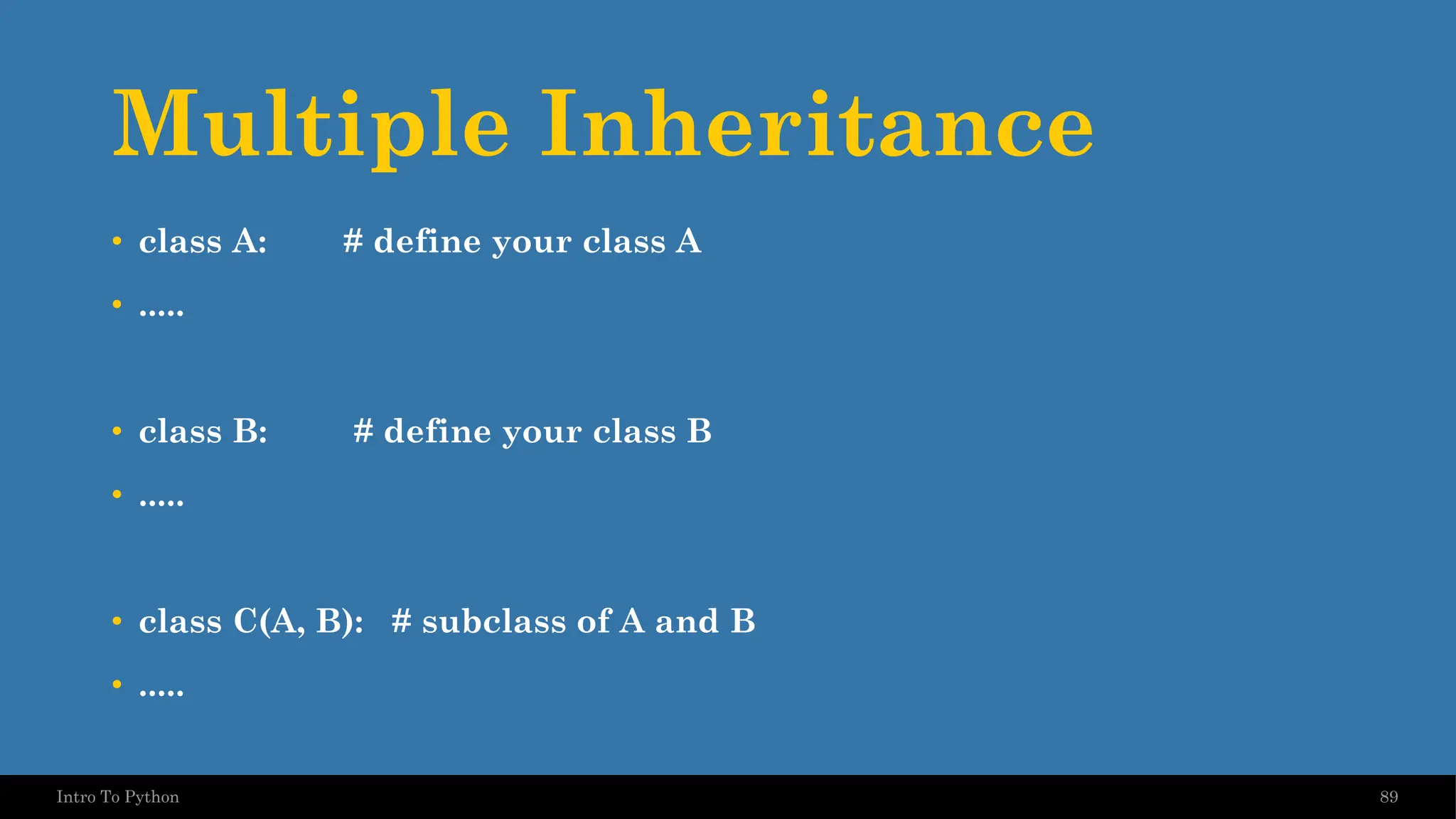
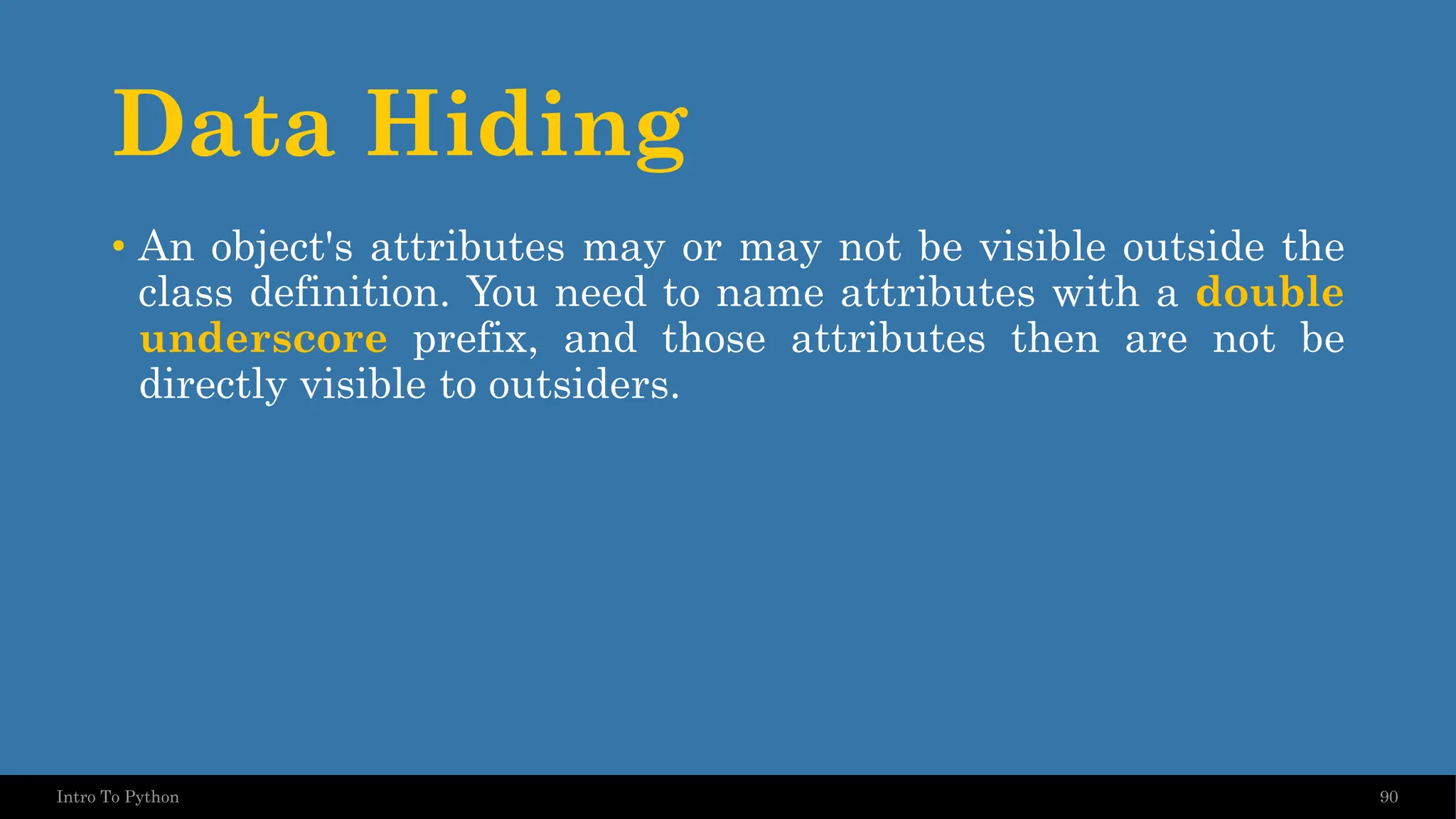
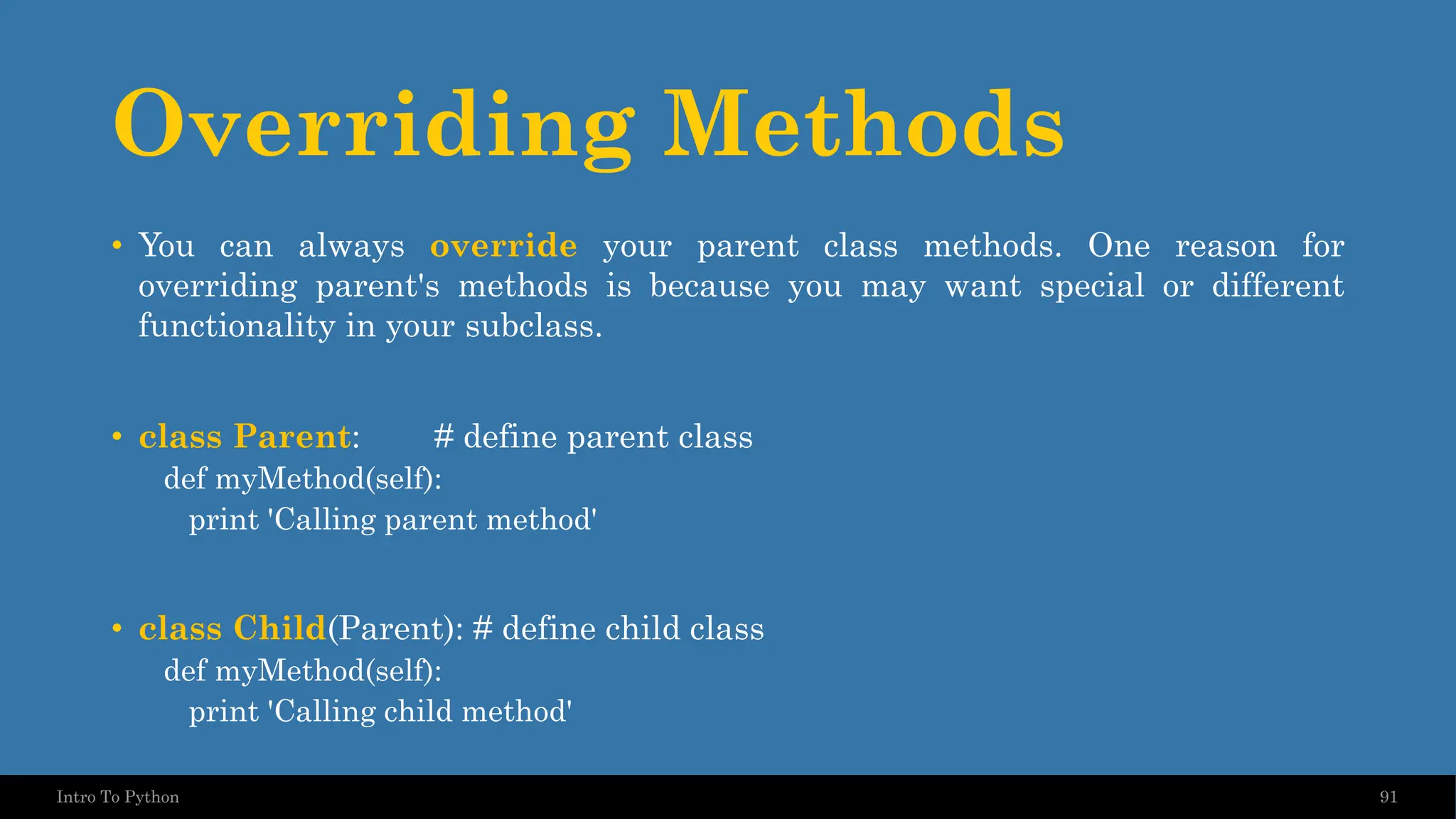
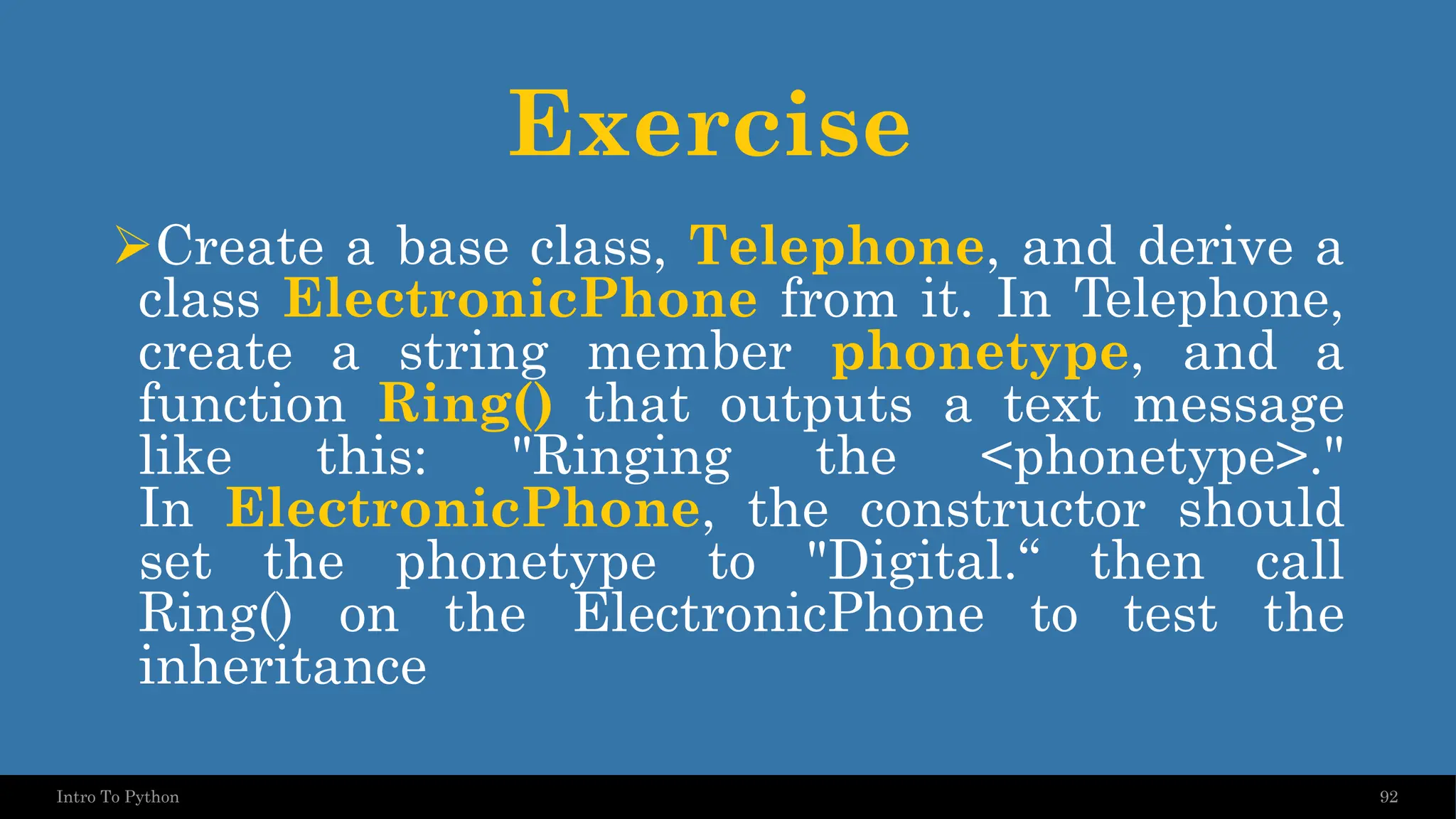
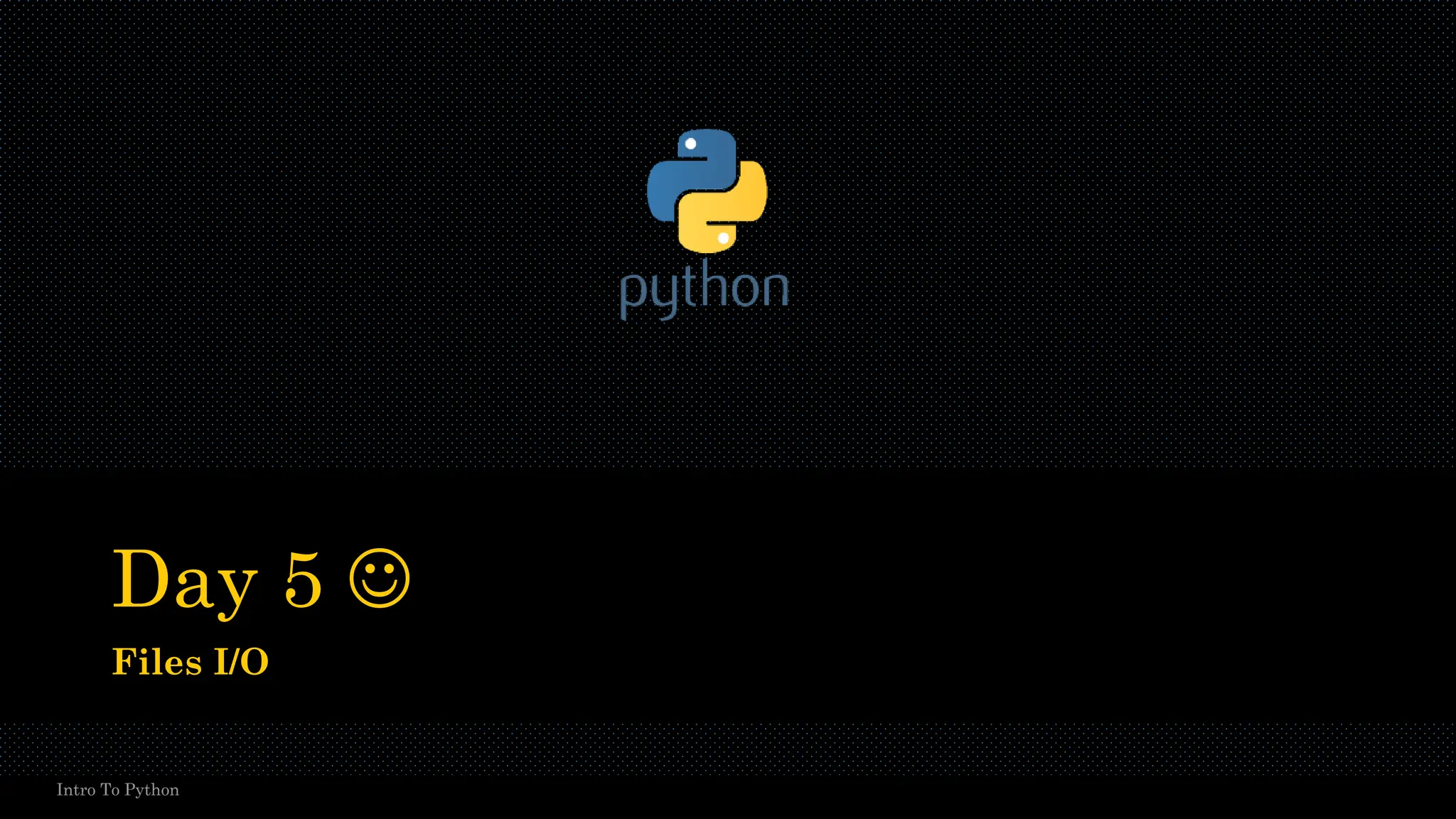
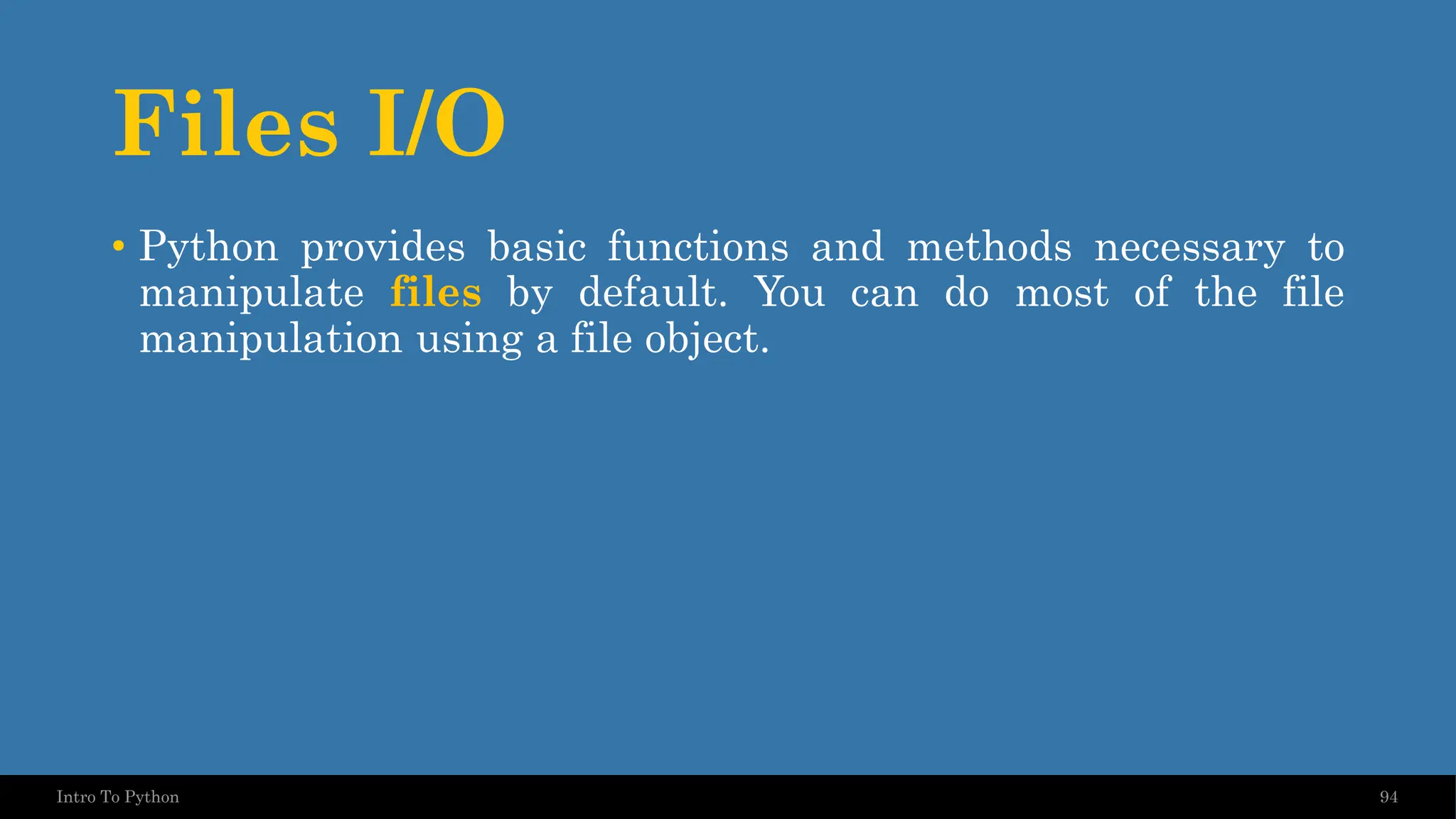
![Opening and Closing Files 95 Intro To Python • Before you can read or write a file, you have to open it using Python's built-in open() function. This function creates a file object, which would be utilized to call other support methods associated with it. • file object = open(file_name [, access_mode][, buffering])](https://image.slidesharecdn.com/introduction-to-python-240806084550-ac80a512/75/Introduction-to-Python-print-datatype-pdf-95-2048.jpg)
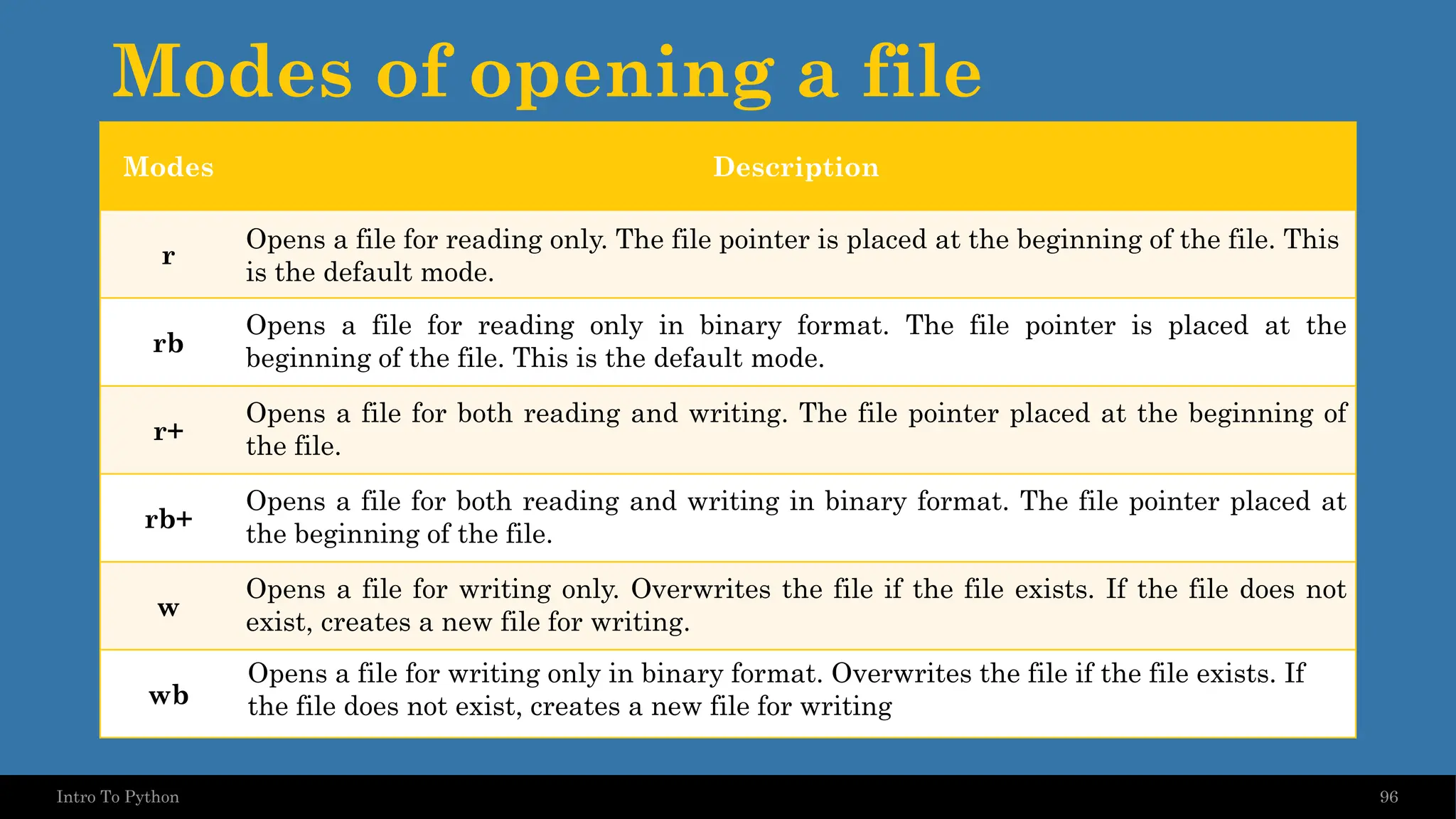
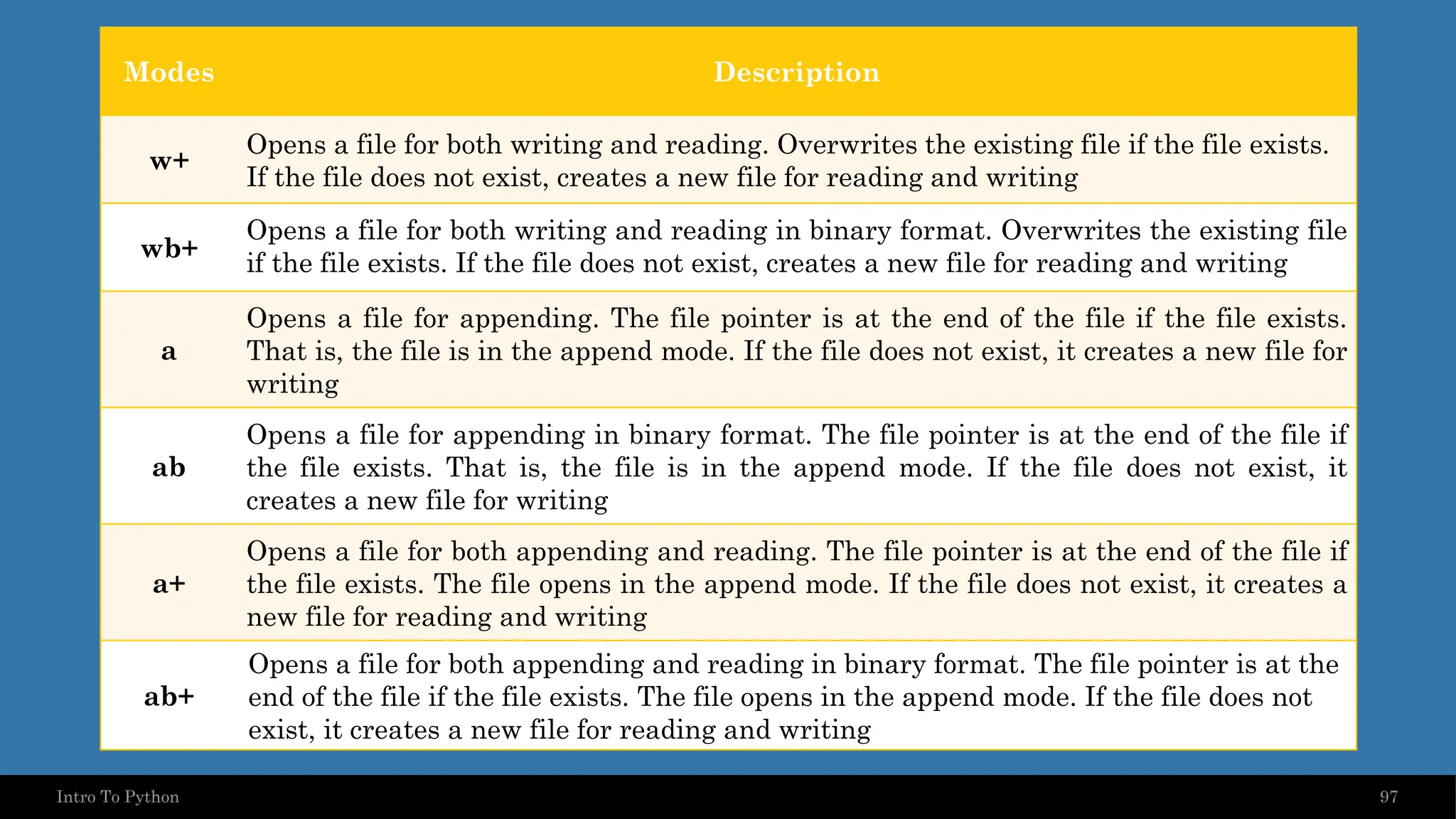
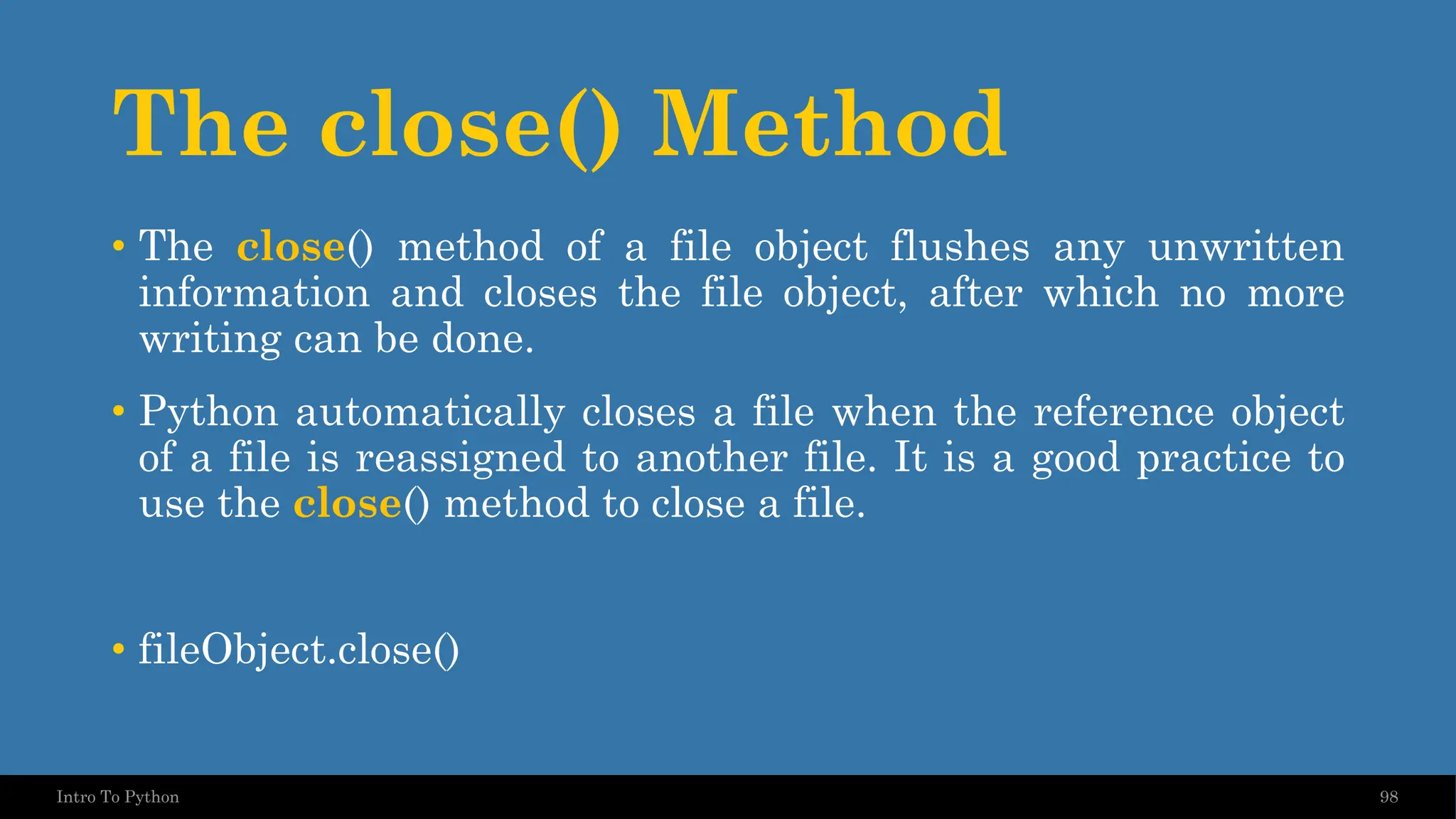
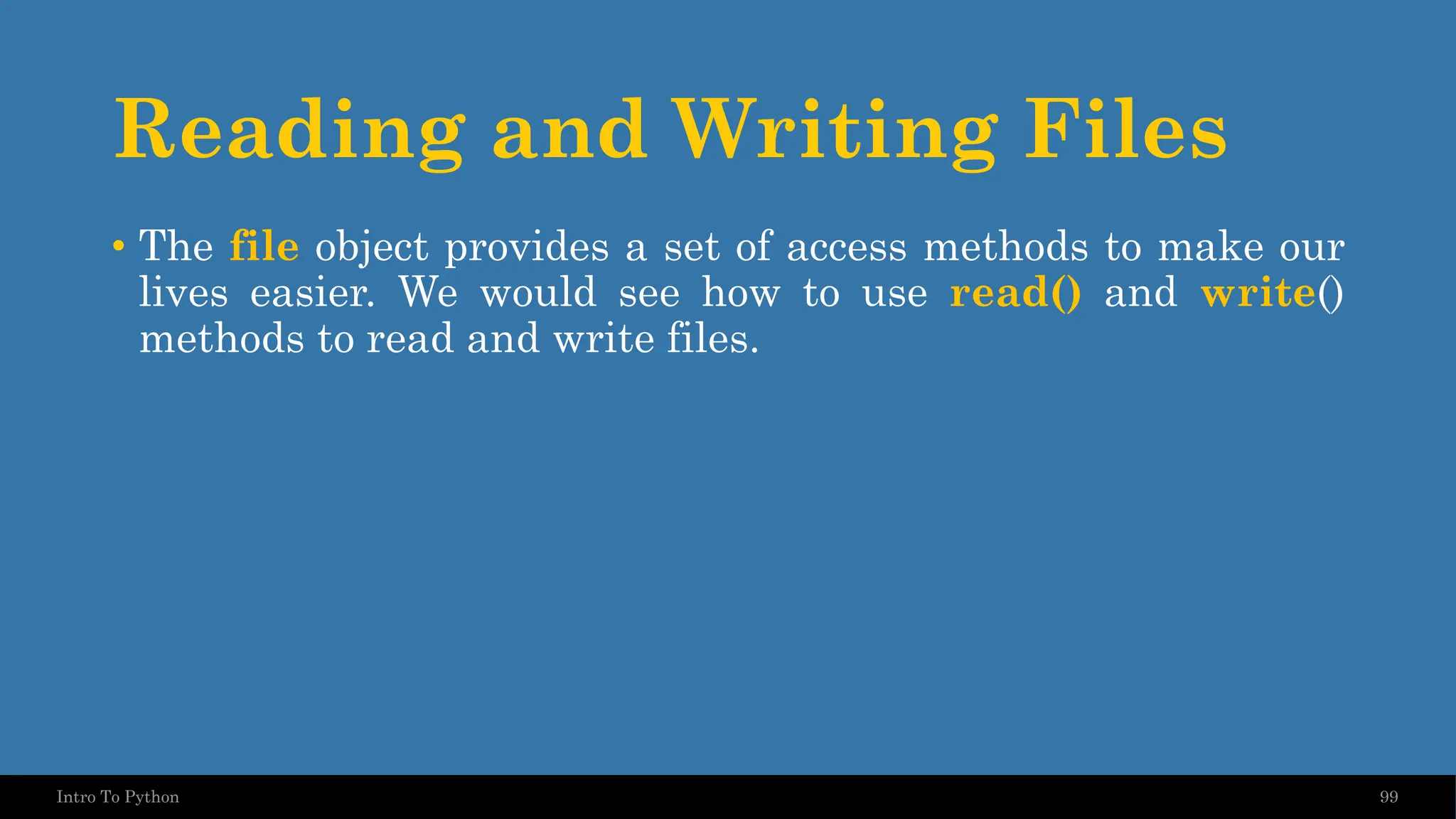
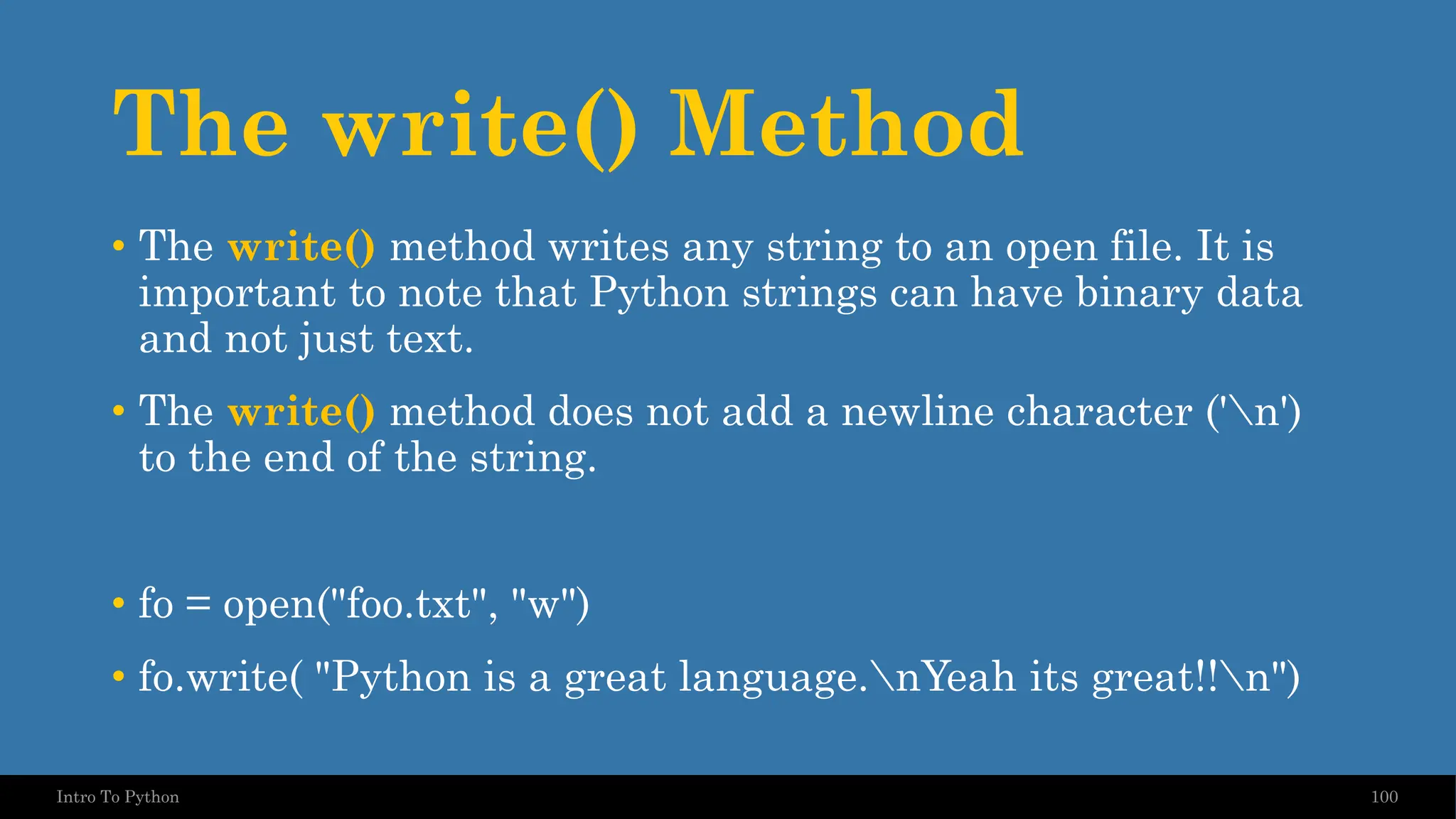
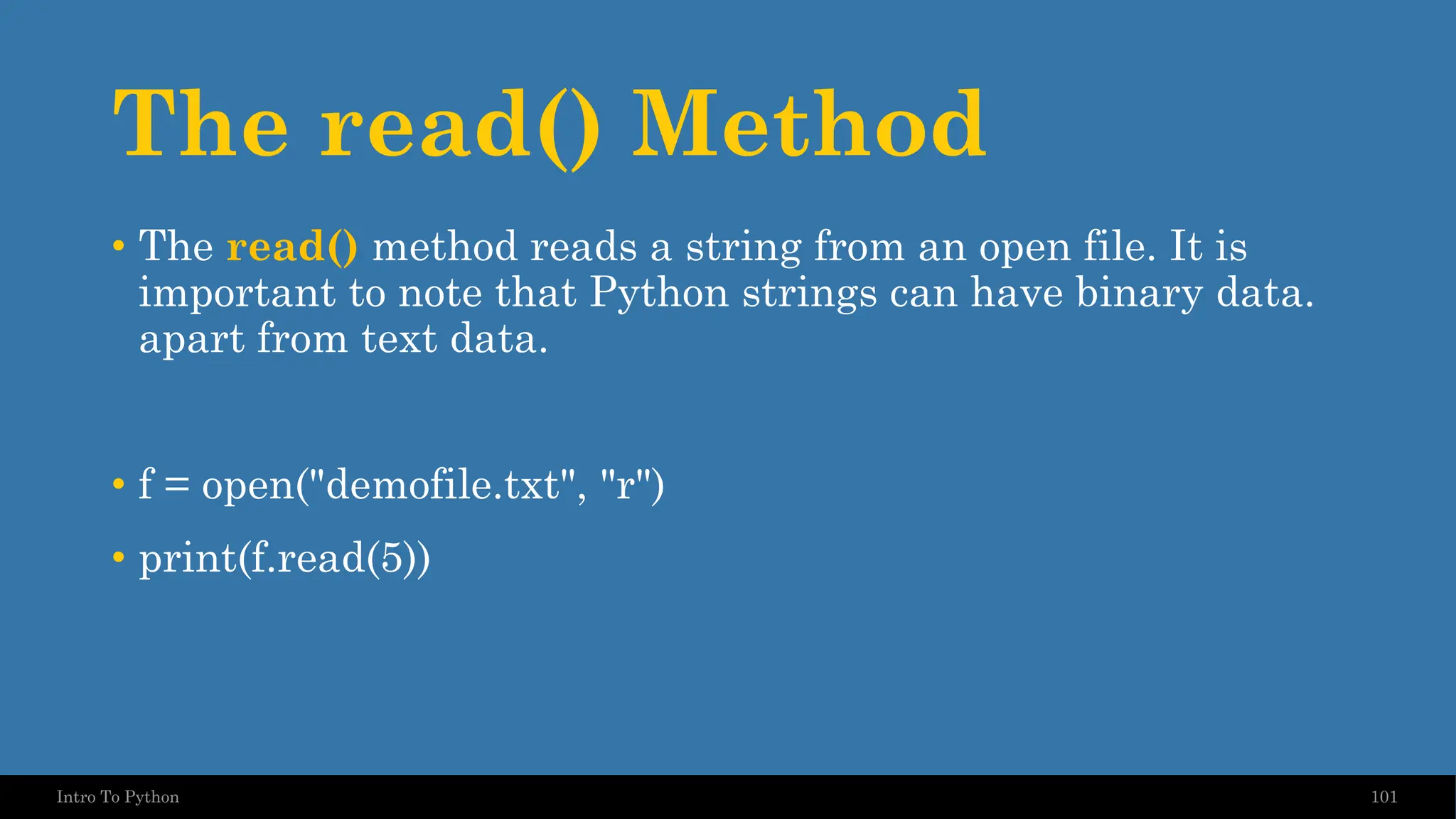
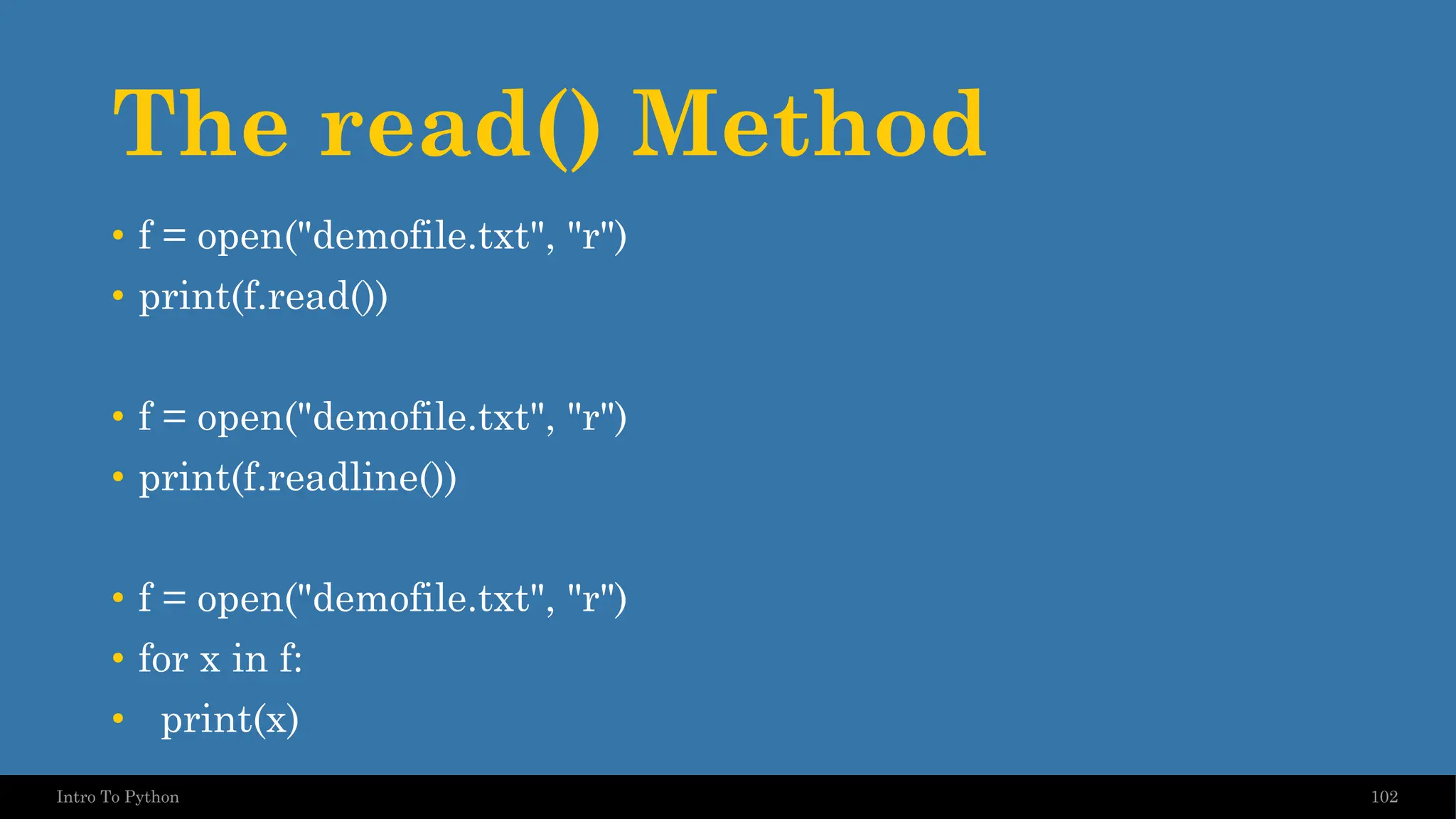
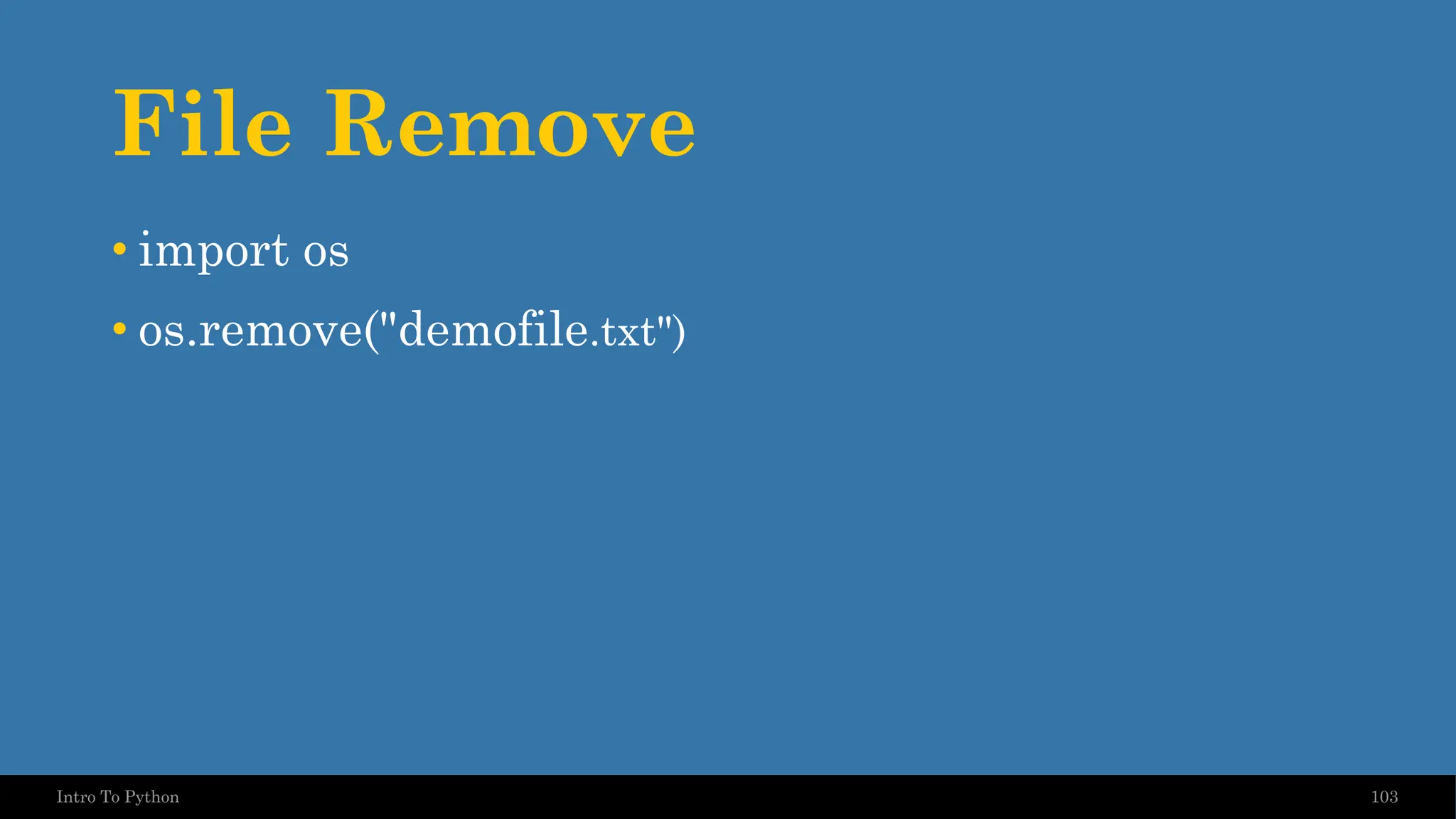
![File Positions 104 Intro To Python • The tell() method tells you the current position within the file; in other words, the next read or write will occur at that many bytes from the beginning of the file. • The seek(offset[, from]) method changes the current file position. The offset argument indicates the number of bytes to be moved. The from argument specifies the reference position from where the bytes are to be moved. • If from is set to 0, it means use the beginning of the file as the reference position and 1 means use the current position as the reference position and if it is set to 2 then the end of the file would be taken as the reference position.](https://image.slidesharecdn.com/introduction-to-python-240806084550-ac80a512/75/Introduction-to-Python-print-datatype-pdf-104-2048.jpg)
